- Search Please fill out this field.
- Manage Your Subscription
- Give a Gift Subscription
- Newsletters
- Sweepstakes
- Nature Travel

8 U.S. Canoe Trips That'll Transport You Into the American Wild
Paddle through these waters for wildlife sightings, stunning scenery, and more.
Evie Carrick is a writer and editor who’s lived in five countries and visited well over 50. She now splits her time between Colorado and Paris, ensuring she doesn't have to live without skiing or L'As du Fallafel.
:max_bytes(150000):strip_icc():format(webp)/evie-carrick-df91be43396540c492c4141c56a71a9e.jpg)
Editor’s Note: Travel might be complicated right now, but use our inspirational trip ideas to plan ahead for your next bucket list adventure.
You don’t have to strap on a giant backpack or hike 10 miles to get out into the wilderness — finding solitude can be as easy as loading up a canoe, pushing off, and dropping a line in the water. On a canoe trip, you need not worry about squeezing past others on a narrow trail or lugging around liters of water — everything you need is right in the boat with you.
These canoe trips take you from above the Alaskan Arctic Circle to the swamps of Georgia and are guaranteed to provide a much-needed reset (with a side of adventure). Plus, they’re all in the U.S., making it easy to find a nearby route that suits your style, whether it be braving rapids and overcoming grueling portages or sitting back with a line in the water and a beer in your hand.
1. Salmon River, Idaho
Also known as The River of No Return, the Salmon River takes boaters through 46 miles of recreational river trail, before reaching the 79-mile section of designated “wild” river. Canoers looking to take on the full 46-mile recreational route can put in at North Fork and take out at Corn Creek — a journey with tall canyon walls and some of the oldest known rocks in the state — or apply for a permit to venture into the “wild” section of the Salmon River.
2. Boundary Waters Canoe Area Wilderness, Minnesota
For a paddle that’s just as beautiful as it is remote, it’s hard to top the Boundary Waters Canoe Area Wilderness in northeast Minnesota. The wilderness area, which is composed of 1,500 miles of canoe routes over 19,000 acres and 1,100 bodies of water, is accessible primarily by canoe. Here in the deep north, boaters are rewarded with scenery that’s still wild and unparalleled solitude.
3. Northern Forest Canoe Trail, New York to Maine
This 740-mile trail starts in New York and ends in Maine, passing through Vermont, Quebec, and New Hampshire along the way. While there’s nothing like the satisfaction that comes from completing the entire stretch, you can take your pick of the route’s 23 rivers and streams, 59 ponds and lakes, and 65 portages to create your own shortened itinerary — whether it be a day trip or a long weekend excursion .
4. Noatak River, Alaska
If true isolation is at the top of your list, it doesn’t get much more remote than the Noatak River . Located above the Arctic Circle, this river route passes through a glacial valley, alpine tundra, deep canyons, and open plains. As you float this easy to moderate river, you can drop in a line or keep an eye out for Alaskan wildlife , including grizzly bears, caribou, and sheep.
5. Okefenokee National Wildlife Refuge, Georgia
If the cooler weather up north doesn’t sound appealing, consider a trip to Georgia, home of the Okefenokee National Wildlife Refuge . Heavily forested cypress swamps and “swamp prairies” offer two different takes on watery terrain that lure canoers looking for a multiday excursion in the South’s lush wilderness.
6. Green River, Utah
Utah’s Green River is a great choice if you’re a newbie to the canoeing world, or if you’ll be traveling with small children. The river is wide and mellow, with plenty of wildlife and scenery. You can drop in at Green River State Park and take out at Ruby Ranch two days later, or float all the way to the confluence of the Green and Colorado Rivers.
7. Buffalo National River, Arkansas
The beautiful Buffalo River passes through the Ozark Mountains and traverses alongside giant bluffs as it runs through quiet pools and tumbling rapids on its way to the White River. Once you reach the confluence, make sure to dip a toe to feel the distinction between the typically cooler White River and the warmer Buffalo waters. This trip can be as short as an afternoon paddle or as long as a multiday journey on the Buffalo River’s 153 miles — either way, you’ll want to keep your fishing gear on hand for the river’s renowned smallmouth bass fishing.
8. Tuolumne River, California
Thrill seekers will find their match on the Tuolumne River , which runs through deep gorges and forests on its way from the high Sierra Nevadas to the Central Valley. Along the way, you’ll be treated to wildlife sightings and excellent trout fishing as you navigate your way around Class IV rapids. Although the Tuolumne put-in is near Yosemite, the 149-mile body of water doesn’t have too much boating traffic, thanks to regulations on the number of trips permitted to launch each day.
Related Articles
FIELD & STREAM+
- Join 1871 Club
The 10 Best Canoe Trips in North America
Start planning your paddle through the most beautiful waters around the U.S. and Canada
By Ben Duchesney | Published Dec 26, 2019 8:00 PM EST

We may earn revenue from the products available on this page and participate in affiliate programs. Learn more ›
Everyone should spend a week paddling in a canoe, if not every year, at least once in their life. There’s no better way to get to know someone than being stuck in the same boat for days on end, and it’s been the boat of choice for hunters and anglers for centuries. There are paddling routes all across the world, and many in your backyard. Some will challenge you as a paddler, while others can help you and your family relax.
After a few trips under your belt you may end up falling in love with canoe tripping. You’ll know it’s too late if you find that your belt has been replaced by an NRS cam strap.
This is not a definitive list. There are too many gorgeous places to paddle and not enough time, but these North American canoe trips are a good place to start.

The Elements of a Great Canoe Trip
A canoe trip is flexible. You can float lazily down a river, chatting with your friends or you can suffer through a hellish portage in the snow for days on end. It can be whatever you want. I will say that a grueling portage helps to make a trip memorable. The same goes for tricky weather, exciting rapids, and killer fishing conditions. Oh, and bugs.
Tandem paddling and tough portages can bring you closer or make you start whacking each other with your paddle. Make sure your paddling crew works well together. Carry an extra paddle in each boat in case you break or lose your main paddle, and make sure everyone wears a life jacket. Explain the route carefully before you start so everyone knows what to expect.
Always make sure to have a warm, dry change of clothes when you get into camp. No matter how gnarly it gets on the water, a toasty pair of socks waiting for you at the end of the day can help you get through it. A big bag of trail mix (the kind with M&Ms!) in each boat helps too.
If you’re worried about navigating your route, or just want some help on the water, hire a guide or outfitter.

1. Northern Forest Canoe Trail, New England
A group of friends and I paddled the first two sections of the Northern Forest Canoe Trail (NFCT) a few years back and I’ve been itching to go back to complete the rest. I’ve also paddled section 12, the famous Allagash River, in Maine. The beauty of the NFCT is that I can keep picking these trips off section by section, or choose to paddle all thirteen sections at once to cover the entire 740 mile route like an AT thru-hiker. The trail starts in Old Forge, NY and finishes in Fort Kent, Maine. The NFCT covers 23 rivers and streams, 59 lakes and ponds, and 65 portages (a little more than 70 miles) and is the longest inland water trail in the United States. This is as classic as canoe country paddling gets, with the trail following traditional Native American travel routes.
2. Boundary Waters Canoe Area Wilderness, Minnesota
More classic canoe country, the Boundary Waters Canoe Area Wilderness has over 1,200 miles of paddling routes. At 1 million acres in size, you can spend a month in the backcountry of northeastern Minnesota and still barely scratch the surface. There are thousands of lakes and streams and you can spend your nights at one of over 2,000 designated campsites. Bring smores, you’ll want to watch the stars all night long.
3. Okefenokee National Wildlife Refuge, Georgia
A canoe can be just as at home down in the swamp as in the North Woods. Paddle through the black swamp waters of Georgia’s Okefenokee National Wildlife Refuge to watch colorful birds and curious alligators. A photographer friend, Chris Funk, has been telling me to paddle the Okefenokee for years. “It’s a place that is so wild; man tried to tame it and failed,” he says. “The beauty of that place burns deep in the hearts of the folks that visit those black waters.”
4. Buffalo National River, Arkansas
The standout character of my time on the Buffalo National River in the beautiful Ozark region of Arkansas was the smallmouth bass. Even the smallest bass I caught that week were feisty as hell and brilliantly colored. There are many route options for paddlers looking for a multi-day float, with a total of 132 river miles beginning in the town of Ponca. Head there for the fishing, but make sure to enjoy the tall bluffs on this scenic river.
5. Green River, Utah
If north country whitewater or alligator swamps aren’t your speed, paddle one of the best flatwater routes in the country on the Green River in Utah. Start in the town of Green River Utah and paddle 120 miles to the confluence of the Colorado River. Most people can complete the trip in 3-5 days, but make sure to plan time to hike the surrounding country. The giant rock formations of Labyrinth and Stillwater Canyons will keep you awestruck.
6. Tuolumne River, California
Designated a Wild & Scenic river in 1984, California’s Tuolumne River starts in the High Sierra mountains and runs for 62 miles before it enters the Stanislaus National Forest. Besides the gorgeous views, like lush meadows between glacially carved canyons, there is also a chance for serious paddlers to test their skill. Starting From Lumsden Bridge to Wards Ferry a series of tricky rapids run one after another for 18 miles. If you’d rather run it than portage it, this may be the route for you.
7. Noatak River, Alaska
On a list of the best canoe trips in North America, of course you have to include one within the largest undisturbed watershed on the continent: the Noatak River in Alaska. You have almost 400 miles of river to plan your route on, but if you’re going to paddle the whole thing (why not, right?) a good place to put in is Kotzebue. There’s also the option to split it up and come back again year after year. It is after all a clear, arctic river with serious fishing and great wildlife, like bear, sheep, caribou, and musk ox.
8. Wabakimi Provincial Park, Ontario
With over 2,000 kilometers (1,200 miles) of some of the best wilderness canoeing routes in the world, Wabakimi Provincial Park must be explored over a lifetime. You just have to keep going back. There’s plenty of action for whitewater paddlers, chances to explore the park’s long cultural history of Indigenous communities, and of course the fishing. Fly-in lodges put their clients on giant walleye and northern pike, but spending a week (or more) there in a canoe means you’ll have first dibs at all the best spots.
9. Nahanni River, Northwest Territories
Spend two weeks in the backcountry of Canada’s Northwest Territories on the classic Nahanni River. This river features Virginia Falls, a waterfall nearly twice the height of Niagara Falls. It also takes paddlers through some of Canada’s deepest river canyons, leads them past hot springs and other unique geological features. This river is so legendary that the United Nations declared the Nahanni River first World Heritage Site in 1978.
10. The Bowron Lakes Circuit, British Columbia
Paddle along the western slopes of the Cariboo Mountain Range in Bowron Lake Provincial Park. The Bowron Lake Canoe Circuit is world-renowned among paddlers, connecting 116 kilometers (72 miles) of lakes, waterways, and portages through the wilderness. You can spend 10 days paddling the whole circuit, or just paddle 2 to 4 days on the west side of the circuit.
Remember, sometimes the portages between each lake are the best part, at least they are later when you’re talking about them to your coworkers back in the real world.
- Skip to primary navigation
- Skip to main content
- Skip to primary sidebar
- Skip to footer
Green Global Travel
World's largest independently owned Ecotourism / Green Travel / Sustainable Travel / Animal & Wildlife Conservation site. We share transformative Responsible Travel, Sustainable Living & Going Green Tips that make a positive impact.
The 10 Best Canoe Trips (For Your World Travel Bucket List)
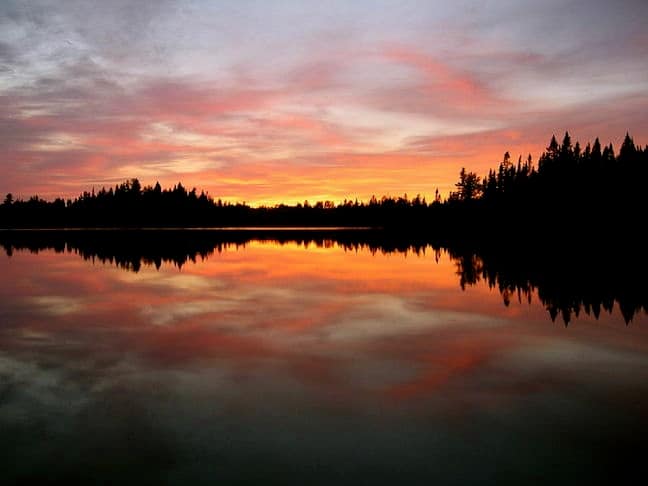
Disclaimer: This post may contain affiliate links. All hosted affiliate links follow our editorial policies .
Mention the word “paddle” to most people and you may get references to “being up the creek without one,” the movie Deliverance , or corporal punishment handed out at Catholic schools in their childhood.
But when I hear the word “paddle,” it immediately conjures up indelible images from my favorite canoe trips around the world.
It brings up warm memories of mist coming off the shore at dawn. The calls of a loon or howler monkey reverberating throughout the surrounding wilderness.
The only human-made sound the “swish-plop” of a paddle as you propel your canoe (or kayak) along the river or across the lake.
It was paddling that introduced me to my first real travel adventure several decades ago in Ontario’s Haliburton Highlands. And, truth be told, I’ve been totally hooked on the hobby ever since.
These are my personal picks for the 10 Best Canoe Trips in the World, and I feel like I’ve barely touched the tip of the iceberg …
READ MORE: The Best Beach Gear & Lake Gear for Summer
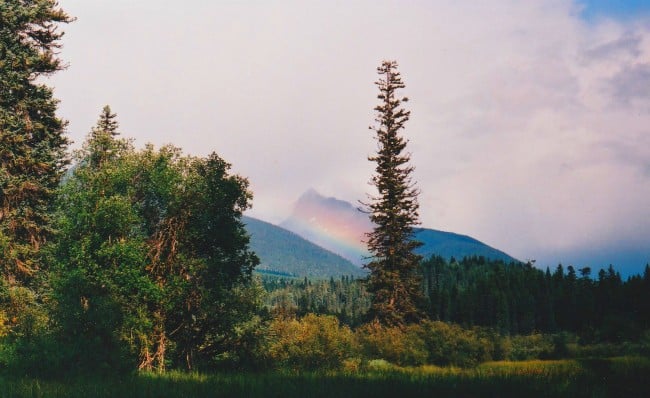
Bowron Lakes (British Columbia)
I used Bowron Lakes Provincial Park ‘s wilderness canoe circuit as a “relationship litmus test” the first summer I was dating a girl.
I figured if we were still speaking after a 4-day canoe trip, it would be a good sign. More than 25 years later, we’re still paddling together!
Set in the Cariboo Mountains of central B.C. amid gorgeous scenery, this 72-mile long, rectangular circuit of lakes and rivers is a great one for beginners.
The Cariboo River can be a bit tricky in spots . B ut if you pay attention it shouldn’t cause any grief, as there’s no whitewater.
All the lakeshore campsites include bear caches for food. There are n’ t too many portages, and you can rent wheels that attach to the bottom of your canoe and roll it down the trails, which include boardwalks along rough, boggy sections.
We paddled it in 4.5 days, but you might want to allow a week for maximum enjoyment of the surrounding scenery.
READ MORE: 10 Best Mountains in the World (World Travel Bucket List)

Everglades National Park (Florida)
Although a good portion of Everglades National Park is swampland, there is a section that offers a different kind of paddling.
In the Ten Thousand Islands, you can kayak in and around a series of small islands on the Gulf of Mexico, camping, soaking up the sun and watching the wildlife that lives there.
During a trip there, I was lucky enough to see a rookery of young herons being fed by adults and watched a dolphin swim under my kayak and breach the surface right behind me. I also observed two ospreys in an aerial battle, and fought to keep the island’s persistent raccoons from stealing food right out of our kayaks!
The sunsets in the Everglades can be spectacular. I’ll never forget watching it set on the ocean at one end, while seeing the silhouette of a cruise ship far off in the distance at the other.
But it can be easy to get lost in the myriad canals and tributaries here. So it’s best to travel with a guide from a reputable tour company.
READ MORE: List of US National Parks by State (An EPIC Guide)
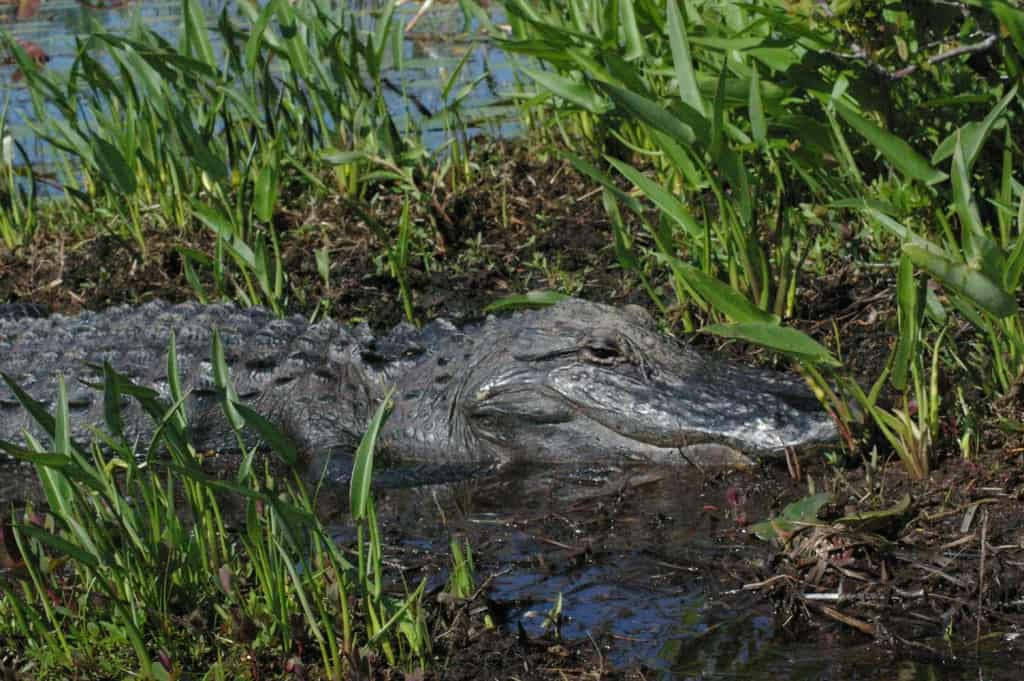
Okefenokee National Wildlife Refuge (Georgia)
Referred to as “the swamp” by locals, Okefenokee National Park is another great place to see wildlife.. . as long as you don’t mind keeping company with alligators.
There are a lot of alligators in the swamp. You can see them sunbathing on hummocks of swamp grass or even swimming underneath the wooden platforms you have to camp on . They generally don’t bother anybody unless you get too close.
But gators aren’t the only wildlife you’ll likely see there: Black bears call the Okefenokee home, as do white-tail deer, ospreys, herons, woodpeckers, hawks, and sandhill cranes.
Although you can paddle your own canoe or kayak through here– and many locals do– your best bet is to book an experienced outfitter to keep from getting lost.
Several outfitters guide day trips , but there are only a few that lead overnight canoeing and/or kayaking adventures.
READ MORE: The Top 5 Ecotourism Attractions in North Georgia

Belize Barrier Reef (Belize)
Belize offers novice kayakers a great opportunity to enjoy paddling, sun, sand, snorkeling and culture. This was where my first kayak trip took place after years of paddling a canoe, and it was a great experience.
During the 5-day trip, we camped on three different islands. The first was a nameless mangrove island. which I dubbed “Crab Cay” because of all the hermit crabs roaming around.
The next was a larger island named Laughingbird Cay. Lastly, there was a group of islands known as the Silk Cays, which are just a short paddle away from the Belize Barrier Reef (the second largest reef in the world, and a UNESCO World Heritage Site) .
The snorkeling and Scuba diving there is fantastic, with all kinds of cool coral and multitudes of exotic-looking fish, including reef squid and the occasional barracuda. You may even be lucky enough to see a spotted ray, or perhaps a harmless reef shark.
Our base camp was near Placencia, a center of Garifuna culture , which features a conch-shell sidewalk and a bar/post office to visit before or after your kayak trip.
READ MORE: Scuba Diving the Belize Barrier Reef
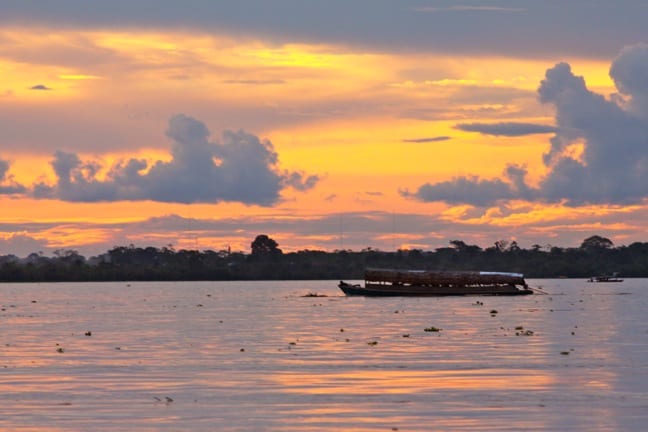
The Amazon (South America)
There’s still debate about what river is the world’s longest, but South America’s Amazon River is the largest in terms of total discharge.
While it is threatened by logging and other business interests, the Amazon still encompasses the world’s largest continuous cover of tropical rainforest.
Though I haven’t paddled on the actual Amazon, I did a canoe trip in a section of the Ecuadorian Amazon known as the Orienté, on a tributary called Rio Shiripuno.
Although wildlife abounds there, seeing it in the jungle is not easy. Still, we did see a caiman, several parrots, toucans, a harpy eagle and tracks of what looked like a jaguar along the muddy banks of the river.
The 5-day trip was led by Moi, chief of the Huaorani, the indigenous people on whose land we camped each night as part of our journey. And there’s nothing quite like the sound of a howler monkey waking you up for a pre-dawn photo excursion.
READ MORE: Cruising the Peruvian Amazon

Boundary Waters Canoe Area (Minnesota)
Located on the border of northeastern Minnesota and the southwest border of northwestern Ontario, the Boundary Waters Canoe Area is considered the canoe mecca of North America.
Consisting of thousands of lakes, rivers, marshes and woodlands, and home to all the diverse wildlife that lives in the boreal forest, it has been on my bucket list for years.
Part of the park’s northern boundary borders on Ontario’s Quetico Provincial Park , creating a huge international reserve of pristine wilderness that’s accessible from either country.
It’s very similar to the way that Glacier National Park and Waterton National Park meet on the Montana-Alberta border. This makes it an excellent area for paddlers to explore.
READ MORE: Hiking Glacier National Park

Okavango Delta (Botswana)
If you’re an avid paddler, but want to experience the wild adventure of an African safari , this canoe trip is the answer to your prayers.
The Okavango Delta is the largest inland delta in the world. Most river deltas lead to the open sea, or at least a large lake. But the Okavango River empties onto open land and floods the savannah.
The area is home to several highly endangered species, including cheetahs, white and black rhinos, and African wild dogs… which is probably why it’s a protected UNESCO World Heritage Site .
There are plenty of eco lodges and traditional safaris available for visitors to enjoy in this area. Some even offer native-powered dugout canoe rides through portions of the wetland.
READ MORE: What Is An Eco Lodge? (Top 10 Eco Lodges in the World)
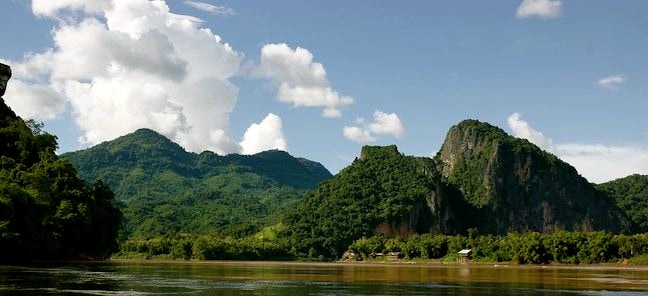
Mekong River (Southeast Asia)
If you want to “kayak like Kurtz,” the Mekong River is your best bet for trying to channel your inner Marlon Brando.
While the Mekong River is not the Nung, Asia’s seventh longest river does wind through six countries– Vietnam, Cambodia, Laos, Myanmar, Thailand and China.
You can paddle past ancient temples, and many villages unchanged by the centuries. You can also paddle on Ha Long Bay and visit Cambodia’s Angkor Wat, another UNESCO World Heritage Site .
While there is plenty to do on a trip like this, you probably won’t run across any surfers playing “Ride of the Valkyries.” And you definitely don’t want to shoot any tigers. Just be careful about stepping out of the boat without your guide!
READ MORE: 10 Most Threatened Rivers in the World
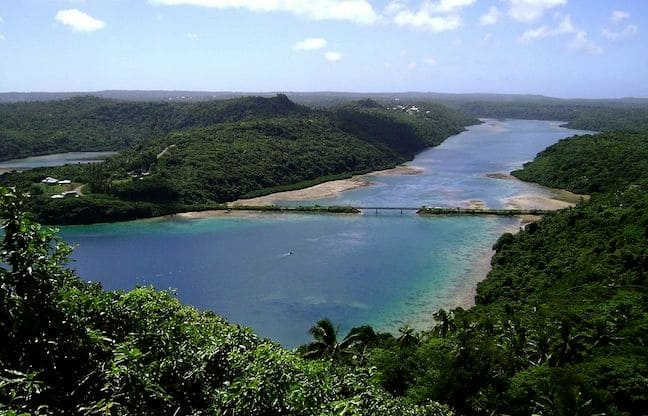
Vava’u Islands (Tonga)
This is another kayak trip that’s been on my bucket list for a while now.
Dreams of Vava’u ‘s crystal clear waters, sparkling sand beaches and hidden marine caves, combined with the chance of seeing whales and dolphins while plying the warm South Pacific waters, tug at my spray skirt in an enticing manner.
Then there’s the rich traditional Polynesian culture , with umu feasts and hula dancing on the beach as the sun goes down.
If that’s not enough, there’s excellent snorkeling on all of the islands you visit . It’s kind of like Tonga’s version of kayaking off the coast of Belize.
READ MORE: Top 5 Ecotourism Activities on Eua Island, Tonga
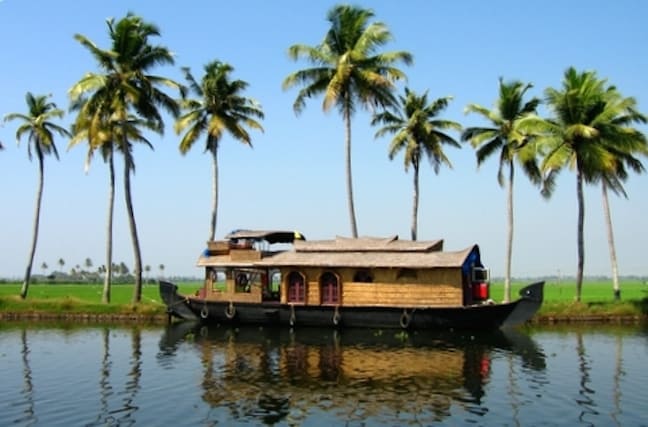
KERALA (INDIA)
The backwaters of Kerala is another exotric destination that I’ve dreamt of exploring by canoe for several years now.
The Kerala region of India is known for its restful spas and healing waters. But you can also kayak or canoe through its world-renowned backwaters, which can make a great experience even greater.
In addition to paddling, you can also enjoy various Kerala tours focused on bird watching, fishing, and other activities. You will have plenty of opportunities to make new friends with the villagers you meet along the way.
At the end of the trip, a paddler-pampering massage can be arranged at one of the nearby spas. It’s an incredible way to end the canoe trip of a lifetime! –by John Geary

If you enjoyed our post on the World’s Best Canoe Trips, you might also like:
10 Best Lakes for Your World Travel Bucket List
10 Best Waterfalls for Your World Travel Bucket List
10 Exotic Islands For Your World Travel Bucket List
10 Unbelievable Mountains For Your World Travel Bucket List
The Best Coffee in the World: A Gourmet’s Guide
How to Choose a Green Hotel
What Is Ecotourism? (The History and Principles of Responsible Travel)
The Benefits of Ecotourism: 20 Travel Bloggers on the Importance of Nature Travel
About the Author
Green Global Travel is the world's #1 independently owned ecotourism website encouraging others to embrace sustainable travel, wildlife conservation, cultural preservation, and going green tips for more sustainable living.
We've been spotlighted in major media outlets such as the BBC, Chicago Tribune, Forbes, The Guardian, Lonely Planet, National Geographic, Travel Channel, Washington Post and others.
Owned by Bret Love (a veteran journalist/photographer) and Mary Gabbett (business manager/videographer), USA Today named us one of the world's Top 5 Travel Blogging Couples. We were also featured in the 2017 National Geographic book, Ultimate Journeys for Two, for which we contributed a chapter on our adventures in Rwanda. Other awards we've won include Best Feature from both the Caribbean Tourism Organization and the Magazine Association of the Southeast.
As Seen On…

Join the 300,000+ people who follow Green Global Travel’s Blog and Social Media
Matador Original Series
The 7 best long-distance canoe and kayak trips in the us.
T here’s hardly a better way to get away from it all than to get out on the water. A long-distance canoe or kayak trip provides stunning, changing scenery and a sense of serenity. The only question is where to go. You could opt for a leisurely float across multiple lakes or take on a more challenging combination of calm water and rapids. You could paddle in between steep canyon walls, along forested riverbanks, or while viewing abundant wildlife on historic rivers. Here are the best options for a long-distance canoe or kayak trip.
Before you go
The length of a long-distance trip depends on you and how much time you have. As you map out your trip, plan to paddle about 15 miles a day. If this is your first time headed out, be sure you do it with someone who has gone before. Depending on where you are going, you may be best off going on a guided tour. At a minimum, talk to locals who can give you specific tips.
If you are not a highly skilled kayaker, you’re going to want more calm conditions — which will influence where and when you go. Most places that are suitable for canoes will have glassy, easy water to dip your oar into. If you’re headed out to rivers fed by glacier run-oft, opt for late summer, after the peak water flow. Check American Whitewater for reports on conditions and understand how to read river conditions .
Wherever and whenever you go, make a detailed plan of the distances you’ll travel per day and where you intend to camp at night. Be sure to leave a copy of that plan with a friend or loved one back home.
1. Boundary Water Canoe Area Wilderness — Minnesota
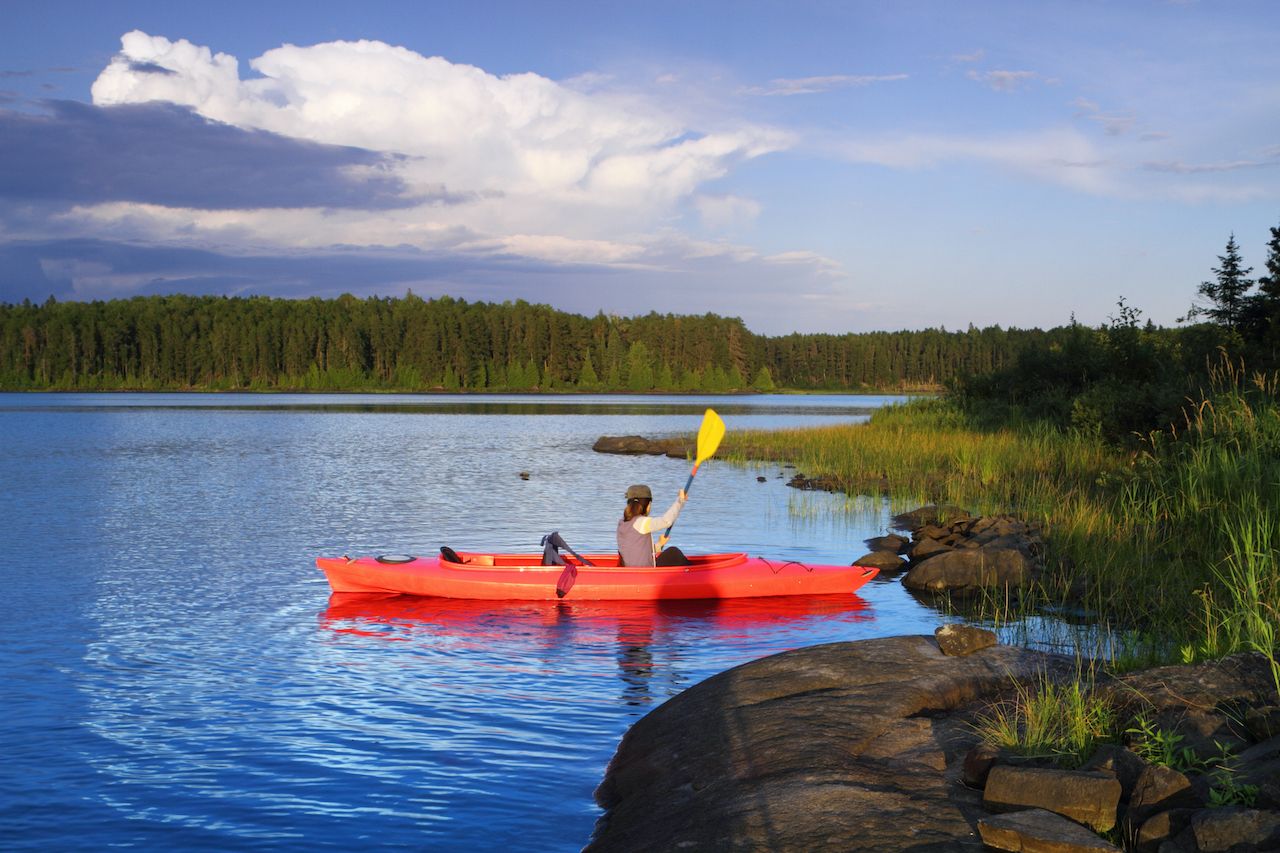
Photo: George Burba /Shutterstock
This may well be the most special place for a serene, long-distance trip across the water in North America. Butting up against the border with Canada, the Boundary Waters Canoe Area Wilderness spans one million acres of the Superior National Forest. This massive area has more than 1,000 lakes offering 12,000 miles of canoe and kayak routes.
Since the majority of its 2,000 rustic campsites are accessed from the water — making this the best place to camp in the state — you’ll have plenty of route options. Note that the lakes and waterways are connected via “portages,” meaning you’ll have to carry your craft over to the next waterway. But the effort will be beyond worth it. You’ll camp amid pine, fir, and spruce trees, and as you paddle you’ll catch sight of beavers busily working on their dams or, through the trees, deer, moose, and black bears. The area also has the largest population of grey wolves in the lower 48.
Plan your route ahead of time as there are more than 70 entry points into the area — and you need to pick up a self-issued permit from the kiosks at the BWCAW entrances and go in through the entry point for which you have a permit. Reserve ahead of time in summer.
2. Northern Forest Canoe Trail
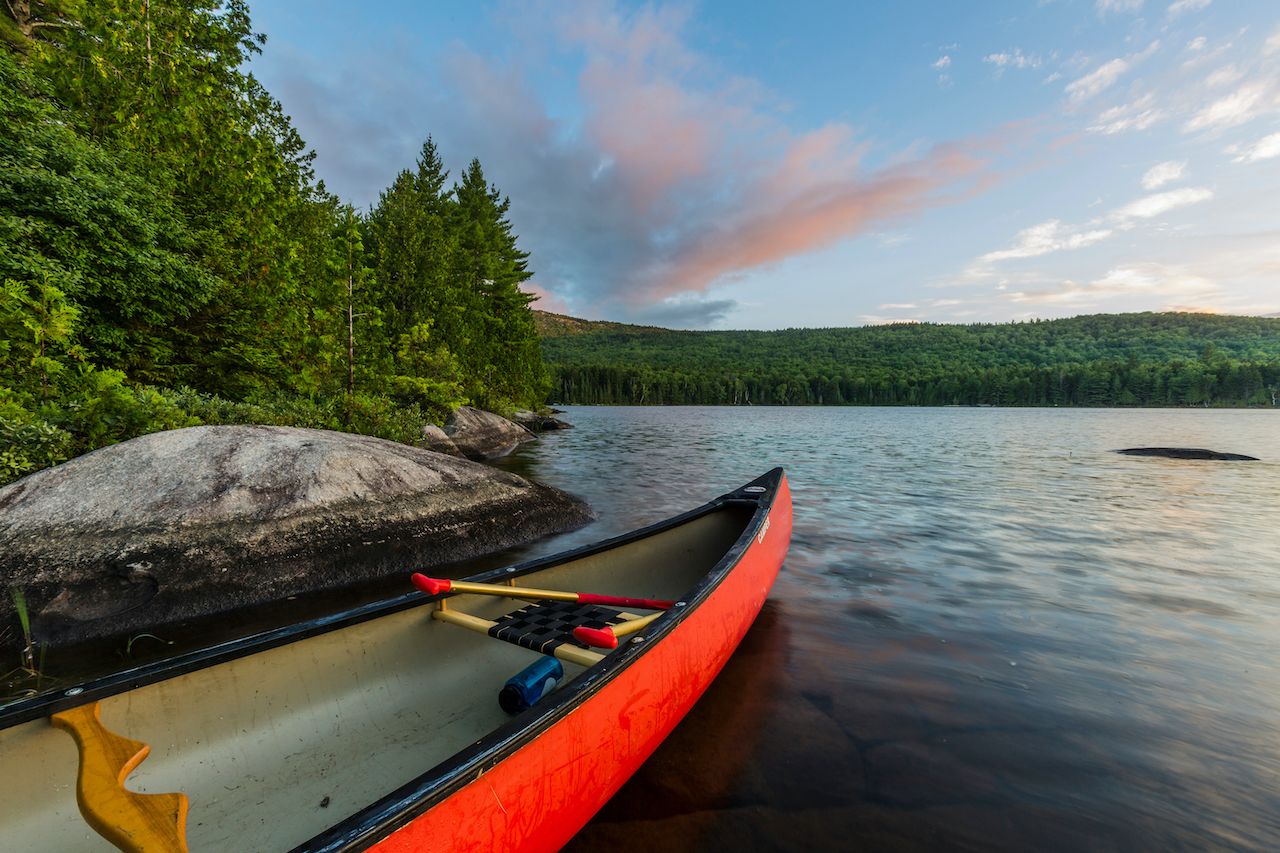
Photo: Danita Delmont /Shutterstock
The Northern Forest Canoe Trail (NFCT) is the longest inland water trail in the country, running 700 miles from the Adirondacks in Old Forge, New York, to northern Maine — and encompassing 23 rivers and streams. Established in 2006, it follows waterways used for travel centuries ago by Native Americans and settlers. You won’t find treacherous Class IV whitewater here, but you’ll find everything from fast-flowing rivers to gentle ponds.
The NFCT includes two nationally designated Wild and Scenic Rivers, Vermont’s Trout River and Upper Missisquoi River. Just note that the northern Vermont stretches cross over into Quebec, so make sure that travel is freely open. Another option is to explore the later sections of the NFCT in Maine, where you’ll cross Chesunkook and Chamberlain Lakes, and maybe spot some moose on the banks of the water as well. To help you decide on a routing, check out the trip planner of the non-profit Northern Forest Canoe Trail organization.
3. Green River — Utah
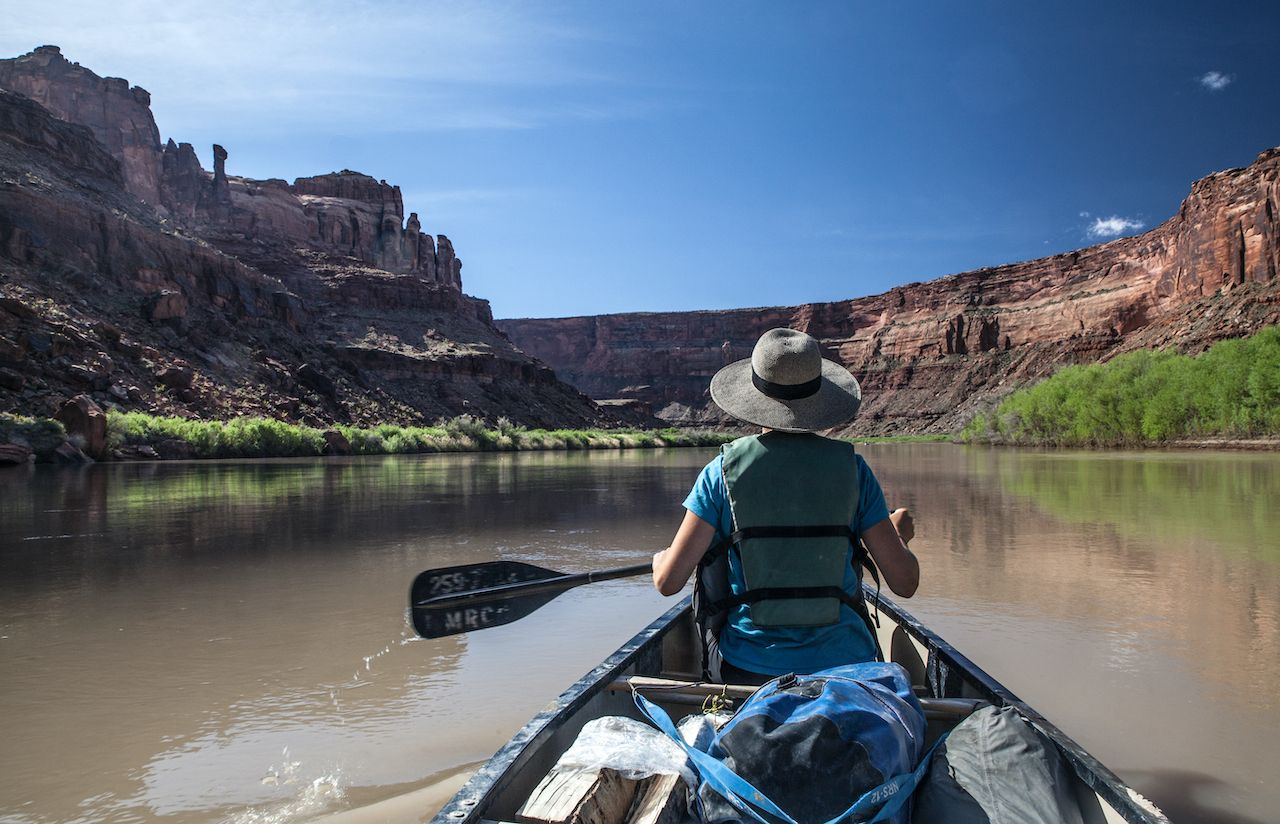
Photo: Chess Ocampo /Shutterstock
The paddle here is not demanding, but keeping your attention on the water may be. The 120 miles of the Green River traverse through deep, red gorges — Labyrinth Canyon and Stillwater Canyon — and offer vistas of stunning rock formations. If you opt for Labyrinth Canyon, put in at Green River State Park and take out about 50 miles later at Mineral Bottom. As you float over the next few days, the canyon walls get steeper as you go, and in the evening bighorn sheep will come into view. You’ll need a permit from the Bureau of Land Management to traverse the canyon.
While neither canyon gets too crowded, Stillwater is even less visited. If you opt for this canyon, one option is putting in at Mineral Bottom and taking out at Spanish Bottom. You’ll be rewarded with views of red mesas standing guard over the river. As the name suggests, the waters here are always calm, making this a good choice for families.
4. Missouri River — Montana
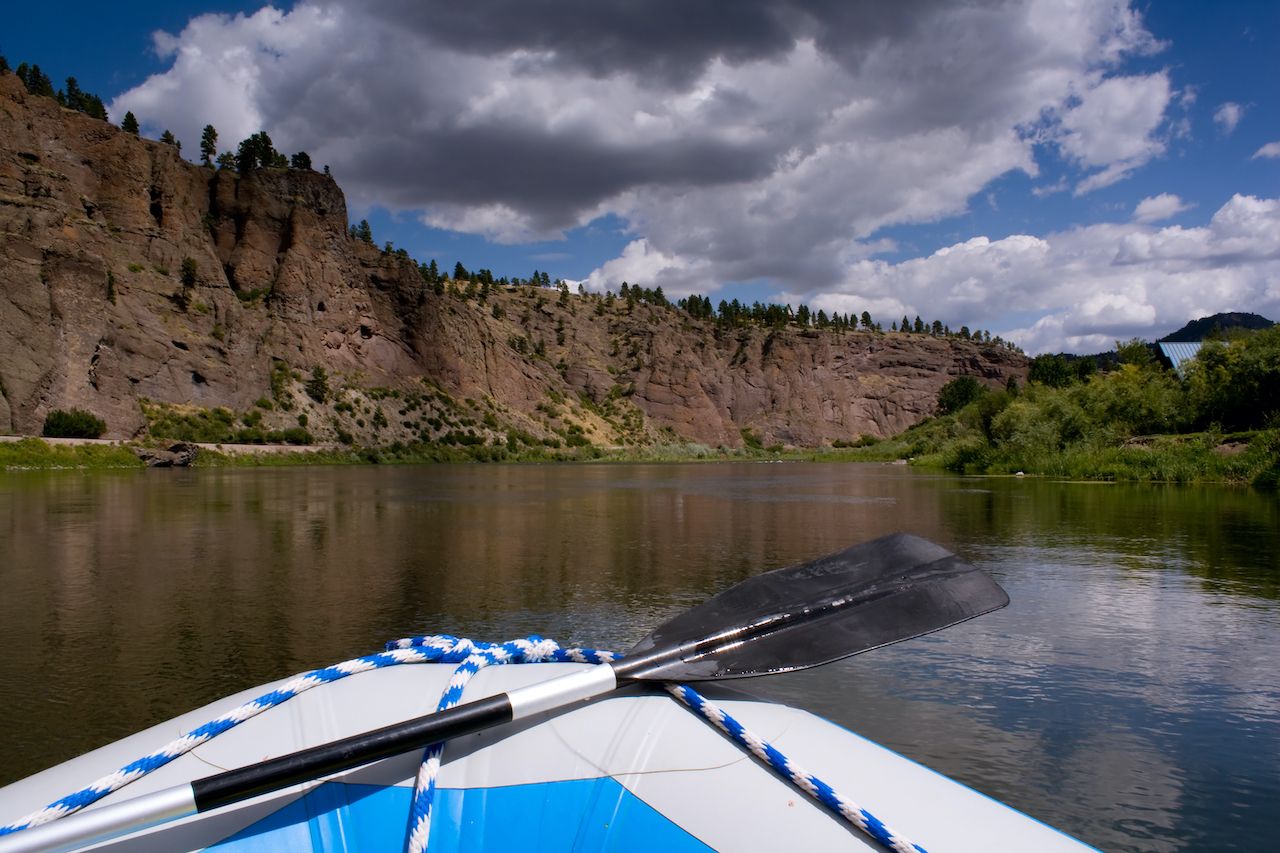
Photo: Gordon Swanson /Shutterstock
Lewis and Clark explored the Missouri River at the start of the 1800s. While the whole navigable section of this nationally designated Wild and Scenic River runs almost 150 miles, a good area to kayak is in the western half of the Upper Missouri River Breaks National Monument. Putting in at Coal Banks Landing, you’ll paddle by white limestone cliffs and pass prairie lands where you can explore petroglyphs and Native American teepee rings. Animals you may find among the sagebrush include bighorn sheep, elk, and prairie dogs. You can take out at Judith Landing or continue deeper towards the shale bluffs of the Missouri badlands.
In the evening, you can rest at campsites that were used by Meriwether Lewis and William Clark, like Eagle Creek and Slaughter River. Just note that summer storms can form seemingly in no time, causing lighting and dropping temperatures by as much as 50 degrees.
5. Klamath River — California

Photo: Ahturner /Shutterstock
While the Klamath River stretches all the way from eastern Oregon through northern California to the Pacific Ocean, the best place for your kayak trip is in the 370-mile section of river that runs through the 1.7-million-acre Klamath National Forest in California’s far northeast. The stretch from Happy Camp to Green Riffle is for experienced kayakers only. Although you’ll eventually enjoy a gentle float, you’ll also tackle Class II and Class III rapids — making for a good combination of excitement and relaxation.
You’ll paddle in alongside evergreens through the Klamath Mountains, catching sight of turtles or river otters by the water, with deer and perhaps a black bear in the forest behind them, and osprey and bald eagles overhead. Note that if you’re camping there over the summer, you’ll need a campfire permit for dispersed camping. Know how to start a fire and how to put out a fire safely . Also be prepared for regulations banning fires altogether in peak fire-danger season, since you can still enjoy camping without fire .
6. Main Salmon River — Idaho
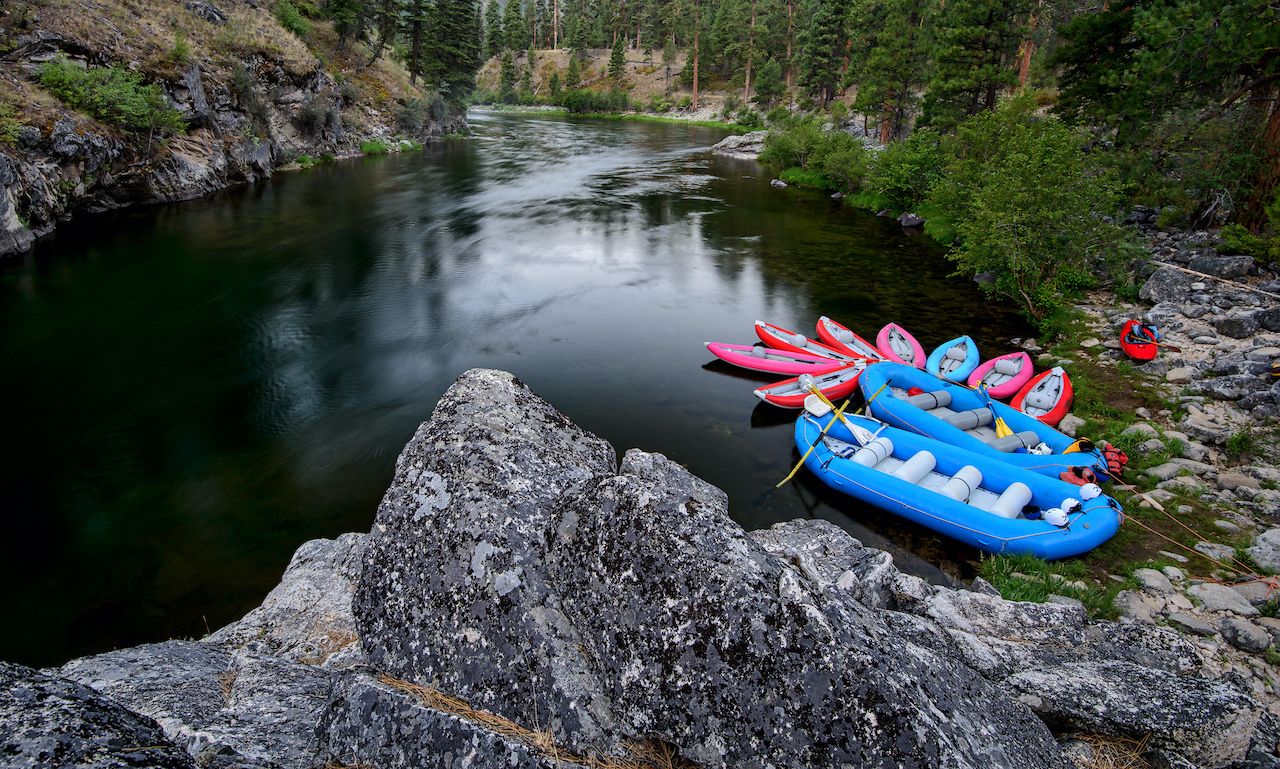
Photo: Sarah Jessup /Shutterstock
A good choice for kayakers is Idaho’s Main Salmon River where the rapids provide just enough oomph but are still manageable by less-seasoned kayakers — provided you come with someone who has more experience. You pass through some Class III rapids here. The Main Salmon River flows through the Sawtooth Mountains and the over two-million-square-mile Sawtooth National Forest, the largest protected areas in the Lower 48. You’ll pass through deep canyons with evergreen fir trees, spotting moose, bighorn sheep, black bears, and otters.
A classic route involves putting in at Corn Creek and taking out due west at Vinegar Creek or even further at Spring Bar. If the idea of packing all of your camping gear in kayaks that can weather Class III rapids seems daunting, consider going with an outfitter that can take your belongings along in a raft.
7. Everglades National Park — Florida

Photo: Maridav /Shutterstock
If you’re in Florida and need a break from the craziness right now, you could do worse than grabbing a kayak and heading out to Everglades National Park, on 2,400 square miles of Florida wetlands. Kayaking alongside mangroves, you may spot manatees, dolphins, alligators, and turtles. Hundreds of bird species have been found here as well, among them storks and egrets. A kayaking trip on Florida Bay, with its 10,000 islands, can be spread out for any number of days, and you can camp on the sand at dozens of backcountry campsites. For river and bay locations where you can’t access land, platforms called chickees serve at the campsite area.
More like this
Trending now, the 10 best nudist resorts around the world, 21 zion national park cabins to make your desert dreams come true, this road trip expert’s free map of 429 national park sites will vastly improve your us travels, the 20 best airbnbs near universal studios orlando, the 19 best palm springs airbnbs for a bachelorette party to remember, discover matador, adventure travel, train travel, national parks, beaches and islands, ski and snow.
We use cookies for analytics tracking and advertising from our partners.
For more information read our privacy policy .
Matador's Newsletter
Subscribe for exclusive city guides, travel videos, trip giveaways and more!
You've been signed up!
Follow us on social media.
OUTSIDE FESTIVAL JUNE 1-2
Don't miss Thundercat + Fleet Foxes, adventure films, experiences, and more!
GET TICKETS
Powered by Outside
The 11 Best Wild and Scenic River Trips in America
Some of the best wilderness in the country has no trail at all. grab a paddle and get ready for the ultimate summer on the water with these 11 trips down national wild and scenic rivers..
Heading out the door? Read this article on the new Outside+ app available now on iOS devices for members! >","name":"in-content-cta","type":"link"}}'>Download the app .
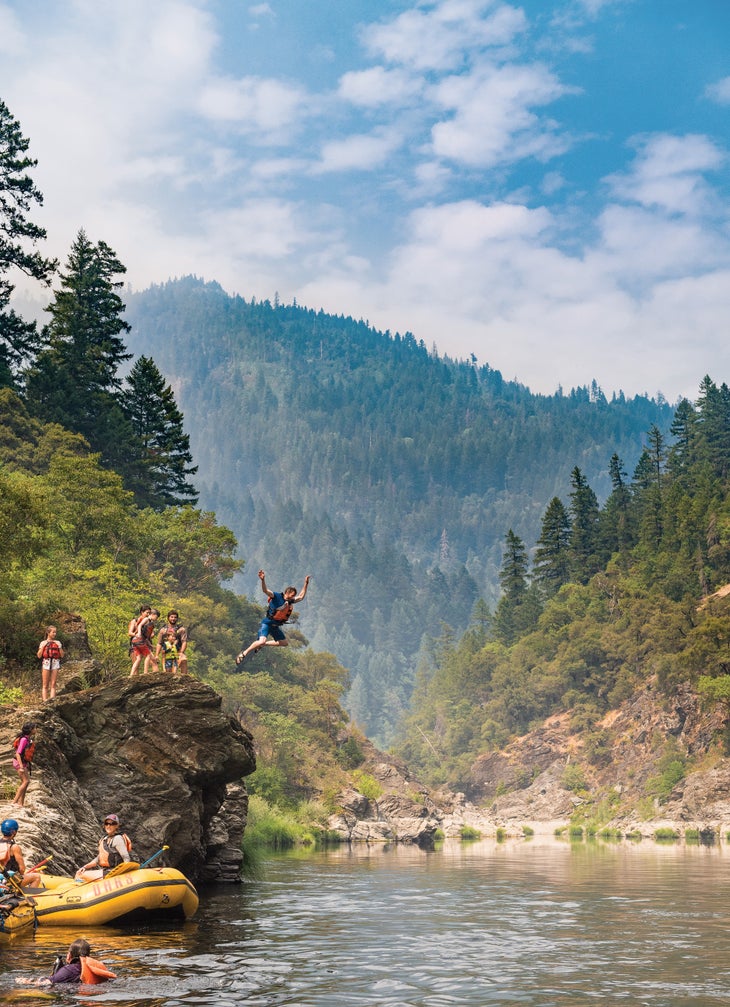
Congress established National Wild and Scenic Rivers in 1968. The designation applies to waterways that “possess outstandingly remarkable scenic, recreational, geologic, fish and wildlife, historic, cultural or other similar values,” and stipulates that they “be preserved in free-flowing condition, and that they and their immediate environments shall be protected for the benefit and enjoyment of present and future generations.” Today, there are 12,347 protected miles on 208 rivers in 40 states. Explore your aquatic heritage, starting with these 11 floats, which range from easy paddles to whitewater.
Klamath River, California
Length 286 miles Designated 1981
The ingredients for a perfect family river trip: warm water, exciting rapids, bald eagles, and waterfront camps where the fire’s sparks mingle with the stars. While the upper section of the 286-mile Klamath roils out of Oregon with Class IV power, the Lower K has a mellower pace that’s fit for an introductory rafting trip. From the put-in at Happy Camp, dip paddles into the 70°F water (average August temperature) and head west, keeping an eye on the sky for raptors, the water for otters, and the banks for black bears. One thing you won’t find: boredom. The 20-mile trip has jumping rocks and riffles aplenty, and Class II/III Savage Rapid offers up a kid-size portion of whitewater. And should you need some ideas for campfire stories, the Bigfoot Trail runs through these same Klamath mountains.
Klamath River Trip Planner
Permit None Season April to August Put-in Sluice Box Take-out Happy Creek Outfitter oars.com
Allagash Wilderness Waterway, Maine
Length 92.5 miles Designated 1970
The 92.5 miles of lakes, ponds, rivers and streams in the blueberry- and bear-filled North Maine Woods are as iconic a canoe setting as you’ll find in the U.S. Tackle a six-day, 62-mile trip from Churchill Dam to Allagash Village , which includes lakes, Class II rapids, and a .3-mile, mandatory portage around 40-foot Allagash Falls. By day, look for moose, eagles, and common terns beyond your gunwales, as well as Katahdin poking out above the mixed-forest canopy. By night, camp at any of the 40 named sites while loon calls serenade you to sleep. Best bet: Hit the water in September, when the fall colors from red maple and quaking aspen stand out against the deep greens of mixed firs.
Allagash Wilderness Waterway Trip Planner
Permit Required ($13 for nonresidents) Season May to September Put-in Churchill Dam Take-out Allagash Village Outfitter
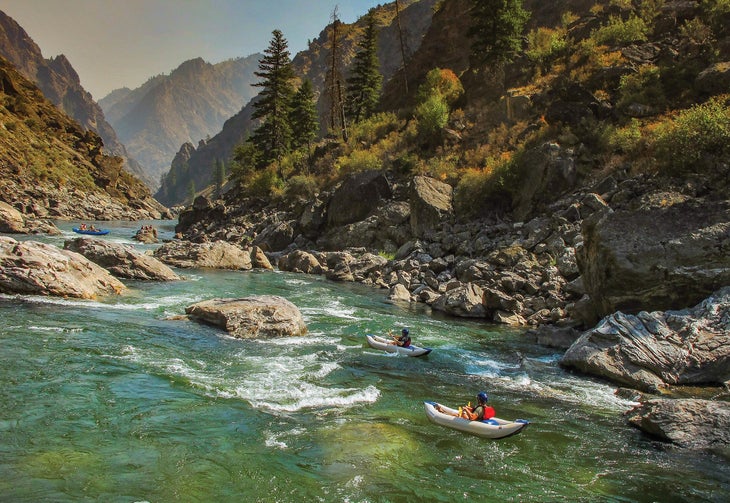
Middle Fork of the Salmon, Idaho
Length 104 miles Designated 1968
With rapids as big as the wilderness they pass through, the 104 miles of the Middle Fork of the Salmon through the Frank Church-River of No Return Wilderness top just about every thrill-seeking rafter’s bucket list. That makes permits a tough get during the lottery window. Better bet: Wait until late summer, when crowds subside and trout are chunking up for the winter. Best part? Hot springs at camp all eight nights. Don’t miss Hospital Bar (mile 53), where a 115°F spring bubbles up into a pool so close to the river you can cast a fly while you soak.
Middle Fork of the Salmon Trip Planner
Permit Required ($10 + $4/person per day); lottery for May 23 to Sept. 3 Season May to September Put-in Boundary Creek Take-out Cache Bar Outfitter blackadarboating.com
John Day River, Oregon
Length 147.5 miles Designated 1988
This is as close as it gets to a relaxed cruise through big Western terrain. The John Day , the third-longest undammed river in the Lower 48, passes through a volcanic wonderland of black, basalt gorges and colorful, fossil-filled ash deposits. For the most part, the lower section ambles along leisurely, letting you relax, take in the scenery, and birdwatch as you drift downstream. The 70 miles from Clarno to Cottonwood are mostly Class I /II, but Class III/IV Clarno Rapids lurks around mile 5 (scout from river left; portage if you need to). Below that is smooth sailing through 1,200-foot-deep canyons and rolling, grassy hillsides at a soporific pace. Target stands of junipers to camp in the shade and look for mule deer, river otters, golden eagles, and red-tailed hawks.
John Day River Trip Planner
Permit Required ($20/group); reserve ahead May 20 to July 10; Season April to June Put-in Clarno Take-out Cottonwood Bridge Outfitter servicecreek.com

Missouri River, Montana
Length 149 miles Designated 1976
When Lewis and Clark floated the Missouri on their westward journey, they saw a landscape unmarred by human industry. The river left its mark on the party: “As we passed on, it seemed those [scenes] of visionary [enchantment] would never have an end,” Lewis wrote in 1805. You won’t regret the 10 days it takes to run the entire 149 miles, but if you don’t have an expedition-length vacation, hit the three-day, 47-mile stretch from Coal Banks to Judith Landing. There, the water courses through an 800-foot-deep canyon of white eagle sandstone, flows across the plains, and threads through layer-cake badlands within Upper Missouri River Breaks National Monument. Camping is plentiful in designated sites, including three Lewis and Clark campsites and historic Blackfeet and Flathead tribal sites with petroglyphs.
Missouri River Trip Planner
Permit Required ($4/adult per day) Season May to September Put-in Coal Banks Take-out Judith Landing Outfitter adventureboundcanoe.com

Rio Grande, Texas
Length 191.2 miles Designated 1978
Desert dwellers like others to think their stomping grounds are too arid and desolate for the rest of us to enjoy. Don’t be fooled. From open, cactus-filled Chihuahuan landscapes to tight, twisty canyons and shady arroyo side hikes, this 20-mile overnight through Santa Elena Canyon offers a sampler of the Rio Grande ’s best scenery. It’s also pretty picante: At mile 15, you’ll run Rockslide Rapid, which can reach Class IV in flows approaching 1,200 cfs (scout river right; there’s no portage option). When your heart rate settles, scan the skies for nose-diving peregrine falcons and the riverbanks for coyotes and wild burros. As you travel, look for grinding holes and petroglyphs from former Native American encampments. Camp on sandbars.
Rio Grande Trip Planner
Permits Required ($12); obtain in person at visitor centers. Season Year-round, but flows peak in August Put-in Lajitas Take-out Santa Elena Canyon Outfitter bigbendrivertours.com
Chattooga River, Georgia
Length 58.7 miles Designated 1974
Fans of Deliverance will be disappointed to learn that the Chattooga River, where the film was set, is not nearly as dangerous as the 1972 classic suggests. Fans of world-class river trips will not. While the rain-fed Chattooga serves up rapids from Class I to Class V, the best intermediate-friendly, two-day trip combines Sections 2 and 3 for a 20 miler that gets sportier the farther you go. The crux is Bull Sluice, a Class IV+ rapid toward the end (beware flows above 2.5 feet on the Clayton gauge). You’ll be immersed in Southeast scenery as you pass through Sumter National Forest’s mountainous woodland of red and white oak, birch magnolia, and mountain laurel—the latter reaches its peak kaleidoscope bloom in June.
Chattooga River Trip Planner
Permit Self-register at put-in. Season Year-round, but best April to September Put-in GA 28 Take-out US 76 Outfitter chattoogawhitewatershop.com
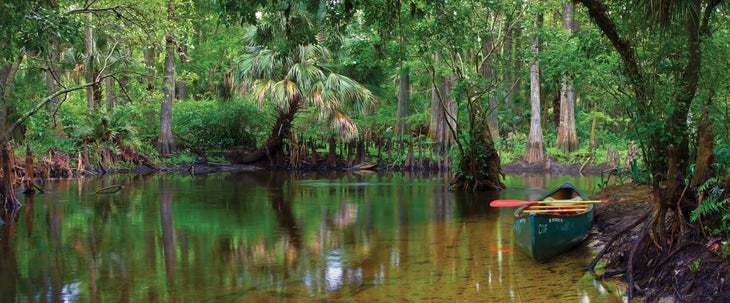
Loxahatchee River, Florida
Length 7.6 miles Designated 1985
The 8.5-mile day trip down this waterway will have you J-stroking in Jurassic Park as it meanders through a primordial swamp filled with centuries-old cypress, ferns, orchids, palms, and mangroves. While you won’t see any velociraptors, you’ll find plenty of their contemporaries: Sunning alligators often line the shores and slip into the water as you paddle by. (Encounters between boaters and alligators are rare, but keep your feet and hands in the boat, and never feed or harass them.) Head downstream from Riverbend Park to Jonathan Dickinson State Park with a prearranged shuttle, or paddle out and back from either of the two (the current is gentle enough to paddle against). The serpentine upper stretch is beginner-friendly, but involves two short portages around dams (or slide over them if going west to east). In Jonathan Dickinson State Park, the river widens into a mangrove-gnarled estuary.
Loxahatchee River Trip Planner
Permit None Season Year-round Put-in/take-out Riverbend Park or Jonathan Dickinson State Park Outfitter canoeoutfittersofflorida.com
Noatak River, Alaska
Length 330 miles Designated 1980
No, it’s not easy to pull off an epic paddle trip in Alaska. Yes, it’s worth it. In June, way up in the Gates of the Arctic National Park and Preserve , the 259,000 members of the Western Arctic caribou herd make their northward journey to their calving grounds, following the river for a portion of it. The best section of the gentle, 400-mile Noatak carves a 45-mile swath through the Brooks Range from Twelve Mile Slough to Lake Matcharak. Load crafts (inflatables are easiest to transport) into a floatplane in Bettles and fly over the granite spires of the Endicott Mountains to the slough near 8,510-foot Mt. Igikpak, where a 200-yard trail leads to the river. The waterway’s gentle gradient affords time to take in the surrounding Endicott and Schwatka Mountains and to scan the tundra benches for Alaska’s A-listers: wolves, Dall sheep, and grizzlies. Run it in June for your best shot at seeing the caribou migration, or in September for fall colors, ripe blueberries, and the aurora borealis.
Noatak River Trip Planner
Permit None Season June to September Put-in Twelve Mile Slough Take-out Lake Matcharak Outfitter arcticwild.com
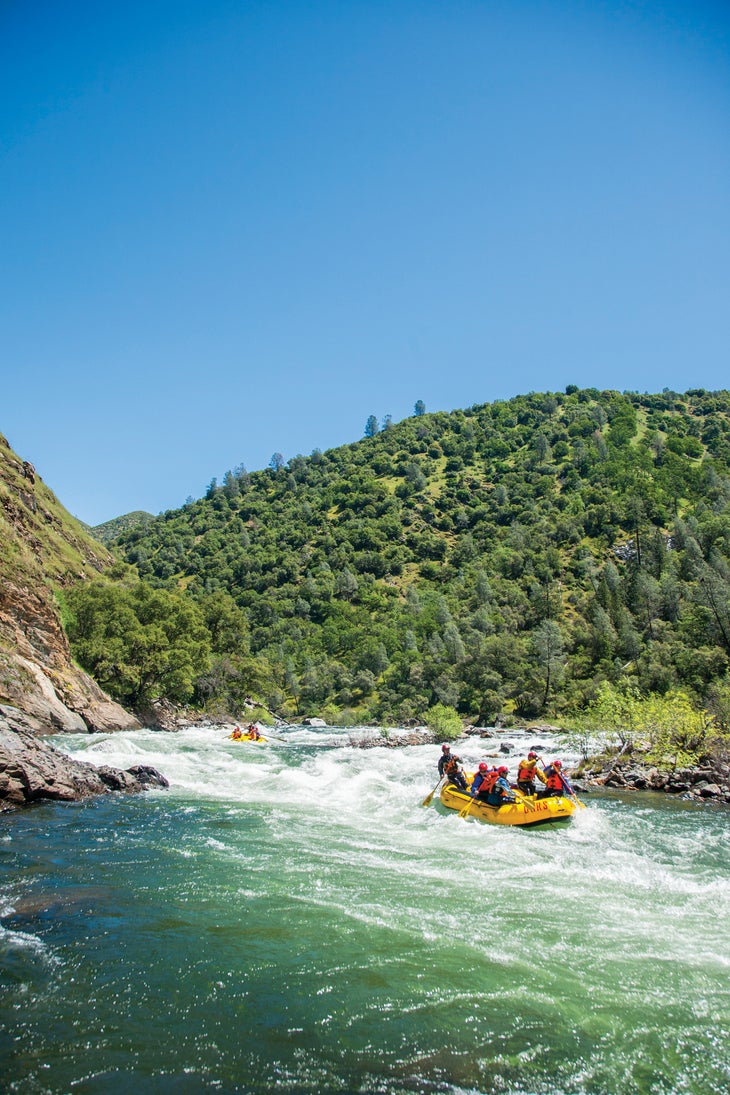
Tuolumne River, California
Length 83 miles Designated 1984
For paddlers with solid whitewater chops, the Tuolumne offers thrills aplenty. The 18-mile canyon teems with Class III to V pool-drop rapids, interspersed with just enough moments of calm to let you catch your breath. Take two or three days to camp on sandy beaches, fish clear pools, and hike up side creeks. Put-in below Hetch Hetchy, and negotiate Class IV Rock Garden and Nemesis rapids in the first .5 mile. At mile 5.4, land your craft at Clavey River and grab your fishing rod to try for native coastal rainbow trout or take a dip. Just below lies Class V Clavey Falls, which requires punching through two giant hydraulic holes (or portage on river right). From here, the river calms down, with jumping rocks, swimming pools, and easier rapids before ramping back up to a Class IV per mile in the final 5 to the take-out.
Tuolumne River Trip Planner
Permit Required ($15) May 1 to Oct. 1; Season May to September Put-in Meral’s Pool Take-out Ward’s Ferry Outfitter californiawhitewater.com
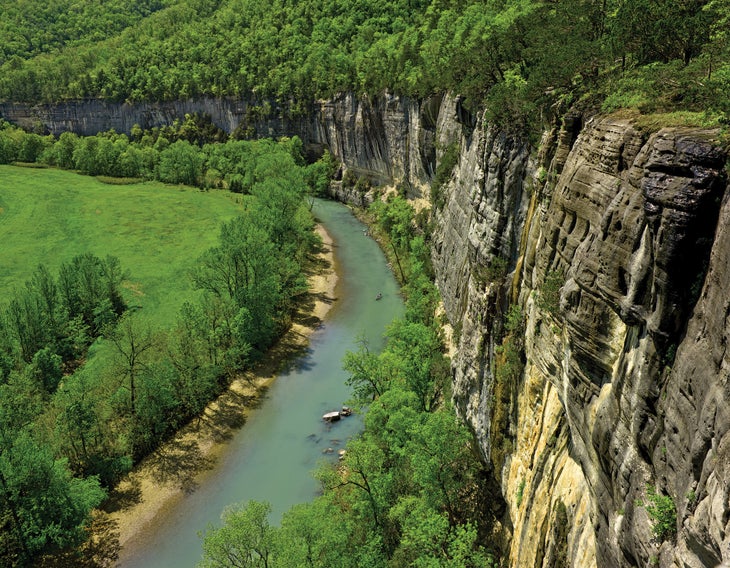
Buffalo River, Arkansas
Length 15.8 miles Designated 1992
Arkansas’s paddling options are outnumbered only by its crawfish, and the Buffalo River is the state’s heart and soul. The undammed waterway sinks hundreds of feet below the rim of limestone bluffs as it flows through the Ozarks’ forested hills. Plan a mellow weekend in the 24 miles from Ponca to Pruitt, where calm waters encourage swim stops, beaches and gravel bars invite picnics, and the waterway passes beneath 550-foot-tall Big Bluff, the tallest cliff between the Rockies and Appalachians. Beach your boat for the side hike to Indian Rockhouse, a massive but shallow cave where Native Americans once sheltered. If you catch rain on your trip, add the 20-minute walk to Hemmed-In-Hollow Falls, which cascades 209 feet—the tallest waterfall in the Midwest.
Buffalo River Trip Planner
Permit None Season April to September Put-in AR 74 Take-out AR 7 Outfitter buffaloriver.com
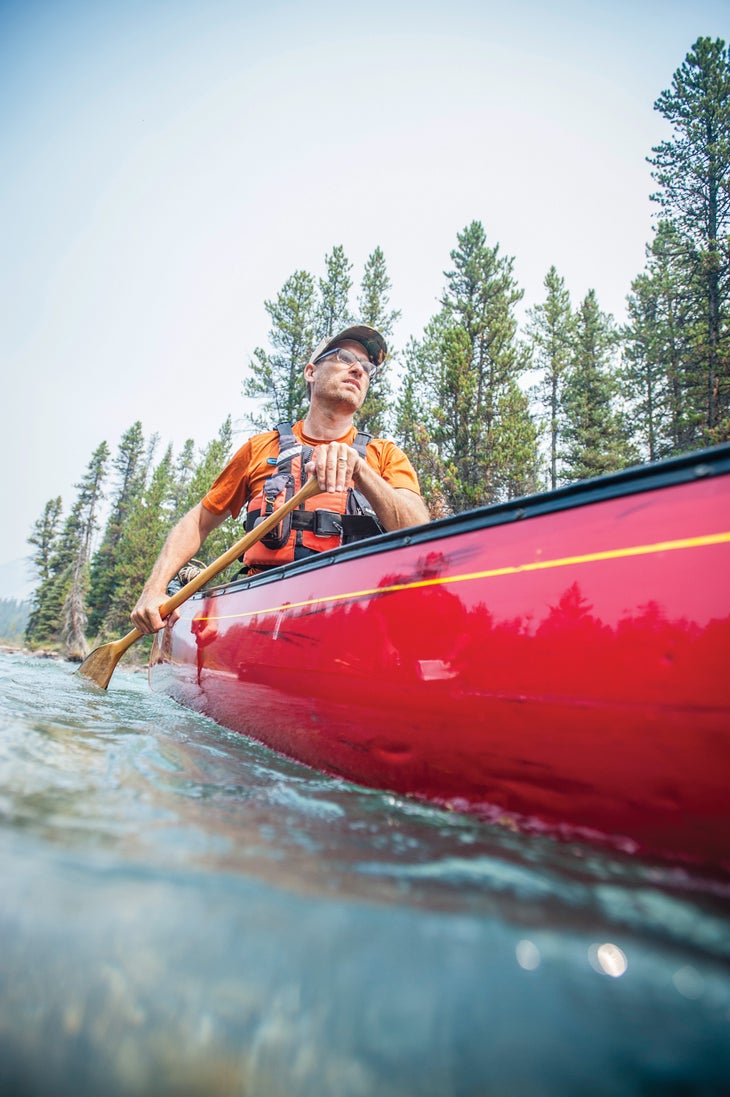
Master Paddling a Canoe
Learn these basic canoe techniques to move well on the river.
Forward stroke WHAT: Conserve energy so you can paddle all day. HOW: Keep your paddle close to the boat (about 6 inches away). Dip the full blade of the paddle straight in and draw it straight back. Use your back and core, rather than just your shoulders. Swivel your torso slightly toward the paddle to further reduce fatigue.
J-stroke WHAT: Add a twist of the paddle to keep your canoe tracking straight. HOW: Start like a forward stroke, but twist the paddle gradually to turn your blade away from the canoe at the end of the stroke.
Sweep stroke WHAT: Change directions at speed. HOW: Pull the paddle in a C-shaped motion (the paddle head is farthest from you in the middle of the stroke) to propel yourself forward while turning. Do it in reverse to slow down while turning. ~Spencer Cox

How to Pack a Canoe
Stow gear right to maximize space and stability.
1. Balance the load. Put lighter items in the front and back of the boat, reserving the middle for heavier gear (which boosts stability) and ensuring items are balanced left to right. Use small drybags: It’s easier to fit them snugly around each other to fill empty space.
2. Keep air in your drybags. Maintain a little dead space in your bags and lash them below the inside edges of your boat. That way, they’ll lend some extra buoyancy in a capsize and will be easier to salvage if they break loose.
3. Bring a bail bucket. Cut the bottom off of a gallon-size plastic jug (keep the cap) so you can hold the handle and use it as a scoop. When possible, do this between rapids to hit the next set without water weight sloshing around and hindering balance. ~Ryan Wichelns

How to Read a River
Follow these signs for safe passage.
Downstream V: This feature generally denotes a good path through rough water. Look for lines in the river that form a “V” shape with the wider part closer to you and narrowing downriver.
Upstream V: These are the exact opposite, with the point of the V shape closer to you. An upstream V usually indicates water flowing around a rock or other hazard. Steer clear.
Holes: Water flowing rapidly over a submerged rock results in a frothy area of rough water just behind the obstacle. The force can flip canoes and drag swimmers under. Paddle hard and keep your boat straight if one grabs you; if in the water, swim to the side. Last resort: Ball up and hope the current flushes you out.
Color bands: Areas of water with slightly different colors parallel to each other indicate variable flows. Straight rivers tend to flow fastest in the center, while curving rivers flow fastest along the outside of a bend. Look downstream, and avoid entering faster bands that could force you into obstacles. Follow these signs for safe passage. ~Spencer Cox
Buy the Right Paddling Gear First
A great trip starts with great gear. Find boats, paddles, PFDs, and other water gear for any trip in our collection of paddling gear reviews .
Popular on Backpacker

Join Outside+ to get access to exclusive content, 1,000s of training plans, and more.
Healthy Living
- Clean Eating
- Vegetarian Times
- Yoga Journal
- Fly Fishing Film Tour
- National Park Trips
- Warren Miller
- Fastest Known Time
- Trail Runner
- Women's Running
- Bicycle Retailer & Industry News
- FinisherPix
- Outside Events Cycling Series
- Outside Shop
© 2024 Outside Interactive, Inc
- Bear's Books
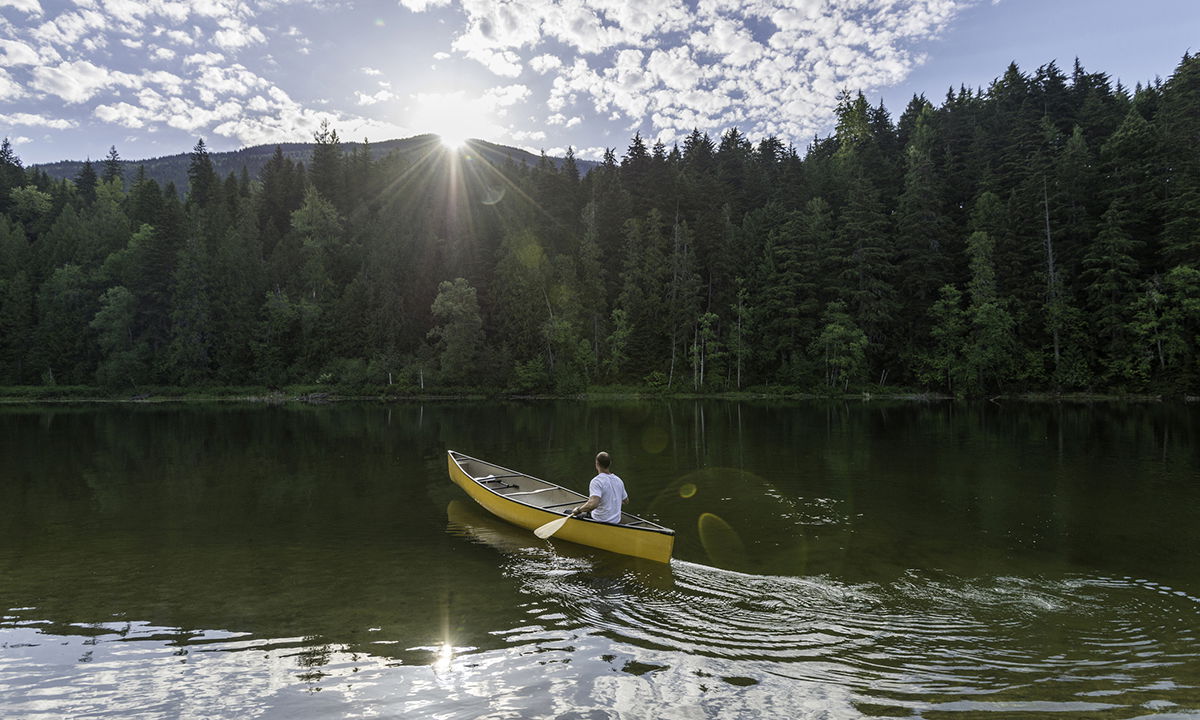
Best U.S. National Parks for Your Next Canoe Trip
By Keira Ezzo
June 26th is National Canoe Day. If you love to get out on the water and you’re in the United States, here is some travel inspiration for your next canoe (or kayak) adventure. Which spot will you choose?
Acadia National Park, Maine
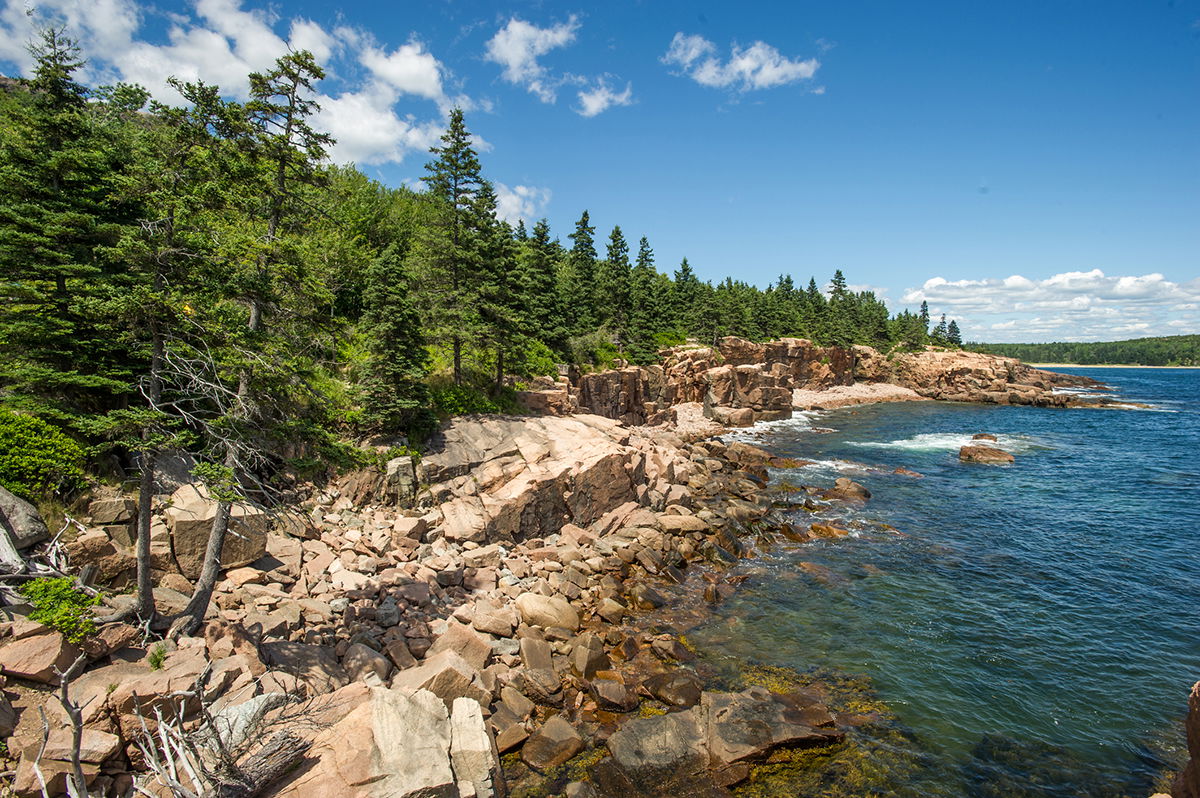
Known as the crown jewel of the North Atlantic coast, Acadia National Park has 4 million visitors annually and is a stunning, natural beauty. With 60 miles of shoreline , Acadia National Park is a great location to get out onto the water for a canoe trip.
Getting out on the water In Acadia will allow you to take in more views, faster. You may even get the chance to get up close and personal with a seal, if you rent a canoe. Pre-planned canoe trips include a sunrise ride out to Eagle Lake to get a view of Cadillac Mountain, the tallest mountain on the U.S. Atlantic coastline, or paddle around the Cranberry Isles.
You can also rent a boat for the day. All individuals going out into the water must wear a Coast Guard-approved life vest.
Congaree National Park, South Carolina

Congaree National Park ’s rivers transport sediments and nutrients that support an expansive ecosystem, including champion trees . The park is located just 30 minutes outside of Columbia , the state capital.
Take a guided canoe tour through the park, and you can canoe for three hours and take in 4 miles of the park, all from Cedar Creek. You’ll see the Congaree swamp system and visit the Tupelo Basin, while also drifting past the peculiar cypress knees . The Cedar Creek canoe trail is about 15 miles long and offers the chance to take in the wildlife of the park, including (possibly) alligators.
Congaree National Park is home to some of the oldest trees in North America. Tours offer the chance to paddle under the branches and take in the stunning sights. Tours have limited capacity, so it is important to register ahead of time .
Big Bend National Park, Texas
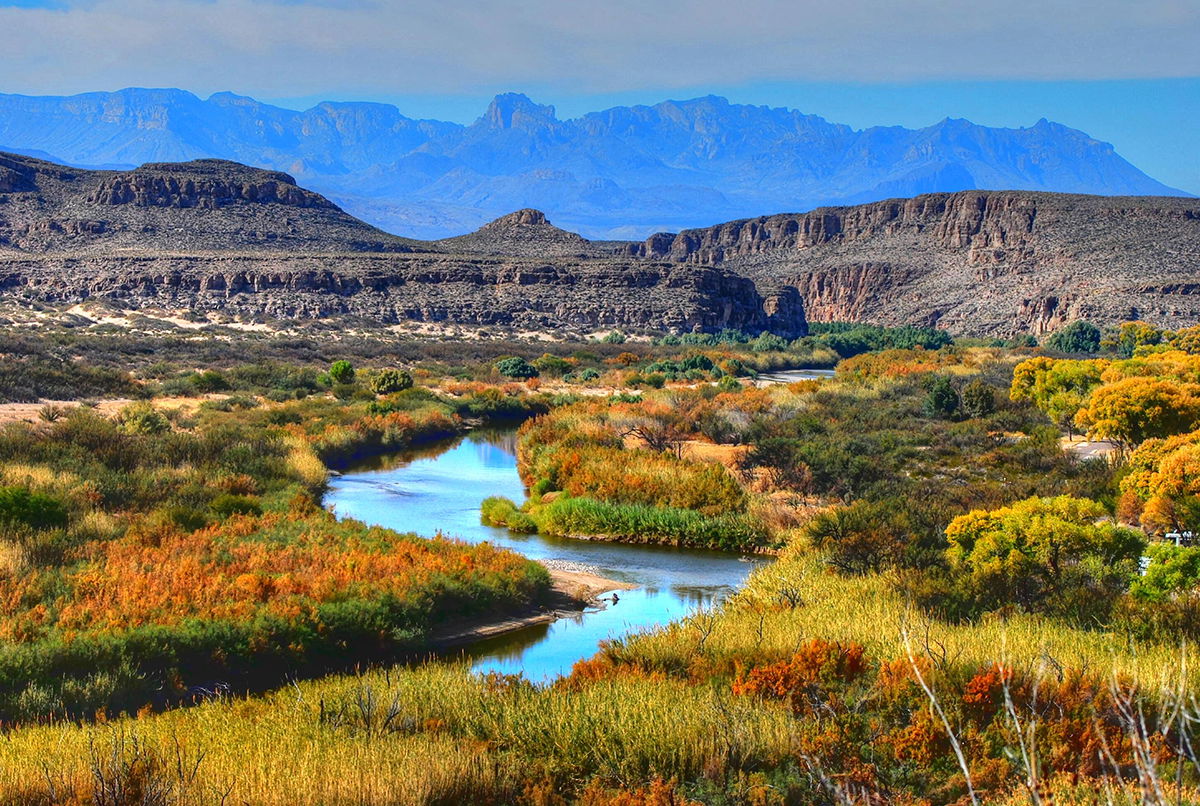
Located in west Texas, Big Bend National Park has limestone mountains that stick out amidst a vast desert. With river canyons moving through the range, there is a sense of magic here. Texas can be hot, so getting out on the water can be a great way to experience the magic.
Depending on the river’s water levels, you can canoe the Rio Grande via a half-day or multi-day excursion. You might see locals fishing, great blue herons, or many other sights as you meander the river.
Due to climate change , the water in the Rio Grande is significantly lower than it was in the past. However, this makes for a good beginner’s journey as newbies learn to handle their canoes. There are many opportunities to get out onto the water on your own, in addition to guided tours on one of five river canyons located in the Rio Grande.
Biscayne National Park, Florida

With evidence of 10,000 years of human life here, Biscayne National Park has long held humans’ imaginations. It’s also a boating wonderland with opportunities for fishing and diving. The park houses remnants of prehistoric tribes, as well as a number of shipwrecks.
The absolute best way to explore Biscayne is by getting out on the water. With opportunities to explore mangroves and shallow coastal waters, a visit to this park should include hours of exploring the lagoons and creeks located within the park. Experts recommend checking the weather and always bringing a paddle buddy to ensure a safe and enjoyable trip out.
Biscayne National Park is also great for birding and seeing egrets, ospreys, and herons, as well as crabs, rays, and maybe even a manatee. Guided canoe tours throughout the park are available for ages three and up. The guided tours are roughly an hour and a half long, and they launch multiple times a day from the Dante Fascell Visitor Center inside the park.
Virgin Islands National Park, U.S. Virgin Islands

Known for its stunning white, sandy beaches, and its complicated history, the U.S. Virgin Island National Park encompasses former sugar plantations and offers the opportunity to study ancient indigenous petroglyphs .
Though many people go snorkeling when they’re here, another great way to explore is to rent a boat, kayak, or canoe. Be sure to study the rules about boating in national park waters, and know that many traditional sunscreens are outlawed on the Virgin Islands due to the chemicals inside that are harmful to coral reefs.
There are a number of canoe and kayak tours available at this park, including combo tours where you go kayaking and then snorkeling once you are out on the water. These tours are a great way to get into a number of different activities, plus you’ll be able to take in stunning views of the coral reefs .
Will you go out on the water this National Canoe Day?
7 Things I Won’t Go Canoe Camping Without
12 Best Sailing Destinations in the World
SUBSCRIBE TO THE FREE OUTDOORS.COM WITH BEAR GRYLLS NEWSLETTER
Related Tags:
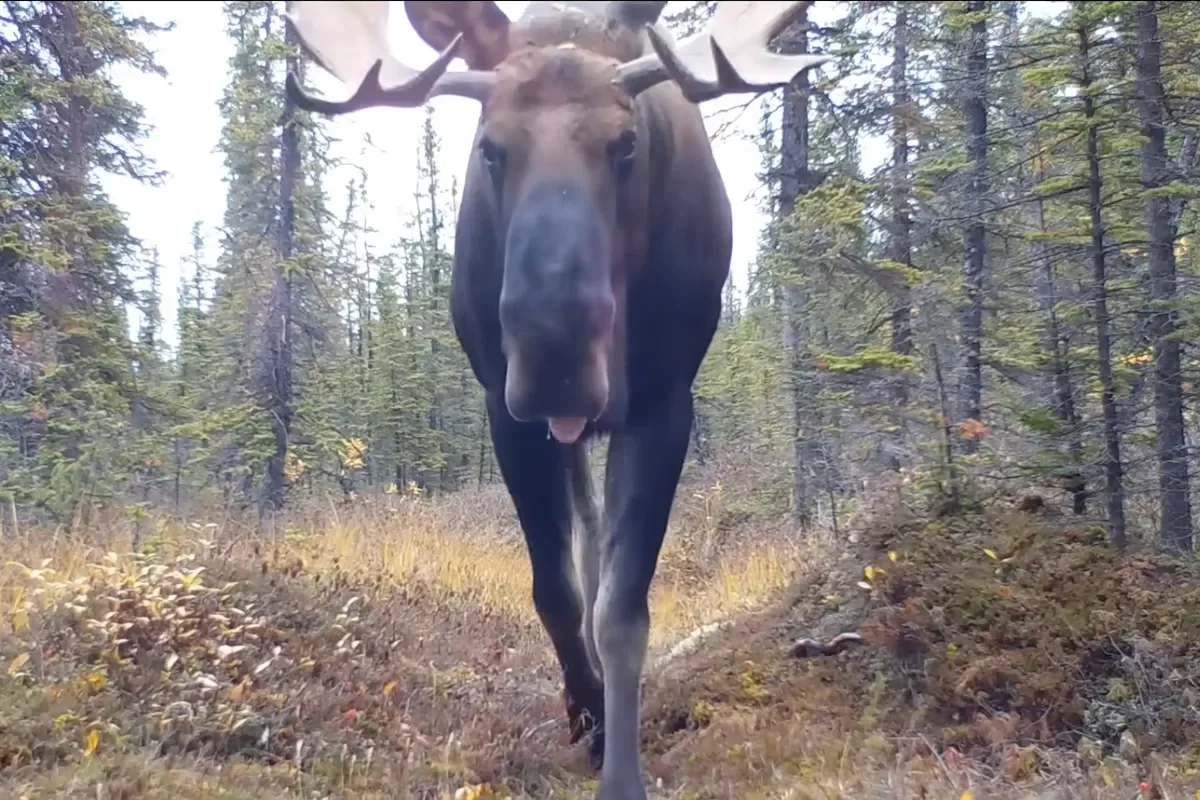
Yukon Trail Cam Shows Grizzlies, Moose, Wolverines, and More
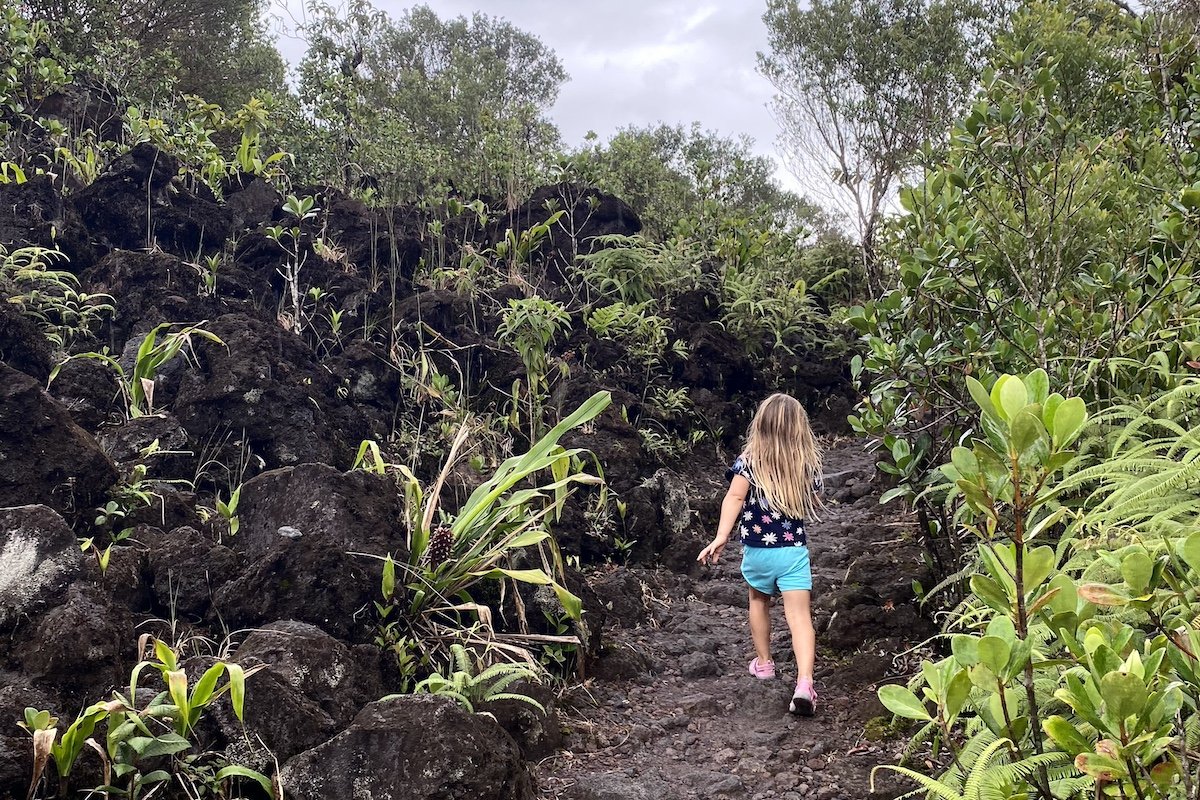
Best Hiking Gear for Kids: 5 Top Products
Leave a comment cancel reply.
Your email address will not be published. Required fields are marked *
Save my name, email, and website in this browser for the next time I comment.
Register for newsletter (optional)
More Like This
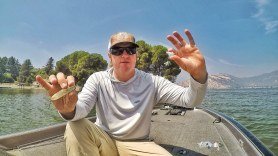
Fall Transition Bass Fishing Tips
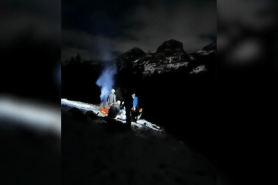
Ice Climber Killed After Fall North of Yellowstone National Park

Extreme Tourism Is a Booming Industry for the Rich, But Is It Ethical?
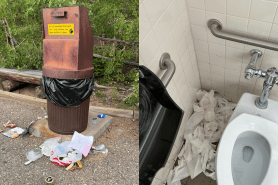
‘Do Your Part:’ Rocky Mountain National Park Asks For Help Cleaning Up
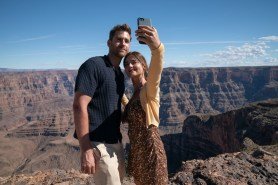
Watch: Amazon’s New Drama ‘Wilderness’ is like ‘Gone Girl’ but With National Parks
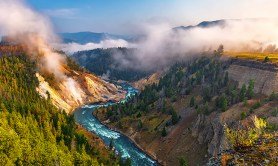
Dreaming of Yellowstone? These Amazing Photos Will Tempt You to Visit Now

The New Hunger Games Film Is Almost Here, But Where Was ‘The Ballad of Songbirds and Snakes’ Filmed?
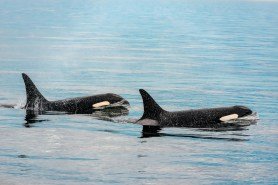
Orcas Sunk Another Boat in the Straight of Gibraltar
More stories.
- Share full article
Advertisement
Supported by
Two Years, 22 Rivers, 7,500 Miles. Crossing America by Canoe.
Paddling through the pandemic to see the country from water level “up close and personal at this interesting time.”

By Corey Kilgannon
A man in a red canoe paddled down the Hudson River, over ferry wakes and past the skyscrapers of downtown Manhattan and into Upper New York Bay.
The canoeist, Neal Moore, 50, of no fixed abode, threw his arms up in the air in celebration and relief, as he finally paddled into New York Harbor on Tuesday afternoon.
His 7,500-mile journey from coast to coast was finally ending. He said it took him 22 months of paddling through 22 states and as many rivers. He said he stopped in more than 100 towns and cities and estimated he may have met several thousand people.
Mr. Moore began in the Columbia River in Oregon, crossed several northern states and traveled down to the Gulf Coast by last winter. By early 2021, he was headed back up to the Great Lakes and to New York State, where he followed the Erie Canal to the Hudson River and ultimately to the Statue of Liberty.
“I felt like I followed that light shining all the way across the country,” he said later. “My journey was one of illumination. So to finally see that beacon up close, that flame of liberty, after seeing it in so many people I met across this land, it was overwhelming.”
Traveling by river became metaphoric: Just as rivers connect towns and cities, Mr. Moore said, he began exploring connections between people often separated by race, class and political stripe.
“I wanted to see the country up close and personal at this interesting time, with the pandemic and all the political strife, to find out what it actually means to be American today,” he said.
Inspired by the travelogues of Mark Twain, Mr. Moore set out to roam “community to community” and write about the people he met. He posted regularly on Instagram and wrote lengthier takes on the laptop he kept in a waterproof bag in his canoe.
The trip — he often paddled more than 20 miles a day — was a way to survey from water level a country facing a divisive election and, as became increasingly clear once the trip began, a growing pandemic.
He grew up in Los Angeles and lost both his mother and his only sibling, an older brother, while still a teenager. By 19, he had moved to South Africa and wound up living largely there and in Asia for three decades, visiting the U.S. only sporadically, including two other extensive canoe trips.
Being a longtime expatriate gave him a fresh perspective for the journey, he said.
Into his 16-foot red Old Town Penobscot canoe he loaded a tent, jugs of water, a bucket of freeze-dried meals, as well as a sheaf of navigational charts and a marine radio.
He set out from Astoria, Ore., on Feb. 9, 2020, and paddled up the Columbia River, hastening his way out of Oregon and Washington just before both states locked down their borders because of the pandemic.
He then paddled the Snake River for five days and didn’t see another person, he said, and traveled through Idaho and Montana to the Continental Divide, then crossed it by using a set of attachable wheels he carried for transporting the canoe along the side of the road when waterways did not connect or proved unnavigable.
He headed down the Missouri and Mississippi Rivers to the gulf to avoid the northern freeze, and by early 2021 was headed back north up the Ohio and Allegheny and other rivers to Lake Erie, bound for New York City.
Some days he would paddle from sunrise to sunset, and some days he would linger — either by choice, to explore and speak with locals, or by necessity because of weather or other issues.
After arriving in March in Demopolis, Ala., on the Tombigbee River, he remained there for a month because of tornadoes and flooding.
“It was about slowing down and listening to people’s stories,” said Mr. Moore, who carried a Sharpie with him so that well-wishers could inscribe messages in the canoe’s interior for good luck.
“I wanted to be open to nature, come hell or high water, and open to new friendships,” he said.
At each stop, he would often stash his canoe, set up his tent and try to find a cheap meal in town. Some people would smile and wave. Some might invite him to a meal or spend the night. Mr. Moore, who teaches English and is a dealer of historical relics, said this helped him travel on a shoestring budget of about $1,100 a month.
While he traveled, the pandemic was engulfing both cities and rural America, a reality that he said hit home five months into the trip when he arrived in Bismarck, N.D., and heard that all the hospital beds were full.
Though many municipalities were implementing lockdowns, Mr. Moore, who had all his possessions with him and no home to return to, simply continued his journey, which was outdoors.
“By any standard of distance paddling, you have to be in awe of what Neal has done,” said David L. Miller, a long-distance paddler and author who met up with Mr. Moore twice along his journey, once along the Mobile River in Alabama last February and again in October along the Erie Canal.
While much of the country was on pause, Mr. Miller said, “here’s a guy who was out there taking the temperature of America, seeing if there are still people out there who will still take in a stranger. And along the way he’s collecting their stories.”
In colder conditions, such as in the Pacific Northwest, Mr. Moore would typically wear a wet suit under baggy waterproof outer clothing, and a life jacket. On hot days, he might wear only his swim trunks.
Fraught moments, in his telling, ranged from the drunk man in Idaho who stood outside Mr. Moore’s tent threatening him, to the patrons in a bar near the Missouri River in Montana who became angry upon hearing of his support for Joe Biden.
“But people were cool, by and large,” he said, adding that he usually avoided political discussions.
“I wanted to put my biases to the side and just listen, to strip all that away and really start see who we really are, outside of the divisive trappings of politics, race and sexual orientation,” he said. “And I saw that it’s still possible for all of us to connect as people.”
There was the family in St. Joseph, Mo., who within minutes of meeting Mr. Moore gave him a jar of moonshine and a joyride in their dune buggy.
Mr. Moore got a tattoo, in remembrance of his brother, from a man along the Missouri River who said he once shared a solitary confinement unit with Charles Manson.
His numerous adventures on the water included a night when a rapidly rising portion of the Clark Fork River washed away his canoe and gear while he slept. Mr. Moore said he was nearly run down by a barge on the Mississippi River and was trapped briefly under his canoe by rough water on Lake Erie near Buffalo, N.Y.
There was the grizzly bear he crossed paths with in Montana. The bear thankfully sauntered away before Mr. Moore could access his bear spray or knife, he said.
There was the giant gator on the shore of Lake Pontchartrain in Louisiana that backed off once Mr. Moore turned his flashlight on it. In the Gulf of Mexico, he paddled with a pod of dolphins and had his canoe rammed repeatedly by a creature he was later told was most likely a bull shark.
From Lake Erie, Mr. Moore paddled roughly half of the 350-mile Erie Canal across New York and walked his canoe for the other half, after the state closed operations for the season.
Journeying down the Hudson, choppy water nearly capsized his canoe off the west side of Manhattan. On Tuesday the New York City Police Department kept an eye on Mr. Moore from the shoreline as he made his way to a marina.
For the last leg of his journey to the Statue of Liberty, he invited roughly a dozen kayakers, including several people he met during his travels, who paddled along with him and watched him finish.
One of them, John Ruskey, a canoe guide and carver from Clarksdale, Miss., said he became intrigued with Mr. Moore’s journey and wound up paddling along with him for several days on the Gulf Coast in February.
“He was like Don Quixote setting off to right the world’s wrongs,” he said.
Mr. Ruskey noted that Mr. Moore’s 22-month journey could have been a two-week car trip, but added, “When you step out of a canoe on a river, people want to hear your story — it opens up a lot of doors.”
While in New York, Mr. Moore stashed his canoe at the Pier 84 Boathouse in Midtown and splurged for a few nights in the historic Hotel Belleclaire on the Upper West Side, in the suite where Mark Twain was said to have once stayed.
As for the future, Mr. Moore said he was headed — by plane — to New Orleans and then Houston and would “try to figure out my next move.”
Corey Kilgannon is a Metro reporter covering news and human interest stories. He was also part of the team that won the 2009 Pulitzer Prize for Breaking News. More about Corey Kilgannon
Politics in the New York Region
Plastic Waste: As plastic continues to fill landfills and oceans, New York lawmakers are considering a proposal to limit single-use plastic products. Here’s what to know about the legislation .
Expensive Hotel Rooms: The average hotel room rate in New York City is $301 a night, a record, and a major reason is that one of every five hotels is now a shelter , contributing to a shortage of tourist lodging.
A Quiet Suspension: A little-known New York State fund that paid the medical expenses of children who suffered neurological injuries as a result of medical malpractice during childbirth has been suspended .
Limiting Donations to Israel: Representative Alexandria Ocasio-Cortez, who rarely wades into state politics, publicly backed a bill that could strip New York nonprofits of their tax-exempt status if their funds are used to support Israel’s military or settlements.
Transgender Student-Athlete Rules: A parent group in New York City asked for a review of rules that let students play on sports teams that align with their gender identity. Democratic officials responded angrily .

Table of Contents
Immerse yourself in adventure and tranquility with this exciting watersport. Canoe camping is like traditional backpacking; however, the only way to reach the campsite is by boat. Paddling on the water is an excellent alternative to hiking during hot summer or a unique way to enjoy the winter landscape.
Whether you’re a beginner paddler or an experienced canoeist, thoughtful preparation is needed for a successful adventure. This guide provides relevant tips on choosing a destination, planning a route, effectively packing, staying safe on the water, and more.
How To Prepare for Canoe Camping
Choose a destination.
There are a few considerations when deciding on a location for canoe camping. You’ll need to pick a destination that matches your comfort level, balancing your skill set and sense of adventure.
If this is your first canoe camping experience, choose somewhere popular with marked campsites. Having marked campsites will make camping easier as you adjust to canoeing and camping combined. A good place to start is searching for local boat-in-only campsites. Look for National and State Parks nearby, and you’ll experience canoeing to the campsite but still have access to restrooms, tables, and flat ground.
However, experienced primitive campers and canoeists can opt for more remote locations without amenities. National and State Forests with rivers are the best options for escaping into the remote wilderness. There are usually rules in these locations associated with fires, trash, wildlife, and camping locations, so familiarize yourself with those before heading out.
Plan Your Route
After choosing your destination, it’s time to plan your route. This part can be tricky if you’re new to canoeing. Consider how fast you paddle, as this will dictate your daily travel distance. A good rule of thumb is to go 3.5 kilometers per hour at most. Then, think about how long you want to paddle each day.
Exploring and relaxing are some of the best aspects of canoe camping, so give yourself plenty of time each day to enjoy it. Leave enough time to set up camp, cook dinner, and enjoy the great outdoors.
Now, you can decide how far you want to travel each day. Don’t try to overexert yourself; otherwise, the trip will be less enjoyable. Paddling for 8 hours a day is likely too much for a beginner. Stick closer to 4 or 5 hours to leave plenty of extra time if you paddle slower or have an emergency.
To start, beginner canoeists should stay for 1-3 nights. As they gain experience, they can increase the length of the trip.
When looking at maps of the area, consider how many times portaging is necessary. Portaging is when an obstacle requires the canoe to be picked up and moved instead of paddled. For example, suppose you must go from one lake to another through shallow water or avoid a waterfall. In that case, it’s easiest to portage by unloading all your gear onto dry ground, moving the canoe, and then making a second trip for the gear.
While considering all this, decide how far to canoe each day and how many days your trip will be. Then, you can start looking at the finer details, such as food supplies, clothing, and needed equipment. Call national and state parks to utilize park guides who are experts on the park routes and can provide advice. Google and social media are other resources for discovering campgrounds and routes that others have taken.
How To Pack for Canoe Camping
When narrowing down what food to bring, consider the length of your trip and how much you can fit. Meal planning is critical to overlapping ingredients for easier packing and ensuring enough meals. Ensure each meal has sufficient calories —paddling can burn more than you think.
High-protein and high-calorie grab-and-go snacks can easily supplement our body’s needs between meals. Consider what spices and cooking oils/butters are needed for the planned meals. Water-tight barrels are perfect for keeping food dry in case of a flip. Water tablets or a water pump are great options for water purification.
Kitchen Equipment
Of course, a camp kitchen is needed. The type of kitchen equipment required will depend on how dispersed the camping location is. For remote locations, EcoFlow Portable Power Stations make utilizing electrical equipment, like a coffee maker, easy.
Consider packing pots and pans, a camp stove, some fire starter, cutlery, cups, plates, a can opener, and hand sanitizer. Recharge this portable power station with EcoFlow Portable Solar Panels for continuous power in remote areas. Consider which portable solar panel meets your boating and camping needs .
The type of clothing to pack depends on the season, and how much depends on how long the trip is. However, generally, you should pack a swimsuit, quick-dry shorts and shirts, close-toed hiking shoes, and waterproof sandals. At night, a fleece jacket, long pants, and cozy wool socks will keep you warm while at the campsite. Layers are essential to packing lightly and efficiently.
Paddling Accessories
This includes paddles, the canoe, life jackets, and other safety equipment. You’ll need at least one paddle, one lifejacket for everyone, and one extra set, just in case. Make sure the lifejackets fit correctly, and all equipment fits into the canoe.
A satellite phone and a first aid kit are essential safety items to have on hand. Pack both of them to ensure they stay dry. A wilderness first aid kit contains more extensive tools and medicine than a household kit. Everything should be in-date, and there should be enough for everyone on the trip.
Outside of an emergency satellite phone, plenty of other tech can make the trip fun. Cellphones and tablets can be used to keep in touch with the outside world. Speakers can play music at night or while paddling during the day. If you like photography, bring a camera and laptop to take and edit photos.
Keep all your devices charged with EcoFlow RIVER 2 Series Portable Power Stations , the most compact portable power stations. With these, you can maximize canoe space without compromising your power needs.
Camping Equipment
At night, you’ll need somewhere to sleep. A tent provides shelter overnight, but you don’t have to splurge on one. A lightweight backpacking tent is compact enough for easy storage in the canoe. A sleeping bag and pad are also necessary for warm, comfortable sleep after a long paddling. Again, backpacking-grade ones are perfect for storing in the canoe. The tent, bags, and pads must be stored in water-tight containers or bags.
Personal Hygiene
Pack what is needed for bathing, teeth brushing, and medication. Make a plan for going to the bathroom. Bring enough toilet paper or reusable bags based on the length of the trip. Also, pack chapstick, sunscreen, bug spray, lotion, and sore muscle cream.
Keeping Safe While Canoe Camping
While canoe camping is all about adventure, the most important aspect is staying safe while on the water or setting up camp. You never know when you’ll find yourself in an emergency, so being overprepared is always a good idea. Keep reading for some safety precautions to take while still enjoying the sport.
- Share your itinerary and location with others. This is good practice before any camping journey. Tell a trusted friend or park ranger where you plan to go, by which days, and when you’ll be back. It’ll be easier to find you if you get lost or there’s an emergency.
- Watch the weather. Being outside means encountering all types of weather. Check the weather before the trip. Pay attention to rain, high winds, fog, and heat index. When packing, include the appropriate apparel and gear for each type of condition.
- Always wear a life jacket. Even if you’re an experienced swimmer, capsizing is unexpected. Don’t take a chance; wear a life jacket.
- Know your limits and only paddle where you feel comfortable. Never overexert yourself on the water. If you don’t have the energy to go further, it’s best to stop and rest. Don’t go out on water that you aren’t comfortable. Lakes are usually calm, but rivers can have unsafe currents.
- Take a canoeing safety course. These courses are designed to teach you how to handle specific emergencies on the water, such as capsizing or getting lost. They also provide safety tips, such as checking the canoe for leaks before heading out. They may also recommend specific safety gear always to have onboard.
Top Tips for Taking Your First Canoe Camping Trip
Practice packing before leaving.
Don’t wait until you’re about to launch into the water only to discover you can’t fit all your essentials into the canoe. To avoid this, practice packing everything into the canoe at home or wherever it’s stored.
Invest in Dry Bags
Dry bags are the best way to pack clothing, camping supplies, and toiletries. You don’t need to spend a fortune on dry bags; invest in durable ones so everything stays dry. Dry bags come in all sizes and are usually measured in liters. Barrels are an excellent option for storing food, but a dry bag will also work. Choose whatever meets your needs and storage limitations.
Bring Plenty of Fire Starters And Matches
Pack extra matches, fire starters, and lighters. This will prevent you from arriving at your campsite only to realize there’s no way to light a fire. The fire can provide everyone with warmth, the ability to cook, and an enjoyable nighttime activity. If one option fails, gets wet, or is lost, there is a backup.
Have a Backup Plan
Sometimes, things don’t go to plan. Consider possible scenarios that could alter the original plan. The boat can become damaged, someone can hurt their wrist, or the weather significantly changes. A backup plan also means you can call for help from the appropriate authorities if something happens.
Joy in The Journey And Destination
As with every activity, there’ll be frustrating times as a beginner. Remember that the joy of canoe camping is in paddling to the destination and in outdoor camping once there. While on the trip, maintain a balance of both. If paddling is more brutal than usual one day, it’s okay to camp early and relax. Be patient with yourself as you embark on this new kind of adventure.
Pack in Evenly
Distribute the gear weight effectively in the canoe. Experienced canoeists refer to this as trimming, or how much of the canoe is underwater. Having the stern heavier and the bow lighter in rapid waters can make navigating easier.
Backup Power Solutions
With easy-to-use power solutions like the EcoFlow RIVER 2 Series Solar Generator , there’s no reason not to pack the best one for your canoe. You’ll never need to worry about electrical outlets while camping. Solar generators combine portable power stations with solar panels to generate and store solar energy regardless of location. If you also plan to fish, consider solar generators supporting all your fishing electronics .
Start Planning Early
If this is your first canoe camping trip, start planning as soon as possible. This allows plenty of time to hash out all the details. Book camping permits in advance, purchase equipment, take safety classes, and practice using gear without worrying about time constraints.
Frequently Asked Questions
Canoe camping can be called “canoe tripping” or “canoe” touring. All three phrases convey the combination of traveling and camping by canoe. These trips usually involve multiple days and nights in the wilderness.
Sleeping in a canoe is generally considered unsafe. Canoes are unstable and prone to easily overtipping, and tossing and turning during sleep can increase this chance. It’s best to paddle to shore and set up camp for a safe and stable night’s rest.
Final Thoughts
For a successful canoe camping trip, choose a location that matches your skill level and take time to plan your route carefully. Consider your paddling speed, how long you want to paddle, and how many days the camping trip should last.
When packing gear, plan out meals and tools, clothing for the number of days and activities, safety precautions, and backup electrical power. The compact, lightweight EcoFlow RIVER 2 Series Solar Generator is the best option for portability.
To prepare for and minimize emergencies, incorporate safety measures such as life jackets, weather knowledge, and sharing your itinerary. Now, you’re ready to paddle away into the tranquility of the water and relax under the stars during your next adventure!
Share this article
Sign Up for Emails
And unlock a delightful surprise!
I agree to EcoFlow's Privacy Policy and Terms of Service.
Popular posts
Why solar generators are your first & best choice for camping, 6 reasons why all homeowners should have a solar power generator, ecoflow power kits: a deep dive into the off-grid solar systems changing the game, mini portable air conditioners: 10 things to consider before you buy, lifepo4 vs. lithium ion batteries: what’s the best choice for you, related posts, the ultimate camping gifts guide, 20 gift ideas for photographers, gifts for the avid bird watcher, leave a reply cancel reply.
Save my name, email, and website in this browser for the next time I comment.
- Privacy Policy
- Terms of Use
© Copyright - EcoFlow, Inc.
Stay in the Loop
Subscribe for exclusive content, giveaways, new products and more!

- Backpacking
- Backcountry Cooking
- Wilderness Medicine
- Destinations
- TRIP REPORTS
10 Incredible Canoe Trips in Canada Worthy of Your Bucket List
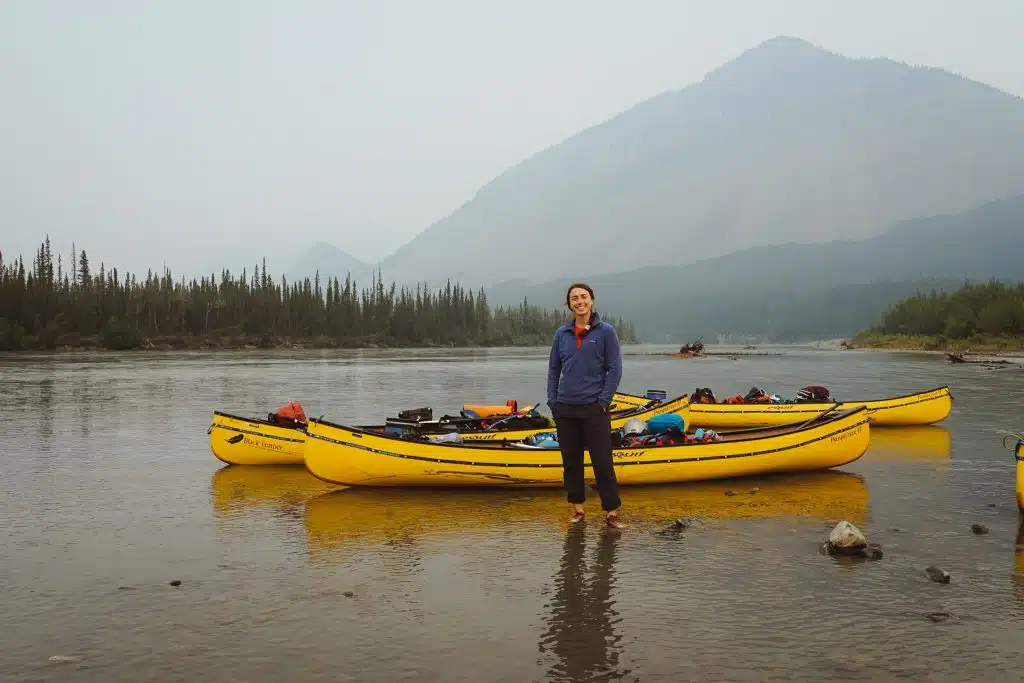
I can’t think of anything more classically Canadian than canoe tripping (perhaps maple syrup, but canoe tripping would be a close second). And since canoeing Canada is so quintessential, I thought I’d put together a bucket list of the most incredible and iconic canoe trips in Canada .
Meandering along winding rivers, the kind with spiny black pine trees lining the shoreline and bends so frequently you can hardly see more than a hundred strokes in front of you. Or wading over large lakes with near-black water, bordered by rocks of granite and quartz that glisten in the sunlight. Moving with an uncontrollable force through towering canyons and overbearing mountain ranges.
Tip! If you’re looking for trip reports on Canadian canoe routes, I suggest checking out Trip Reports . It’s a growing database of backcountry trip reports, most of which are canoe routes!
Whitewater Canoe Trips in Canada
I’ve started the list with whitewater paddling – in other words, river trips. I’ve selected four rivers that I think epitomize Canada canoeing: rivers that provide an unparalleled opportunity for connection with nature and disconnection from society.
Nahanni River
The Nahanni River is possibly the most quintessential paddling route in Canada. Located in the Northwest Territories, the Nahanni River takes you through imposing canyons and weather-worn mountain ranges, and lays witness to the powerful Virginia Falls (twice the height of Niagara Falls).
There are many outfitters with guided trips on the river – both by canoe and raft. The prevalence of rafting allows anyone of any skill to enjoy the river. If you want to paddle a spectacular northern river, the Nahanni River will deliver in spades. Watch the video below from Black Feather – I’ve watched it so many times and I still get chills!
- Location: Northwest Territories
- Duration: 7-21 days
- Difficulty: Intermediate-Advanced
Recommended Reading : Dangerous River: Adventure on the Nahanni
Mountain River
The reason Mountain River is on this bucket list is because it’s the favourite of the guides at Canoe North Adventures , praised for its seclusion and amazing whitewater. These guides get to paddle a lot of different arctic rivers, so if it’s their favourite, it’s definitely on my list.
Mountain River takes you through six canyons with incredibly fast current and, according to the guides, unbelievable whitewater rapids. All while surrounded by rolling mountain ranges and wildlife. If adrenaline is what you’re after, this is some of the best canoeing in Canada.
- Duration: 25 days
- Difficulty: Advanced
Upper & Lower Horton River
The Horton River is the most northern river in mainland Canada and it is an excellent place to spot wildlife like caribou, muskoxen, wolves and grizzly bears. You can either do the upper or lower portion of the river, but frankly, I’d like to do both.
- Duration: 12-25 days (depending if you do one or both sections)
Recommended Reading : The Last Wilderness: 600 Miles by Canoe and Portage in the Northwest Territories
Missinaibi River
Designated as a Canadian Heritage River, the Missinaibi River is one of the most iconic and popular options for canoeing in Canada . It is an excellent river for intermediate paddlers to do unsupported. It’s remote, but not inaccessible. It has some difficult portages and Class III rapids, but also long stretches of smooth water and beautiful scenery.
Grab a copy of Hap Wilson’s Journey to the Northern Sky , which has detailed maps of the many rapids and interesting information on the river, and be on your way. I highly recommend doing the river from Lake Missinaibi all the way to Moosonee.
The first section of the river has amazing rapids and stunning Canadian Shield geography, whereas the second section is wide and winding with few rapids but a northern character.
- Location: Ontario
- Duration 9-20 days
- Difficulty: Intermediate
Bloodvein River
The Bloodvein River is another Canadian Heritage River, and it flows from Woodland Caribou Provincial Park in Ontario to Lake Winnipeg in Manitoba. The river is characterized by excellent whitewater, a classically beautiful Boreal Forest, and exposed granite rocks dotted with Indigenous pictographs.
- Location: Ontario / Manitoba
- Duration 12-15 days
Canada Canoeing: Other Whitewater Areas of Note
If I were to list every single river I’d like to paddle, this post would go on forever. Here are some other rivers on my never-ending to-do list: Hayes River (Manitoba), Keele River (Northwest Territories), Yukon River (Yukon) and Churchill River (Saskatchewan).
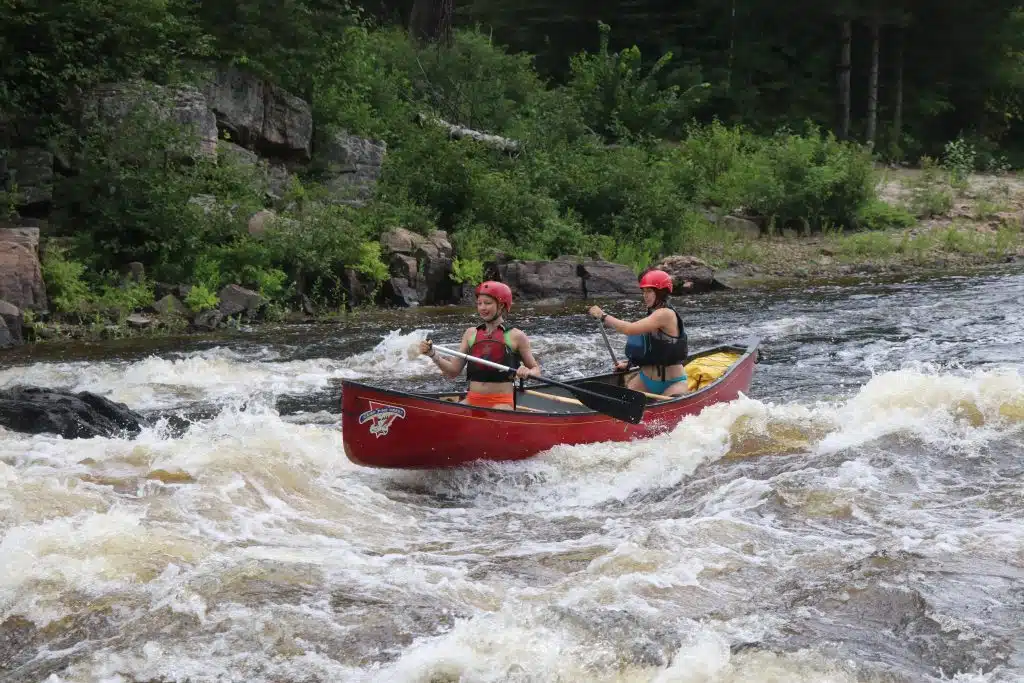
This post may contain affiliate links. If you make a purchase through one of these links, I may receive a small commission at no extra cost to you. Your support is much appreciated! You can learn more by reading my full disclosure .
Flatwater Canoe Trips in Canada
Despite my growing preference for whitewater canoeing, there will always be a place in my heart for flatwater paddling. There are far too many lake networks in this country to paddle them all, but a few iconic areas are worth a place on any canoeist’s bucket list. As seeing as most canoeists stick with flatwater, there are tons and tons of incredible destinations. This, my friends, is Canada canoeing at its finest.
Killarney Provincial Park
I think Killarney is the most beautiful place in Ontario and one of the most beautiful places in Canada. The scenery is striking; lakes the colour of Gatorade, hills that sparkle silver in the sunlight, windswept pine trees lining the shores.
In autumn the trees change into a kaleidoscope of colours. Killarney is so beautiful, that it is home to OSA (Ontario Society of Artists) Lake and Artist’s Lake due to its significance to Tom Thompson and the Group of Seven (Canada’s famous landscape painters).
When I first paddled Killarney, I did a 12-day trip and experienced over 3/4 of the park . It also has some amazing weekend trips.
- Duration: 3-12 days depending on route
- Difficulty: Novice
Additional Resource : A Paddler’s Guide to Killarney and the French River
Bowron Lakes Circuit
British Columbia may not have many canoe routes, but the routes it does have are spectacular; Bowron Lakes is no exception.
This canoe route takes you through six major lakes and two rivers, all of which is connected through a series of portages. The major difference between this canoe trip and those in eastern Canada is that you’re paddling at the foot of the Cariboo Mountains – expect to see pointy peaks and glacial lakes!
- Location: British Columbia
- Duration: 6 – 10 days
Temagami isn’t technically a park but has campgrounds and portages maintained by the Friends of Temagami. Hap Wilson, one of Canada’s most iconic canoeists, calls Temagami home – and for good reason.
I’ve done two different two-week trips and would still go back for more. Some of my favourite destinations in Temagami include Paradise Lagoon, Wolf Lake, and the hike up Ishpatina Ridge (the tallest peak in Ontario).
Definitely check out Hap Wilson’s comprehensive book on wilderness routes in Temagami .
- Duration: 7-12 days depending on route
Additional Resource : Temagami – A Wilderness Paradise
Algonquin Provincial Park
Algonquin Provincial Park is the Creme de la Creme of Canada canoeing. It covers 7,000 square kilometres and is home to more than 2,000 kilometres worth of canoe routes.
Need ideas for canoe routes in Algonquin? Check out our database of Algonquin Park trip reports .
- Duration: 3-7 days depending on route
- Difficulty: Novice – Intermediate
Additional Resource : A Guide to Algonquin Park
Woodland Caribou Provincial Park
Woodland Caribou Provincial Park is an excellent destination for intermediate paddlers and it’s the only flatwater destination still on my to do list.
The park is located on the border of Ontario and Manitoba, making it reasonably accessible while still providing opportunities for solitude and silence – the park contains 2,000 km of canoe routes and receives only 1,000 paddlers each season.
This is what makes Woodland Caribou spectacular, in my opinion. You’re nestled amidst the beauty of the Boreal Forest, which paddlers have long cited as having a certain magical feeling one can’t quite articulate. And you can experience it without interruption.
While Killarney and Algonquin may feel a tad commercialized and you’re likely to encounter other paddlers, Woodland Caribou remains a little known secret. However, this is also why I believe your skill level needs to be higher; if you run into trouble, help is further away.
Regardless of your level of experience, I recommend reaching out to Red Lake Outfitters if you are considering a trip here. They are the definitive experts on Woodland Caribou and offer guided trips, shuttle services, route planning, gear and more.
- Duration: 7 – 21 days depending on route
Canada Canoeing: O ther Flatwater Areas of Note
If the opportunity came, I’d also do a canoe trip in Quetico Provincial Park (Ontario) and I’d love to do another trip around Georgian Bay Islands National Park (Ontario). However, at this point I’ve grown a bit tired of flatwater paddling so I’d rather dedicate my time to whitewater. That said, if you haven’t done much Canada canoeing yet, there are tons of options to get you started.
Canoeing Canada – Final Thoughts
I hope this post has introduced you to some new places and wonderful places to go canoeing in Canada and perhaps even added a trip or two to your bucket list!
What are your thoughts? What are your favourite destinations for canoe trips in Canada? Let me know in the comments below!
Mikaela | Voyageur Tripper
Mikaela has been canoeing, hiking and camping for over ten years. She previously worked as a canoeing guide in Canada, and spent a season guiding hiking and kayaking tours in the high Arctic. Mikaela is a Wilderness First Responder and Whitewater Rescue Technician.
MY FAVOURITE GEAR
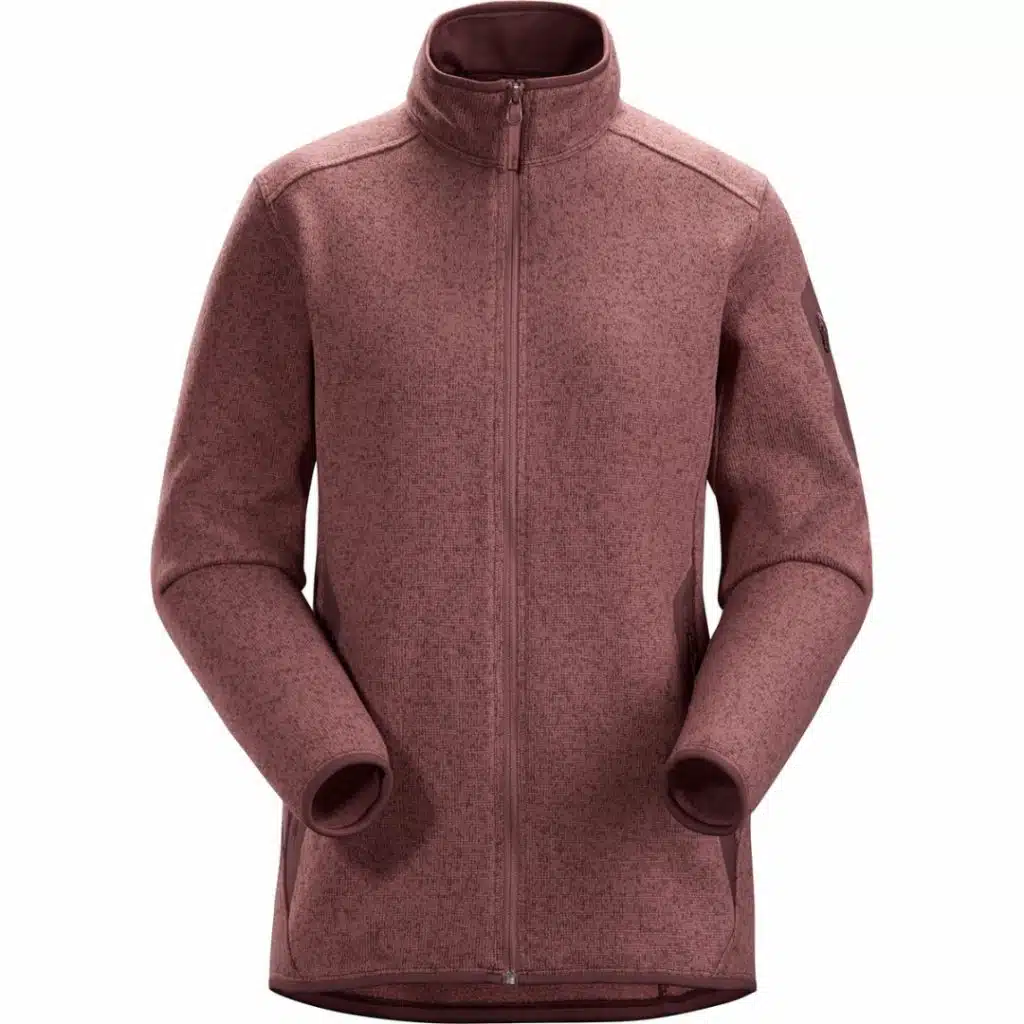
Fleece Sweater
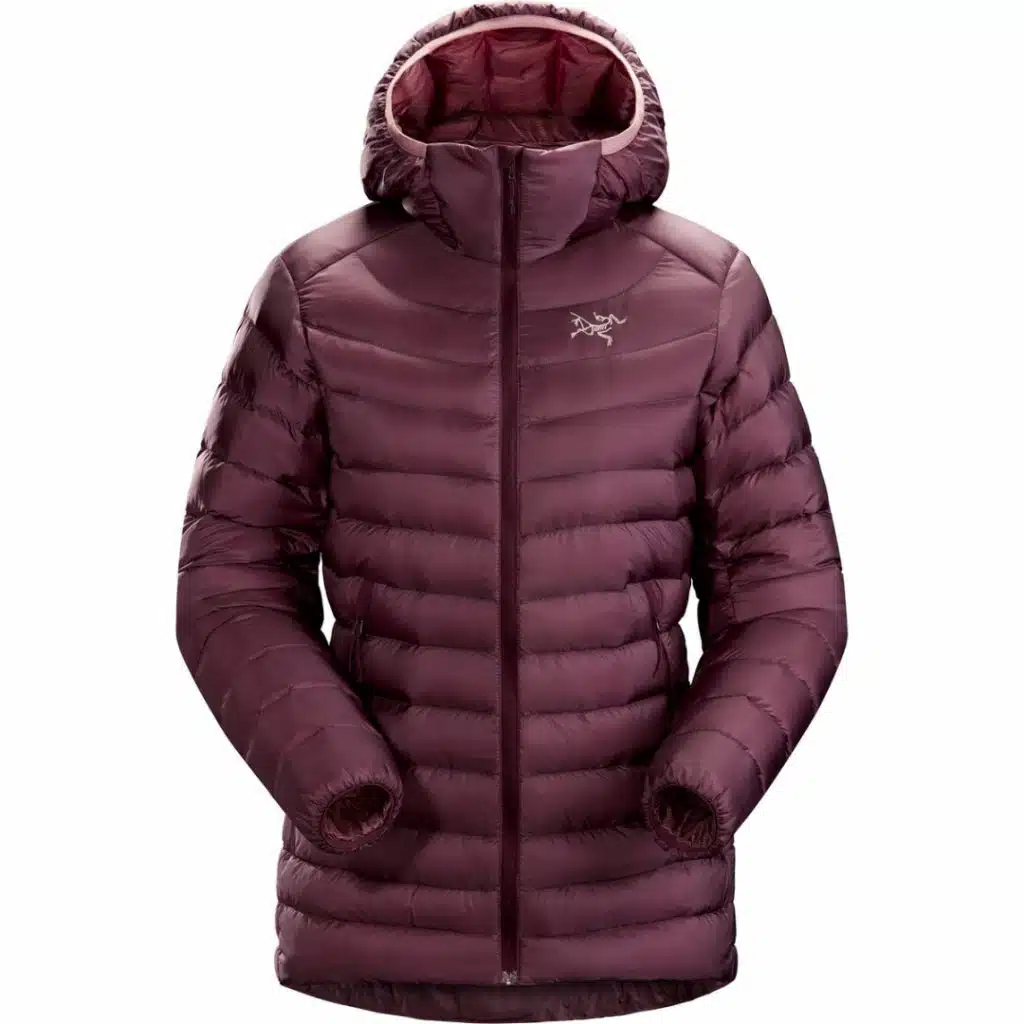
Down Jacket
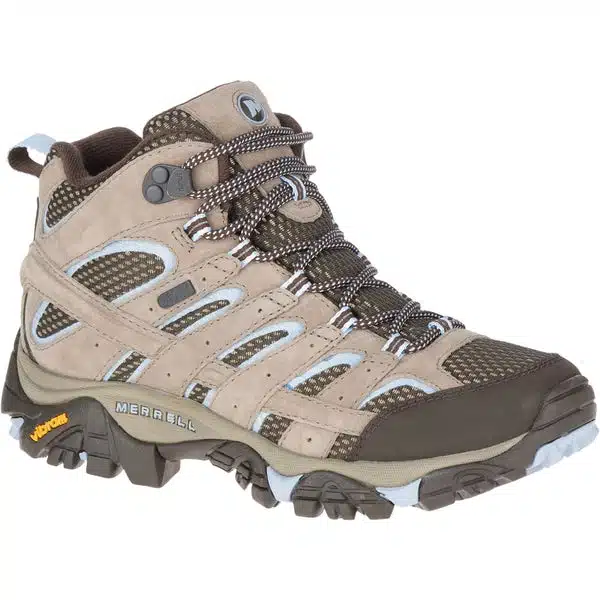
Hiking Boots
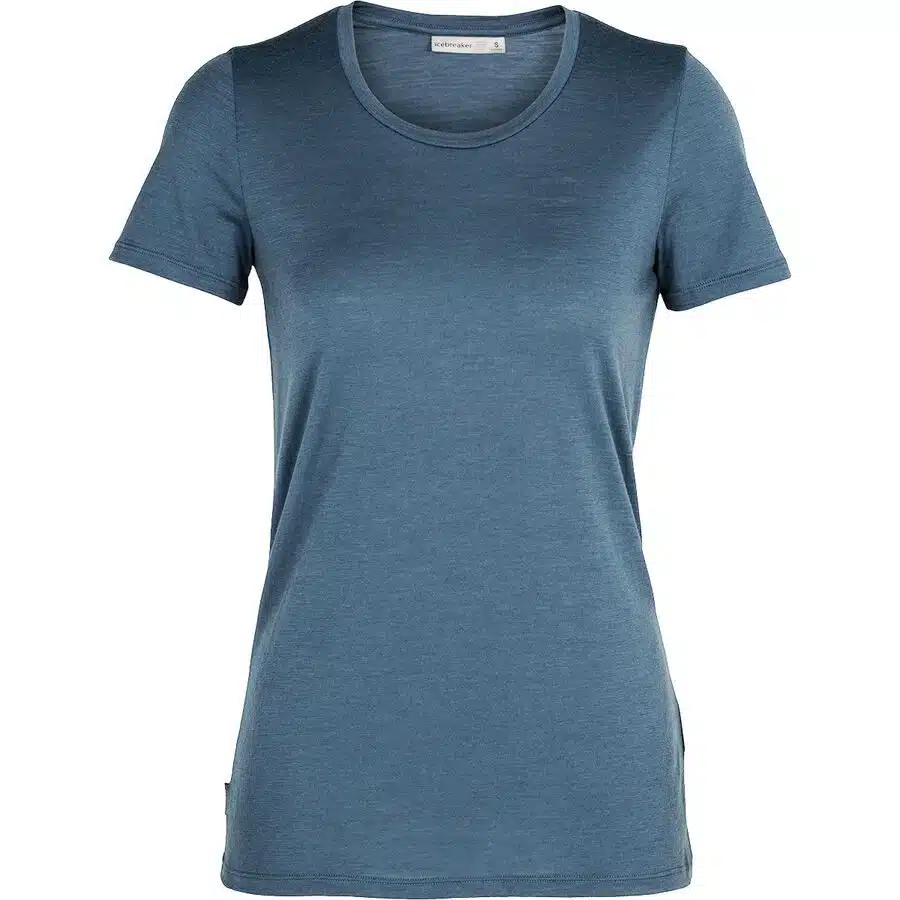
Hiking Shirt
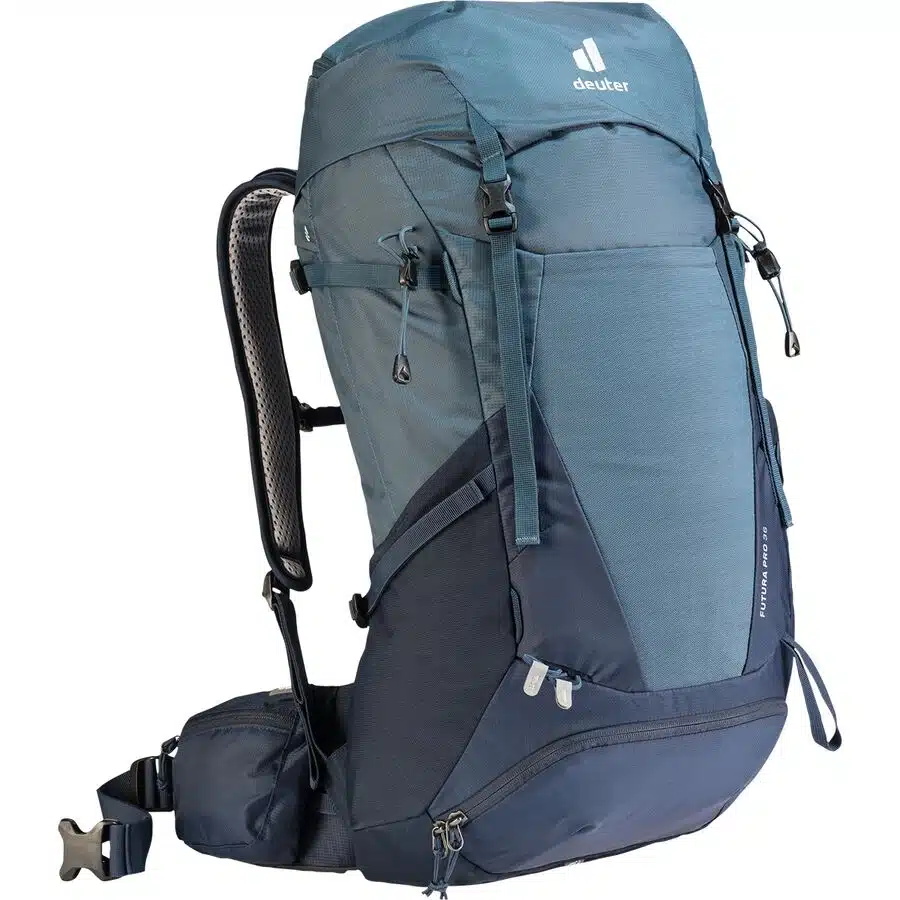
Hiking Pants
6 thoughts on “ 10 Incredible Canoe Trips in Canada Worthy of Your Bucket List ”
Stay in touch.
Join our community of outdoor adventurers - you'll find trip inspiration, gear discussions, route recommendations, new friends and more!
I was very happy to see WCPP on your list, it’s an amazing place. I was fortunate to go in 2019 and again in 2020. My only other canoe tripping is in Algonquin but this year I am considering a trip down Rivière Noire. I would highly recommend a trip to WCPP . I see that you prefer white water and in that case you can start with the flat water of WCPP and finish on the Bloodvein River white water all the way to Lake Winnipeg. Happy tripping
Hi Ian – Thanks for the suggestion! I think I’d really enjoy the Bloodvein. And I’m sure you’ll love the Noire! I did that one in 2017 and it was a ton of fun!
I am not a WCPP expert but I have done a lot of research for my WCPP trips and know where or who to contact for expert advice. If you ever need info to get started, please don’t hesitate to ask. FYI, Artery Lake (the start of the Bloodvein whitewater) has an amazing pictograph mural.
Thank Ian! I will keep that in mind! I’d love to paddle the Bloodvein 🙂
I think you’re from Ontario? your list is somewhat geographically biased… The Missinaibi (I’ve paddled it) just doesn’t belong in the list with the Nahanni & Mountain… Also the Hayes is in Man, not Ont. How about the Clearwater, Fond du Lac etc in Sask? You briefly mention the Churchill and imho it deserves a far higher billing. And you don’t mention a single Quebec river…
just thoughts…
Hi Ian – I am from Ontario and I totally admit I am geographically biased!
Though I will stand by my comment on the Missinaibi River – I think it is an incredible (and incredibly accessible) river. The historical significance, the change in scenery, the short technical sets – I love the river.
I actually have a note on my laptop to add the Moisie and Broadback to the list – I know I definitely need some Quebec rivers on the list, but I was only familiar with the Three Sisters when I wrote the post a few years ago and I didn’t think those ones needed to be on the list. I’ll look into the Sask rivers too.
Thanks for the feedback 🙂 Happy paddling!
Leave a Reply Cancel reply
Your email address will not be published. Required fields are marked *
Save my name, email, and website in this browser for the next time I comment.
- Facebook Group
GUIDED ALASKA Canoe
0 sorry, no trips available.

ARCTIC WILD Canoe
Featured trips.
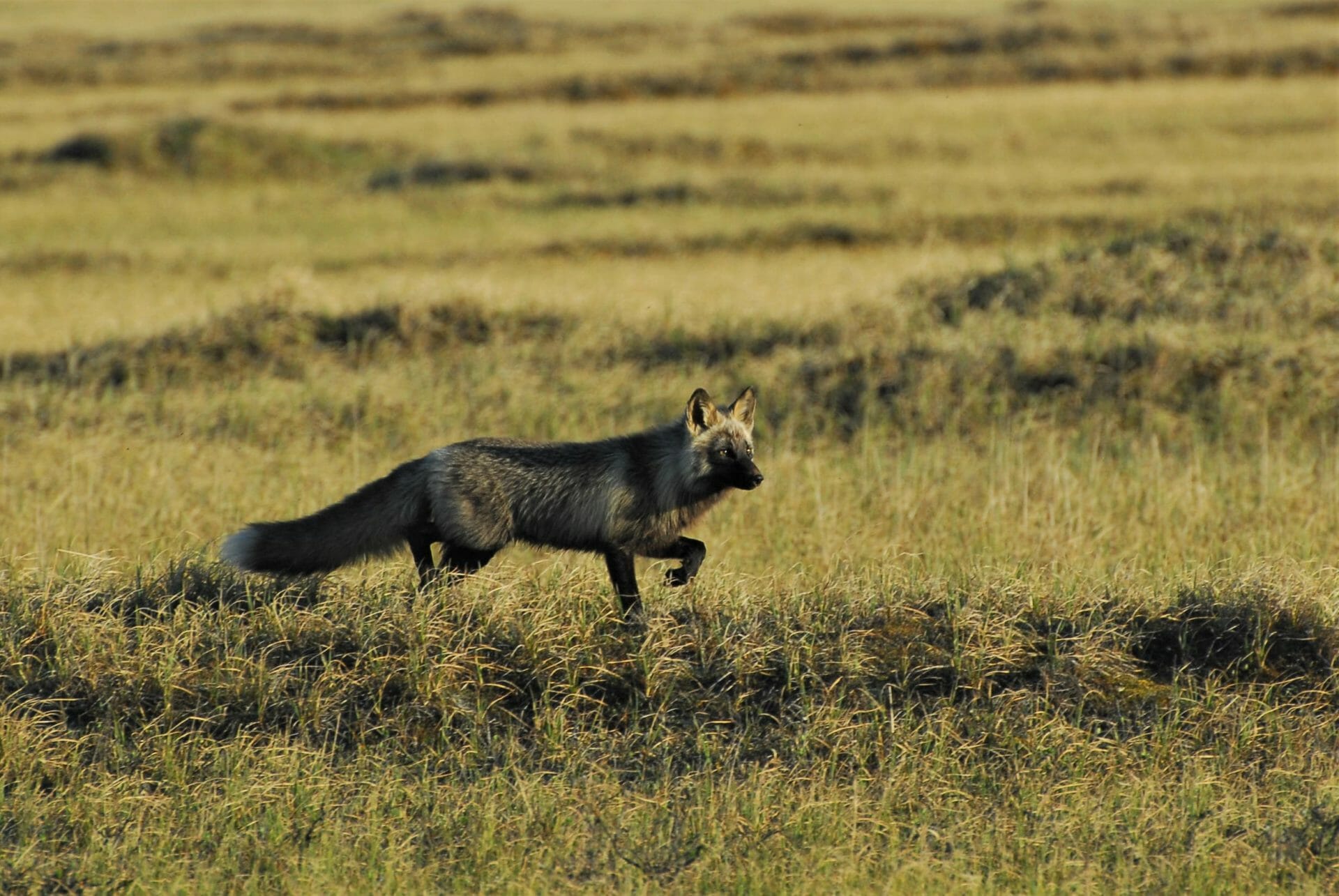
Noatak Canoe
The Noatak River is canoe camping at its best, with fun paddling, great wildlife encounters, and endless hiking opportunities.

Canning Canoe to the Coast
Wilderness adventure on the Canning River in the Arctic National Wildlife Refuge with Arctic Wild.
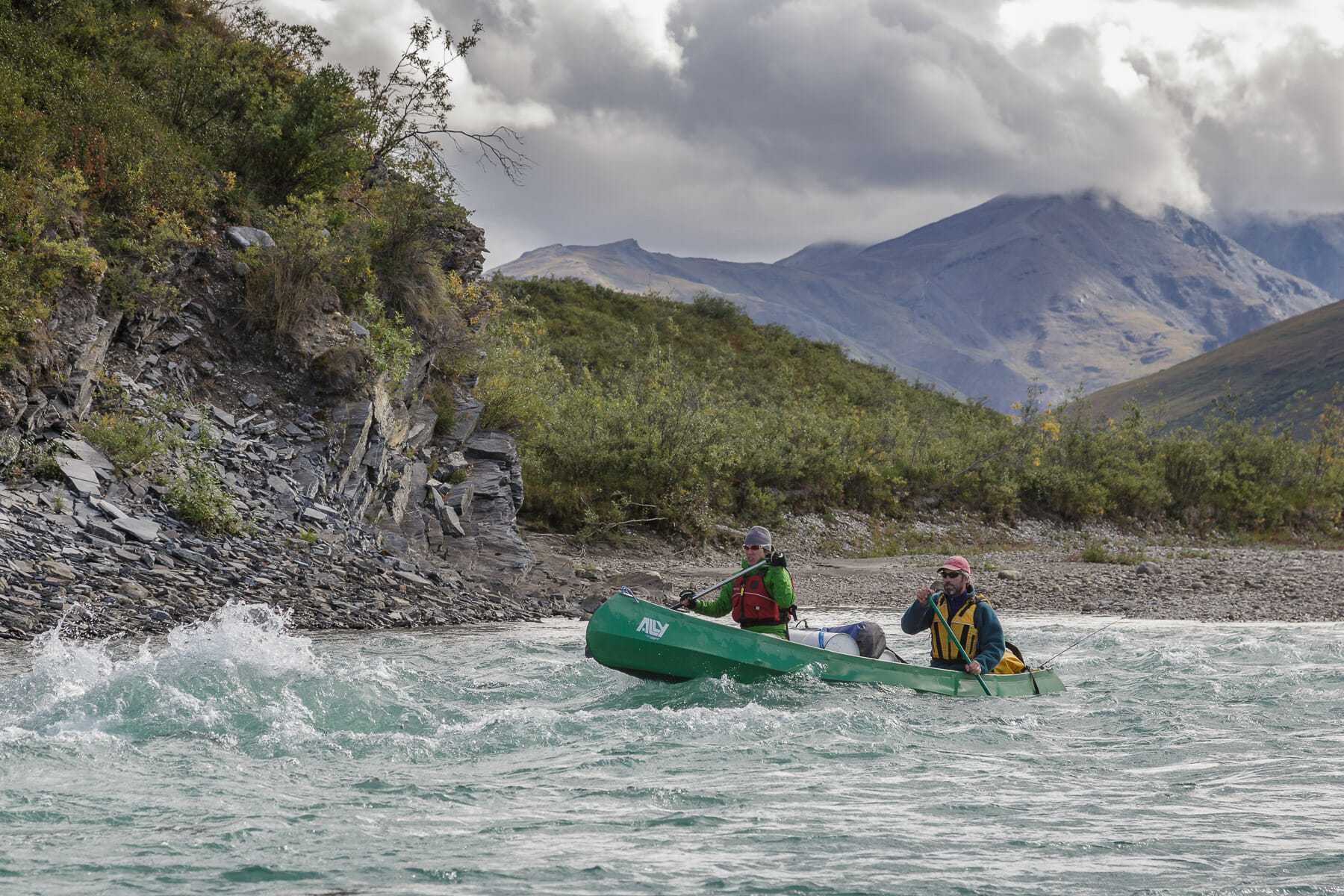
Canoes are the traditional mode of river travel in Alaska. The quiet and simplicity of Alaska river canoeing allows us to take in our surroundings slowly. Canoe trips offer the right speed, freedom and grace for navigating rivers like the Kokolik, and the legendary Yukon River. From Katmai National Park to the Gates of the Arctic and the Western Brooks Range, canoes are a great way to enjoy the wilderness.
What to Expect on an Alaska Canoe Trip
We have a fleet of 16 foot Norwegian made folding canoes and a few inflatable canoes. Depending on the size of the group, there will be one or two Arctic Wild guides on each trip, though not in each boat.
On “travel days”, everyone works as a team to make and break camp and to maneuver the canoes safely down the river. We plan all of our trips to maximize wildlife viewing and to provide ample time for leisurely picnic lunches, fishing and hiking.
Our Alaska river canoe trips frequently include one, two, or three layover days, spent exploring, fishing, bird watching or just enjoying the solitude and silence.
Preparing for your Canoe Adventure
We offer a variety of canoe trips for varying abilities. Trips like the Yukon River or Noatak River are suitable for most paddlers. Rivers like the Nigu or Canning require more experience with river canoeing. Our guides will provide canoeing instruction throughout the trip, so you do not need to be an expert paddler. Most of the paddling on our wilderness canoe trips is at a relaxed pace and no specific physical training is necessary, but being in decent shape physically will increase your overall enjoyment of the canoe trip. If you are interested in becoming a skilled canoeist prior to the trip, we are happy to arrange a course for you. Please contact us for details.

The guides were uncommonly knowledgeable, competent, hardworking, and they consistently took care of the group before taking care of their own stuff. They kept our safety in mind while staying open to suggestions, and allowing folks a lot of freedom for personal wanderings.
- Jim, Alaska, USA
Scheduled Trips
Filter by region.
- Western Brooks Range ( 0 )
- Gates of the Arctic ( 0 )
- Arctic National Wildlife Refuge ( 0 )
- Wrangell St Elias and Glacier Bay National Parks ( 0 )
- Yukon River ( 0 )
- Katmai National Park ( 0 )
FILTER BY MONTH
- April, 2024 ( 0 )
- May, 2024 ( 0 )
- June, 2024 ( 0 )
- July, 2024 ( 0 )
- August, 2024 ( 0 )
- September, 2024 ( 0 )
- Other Seasons, 2024 ( 0 )
- April, 2025 ( 0 )
- May, 2025 ( 0 )
- June, 2025 ( 0 )
- July, 2025 ( 0 )
- August, 2025 ( 0 )
- September, 2025 ( 0 )
- Other Seasons, 2025 ( 0 )

Arctic Wild provides professionally guided wilderness trips in Alaska's Arctic and beyond. Book your next adventure with us today for an unforgettable, life-changing experience.

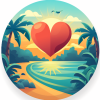
I Love All Inclusives
8 Most Unique Places to Kayak in the US – Stunning Beauty
Posted: May 28, 2024 | Last updated: May 29, 2024
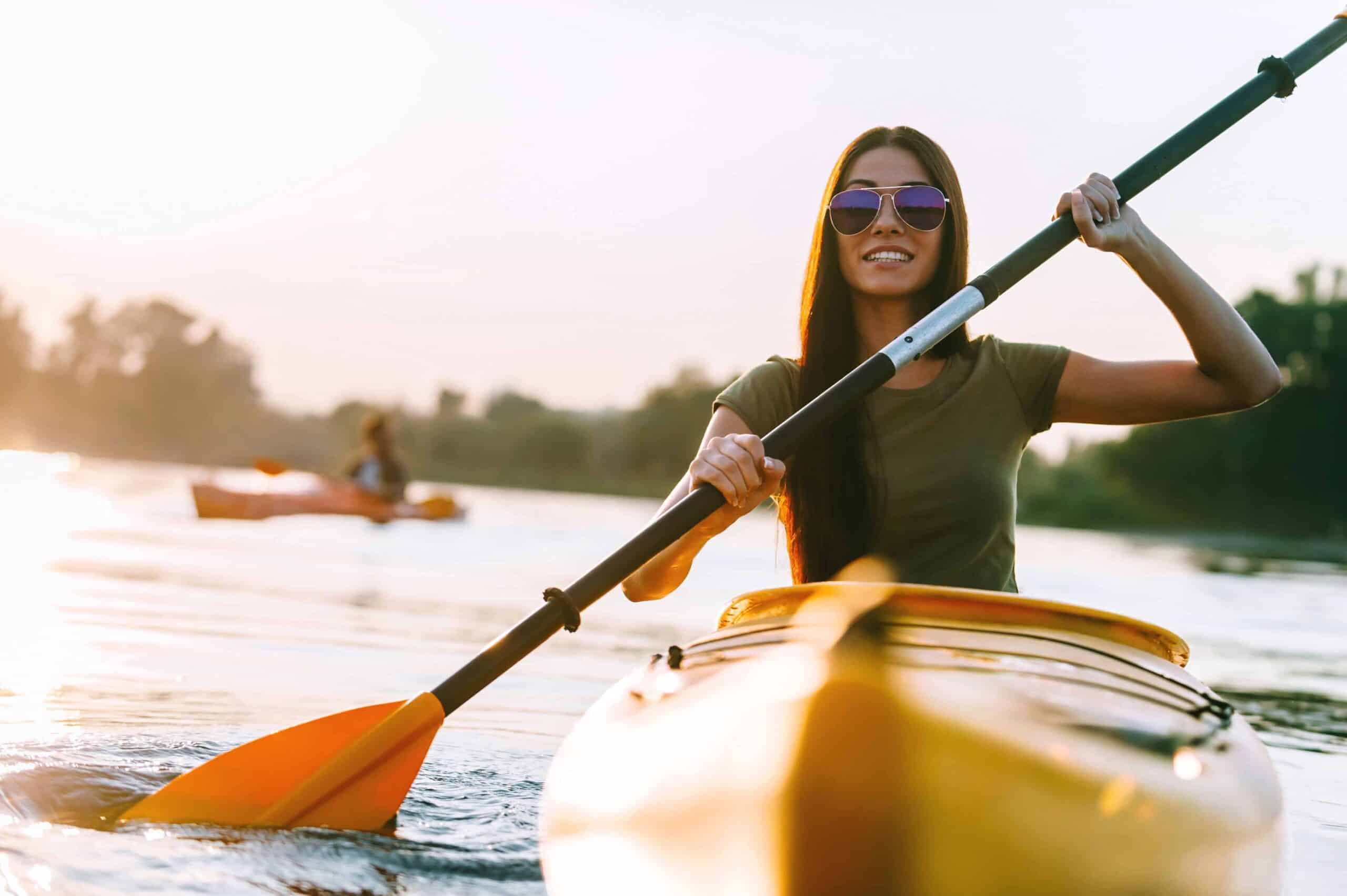
Kayaking is an exciting way to explore the natural beauty of the United States. With its diverse landscapes, the country offers many unique kayaking destinations for adventure seekers. From glacier-fed bays to wild rivers, there’s no shortage of places to paddle.
Whether you’re a seasoned kayaker or a beginner, there’s something for everyone on this list. So grab your paddle, and let’s explore the best kayaking destinations in the US!
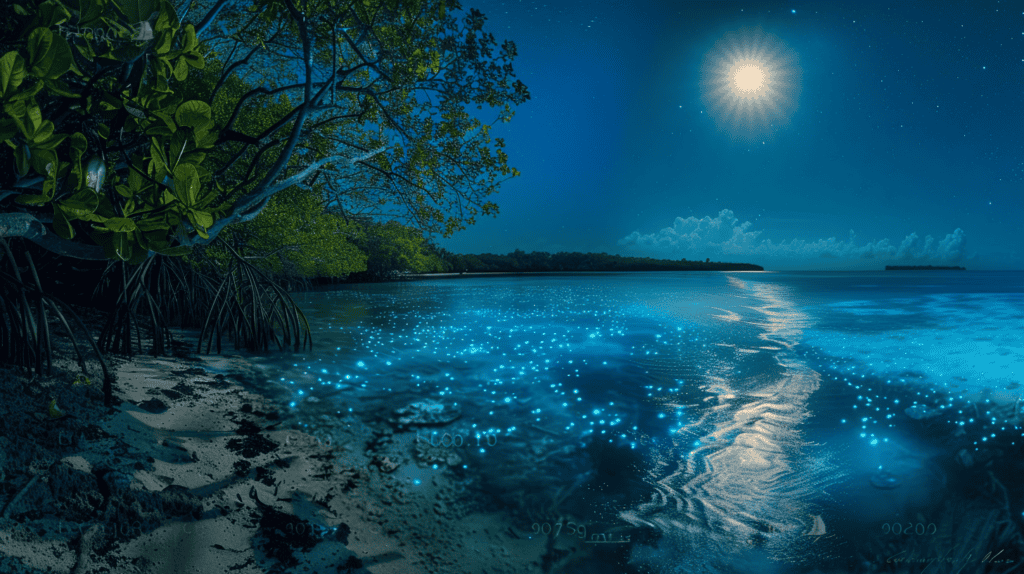
Mosquito Bay, Puerto Rico
If you’re looking for a unique kayaking experience, look no further than the bioluminescent bays in Puerto Rico . These natural wonders are home to tiny organisms called dinoflagellates that create a dazzling glow in the water at night. We recommend checking out Mosquito Bay on Vieques for the best bioluminescent kayaking experience.
Kayaking through the bioluminescent bays is a must-add to your water-based bucket list. The natural beauty of the glowing water is truly breathtaking and an experience you won’t forget.
Not only is it visually stunning, but the bioluminescent bays are also home to diverse marine life. You may see jellyfish glowing in the water or other fascinating creatures. Just be sure to respect the natural habitat and observe from a safe distance.
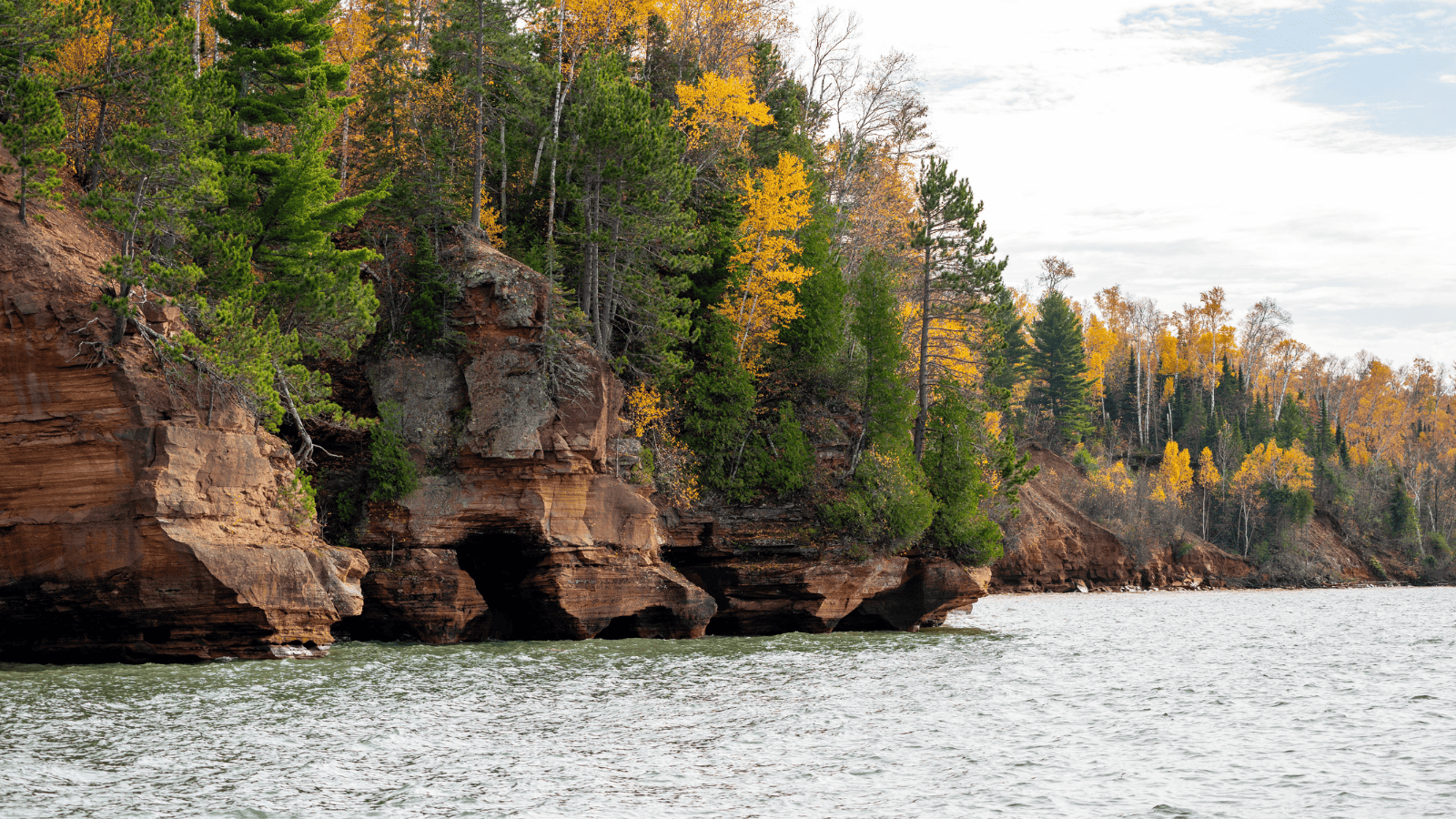
Apostle Islands, Wisconsin
If you’re looking for a unique kayaking experience in the US, the Apostle Islands in Wisconsin should definitely be on your list. The area is known for its rugged beauty, with 22 islands and over 800 species of plants. You can explore the area’s sandy beaches, sea caves, and rock formations while kayaking on Lake Superior.
The Apostle Islands are also home to a variety of wildlife, including eagles, bears, and wolves. Fishing is also a popular activity in the area, with opportunities to catch trout, salmon, and walleye. Whether you’re an experienced kayaker or a beginner, there are plenty of options for guided tours, equipment rentals, and safety classes.
Overall, the Apostle Islands offer a distinctive and enthralling kayaking experience for outdoor enthusiasts and nature lovers alike.
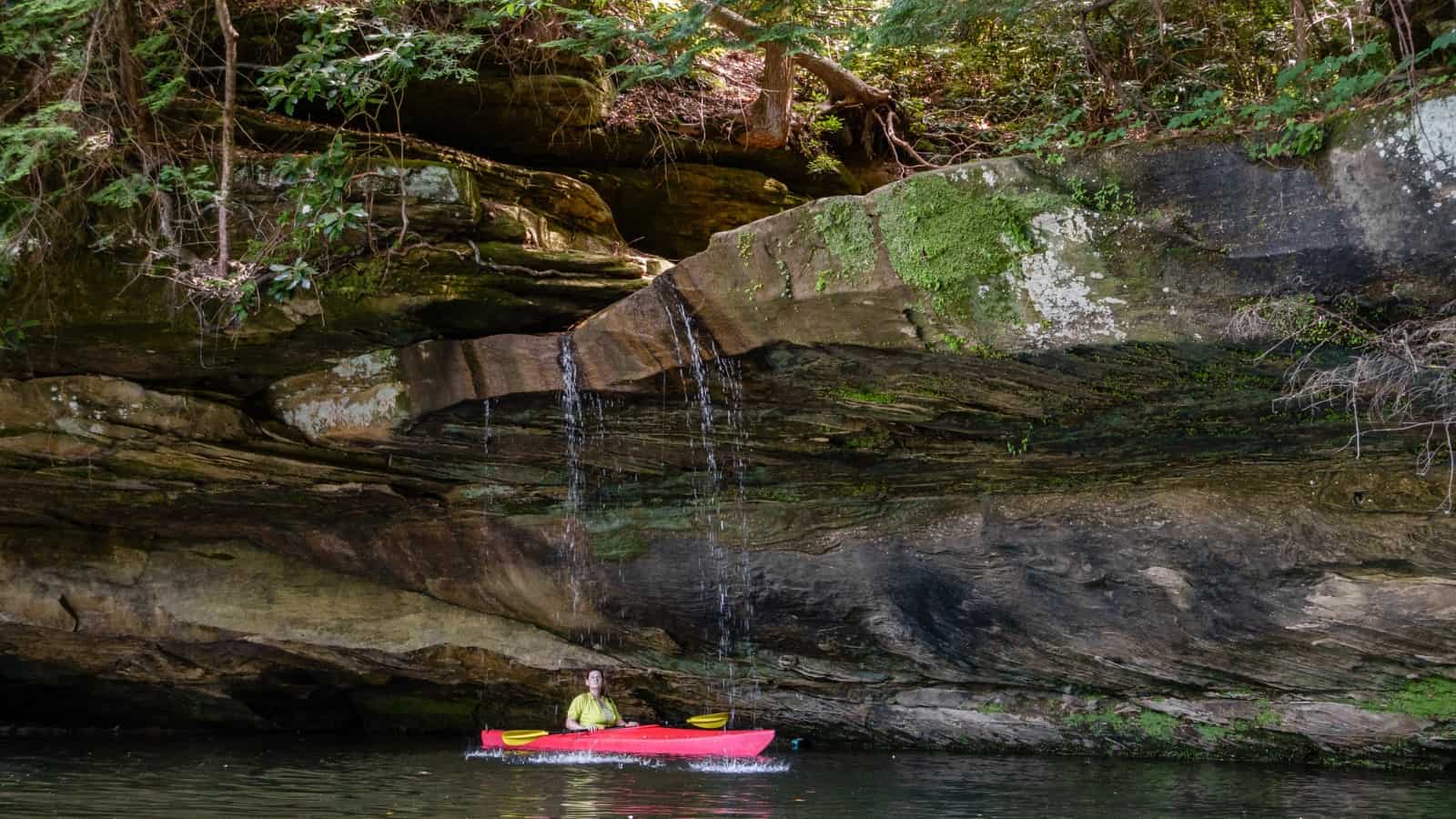
Red River Gorge Underground, Kentucky
If you’re looking for a unique kayaking experience, the Red River Gorge Underground in Kentucky is a must-visit destination. Here, you can paddle your way through the underground cave system, exploring the captivating features of the Gorge Underground.
Led by expert guides, this one-hour tour is perfect for both beginners and experienced kayakers. You’ll be provided with all the necessary gear, including kayaks, lights, paddles, personal flotation devices, helmets, and headlamps.
The tour is available year-round, but October is considered the peak time to make the most of the beautiful scenery.
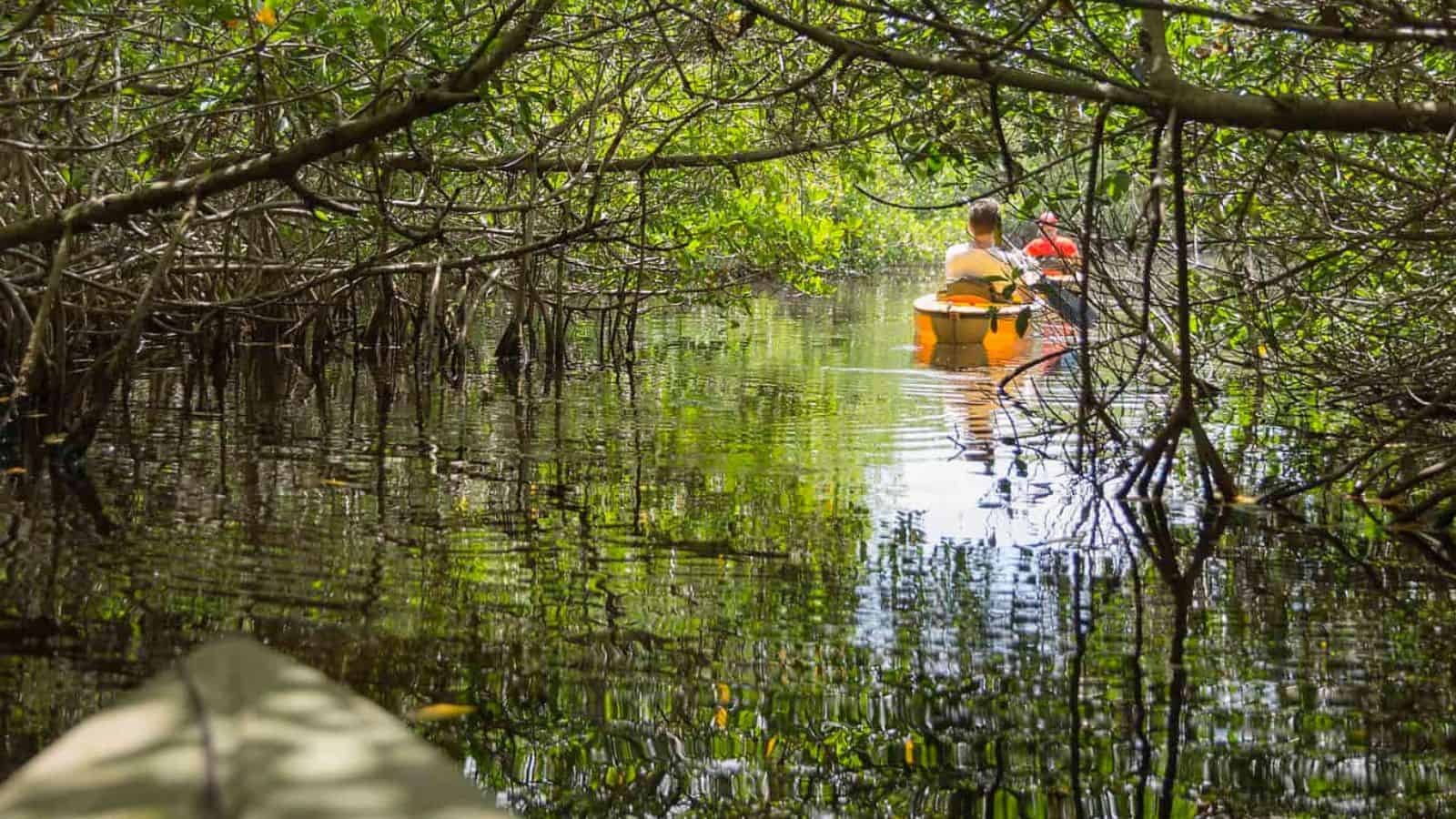
Everglades National Park, Florida
We highly recommend kayaking in the Everglades National Park for a truly unique outdoor adventure. With over 1.5 million acres of wetlands, this park is home to a diverse abundance of wildlife, including alligators, manatees, and a variety of bird species.
Paddling through the park’s mangrove tunnels is an unforgettable experience and a great way to get up close and personal with nature. If you’re an outdoor enthusiast, you’ll love exploring the park’s many water trails and fishing opportunities.
Just remember to respect the park’s fragile ecosystem and follow all safety guidelines when kayaking in alligator territory.
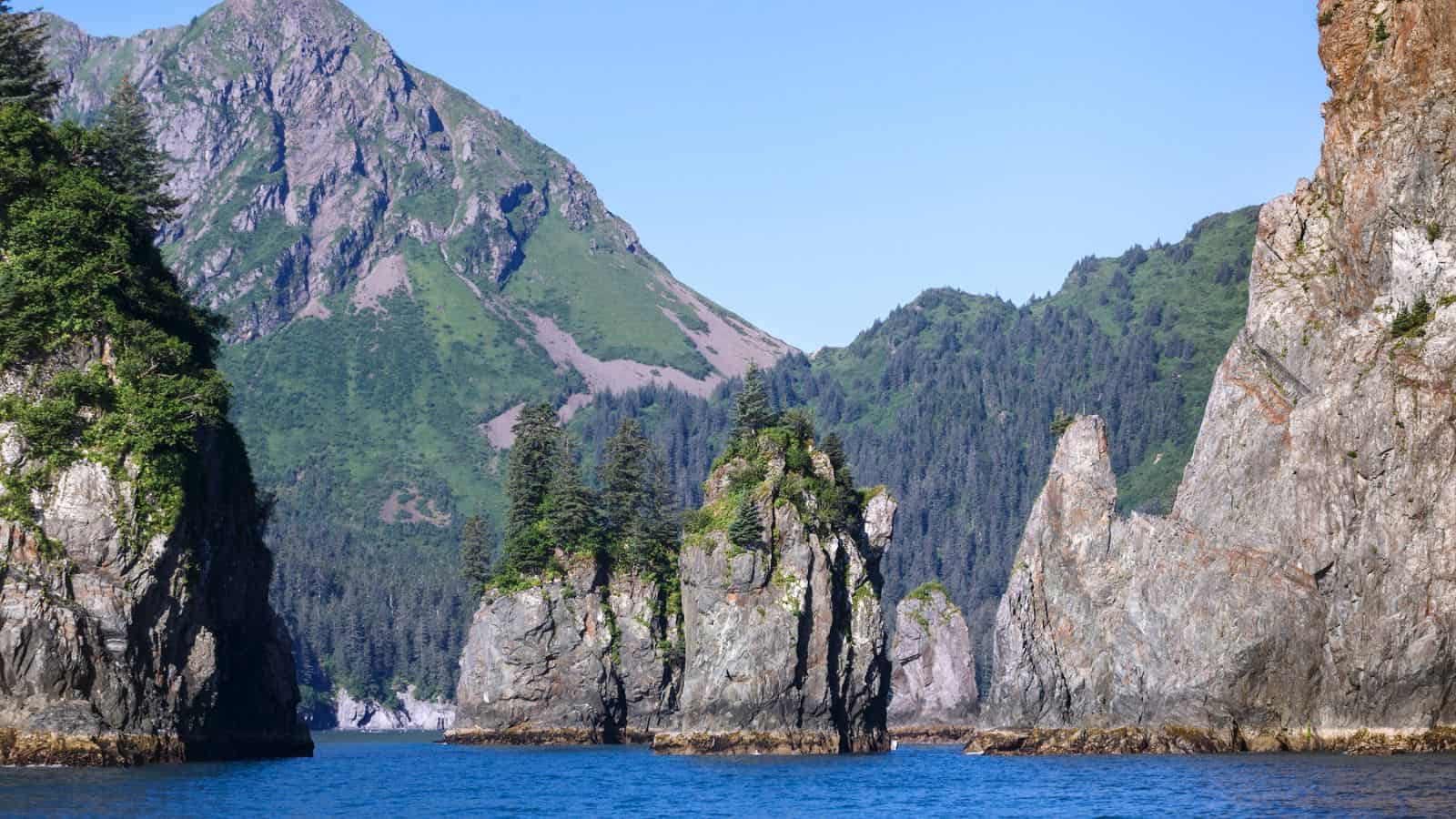
Kenai Fjords National Park, Alaska
If you’re looking for a kayaking experience that’s both unique and exhilarating, Kenai Fjords National Park in Alaska is a must-visit destination. With its dramatic mountains and crystal-clear waters, this park offers a once-in-a-lifetime experience for kayakers of all skill levels.
As you paddle through the park’s icy waters, you’ll have the opportunity to see a wide variety of marine life, including whales, otters, and sea lions. You might even catch a glimpse of a puffin or two!
For those who enjoy hiking, the park also offers plenty of opportunities for exploring on foot. With miles of trails winding through the mountains and along the coast, there’s always something new to discover. And if you’re feeling adventurous, you can even try your hand at whitewater kayaking in some of the park’s more challenging rapids.
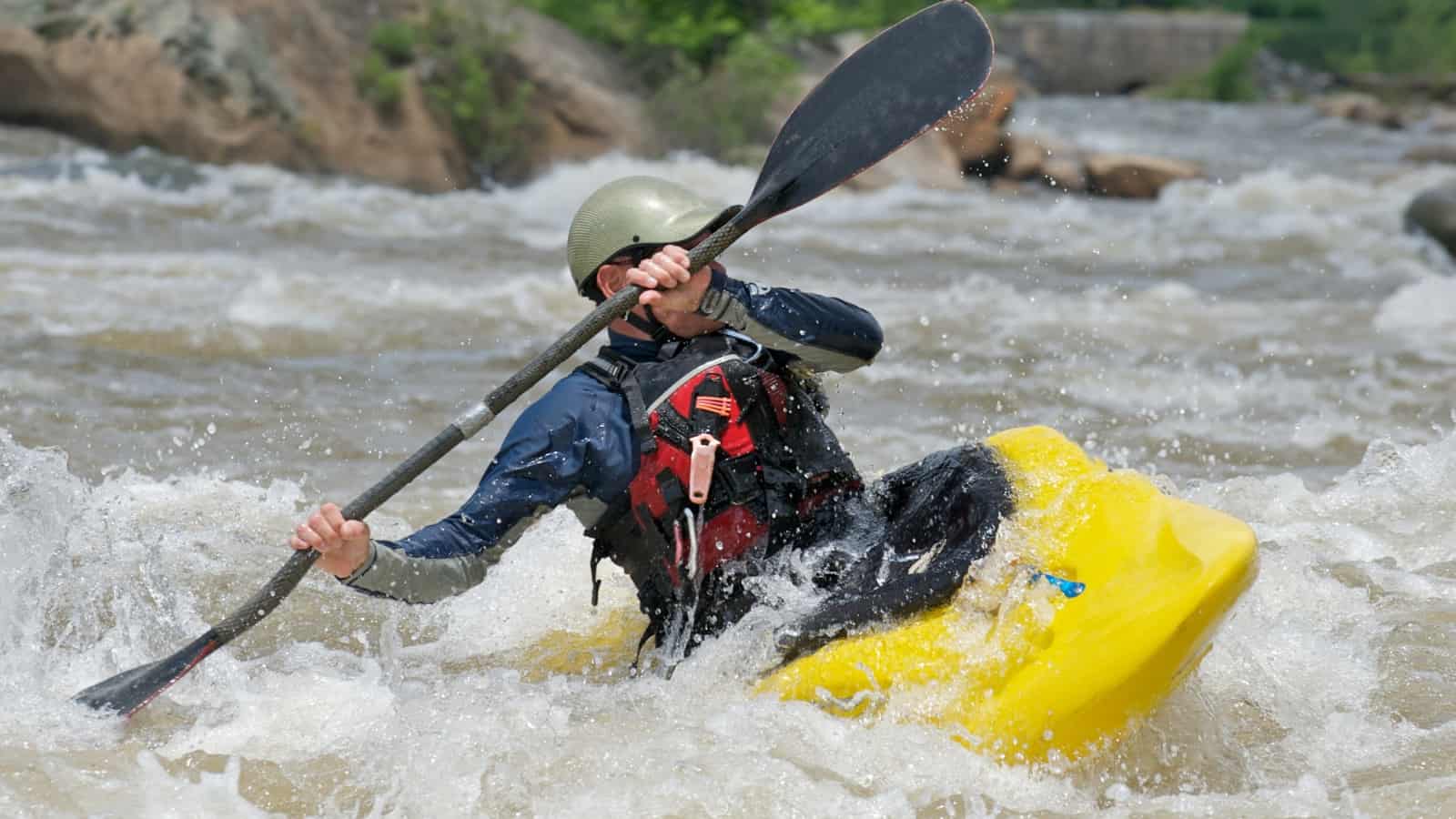
Devils River, Texas
If you’re looking for an adrenaline rush, kayaking in the Devils River in Texas is a must-try experience. The river is known for its crystal clear water, which makes it a popular spot for outdoor enthusiasts and nature lovers. With its challenging rapids and limited accessibility, kayaking in the Devils River is only recommended for experienced paddlers.
Apart from kayaking, the Devils River is also a perfect spot for fishing. The river is home to various fish species, including Largemouth and Smallmouth Bass, Catfish, and Sunfish. However, fishing in the Devils River requires a valid Texas fishing license, and it’s important to practice catch-and-release to preserve the river’s ecosystem.
Overall, kayaking in the Devils River is a unique and thrilling experience that every kayaking enthusiast should try at least once. Just make sure to plan ahead, bring all the necessary gear, and follow the rules and regulations to ensure a safe and enjoyable trip.
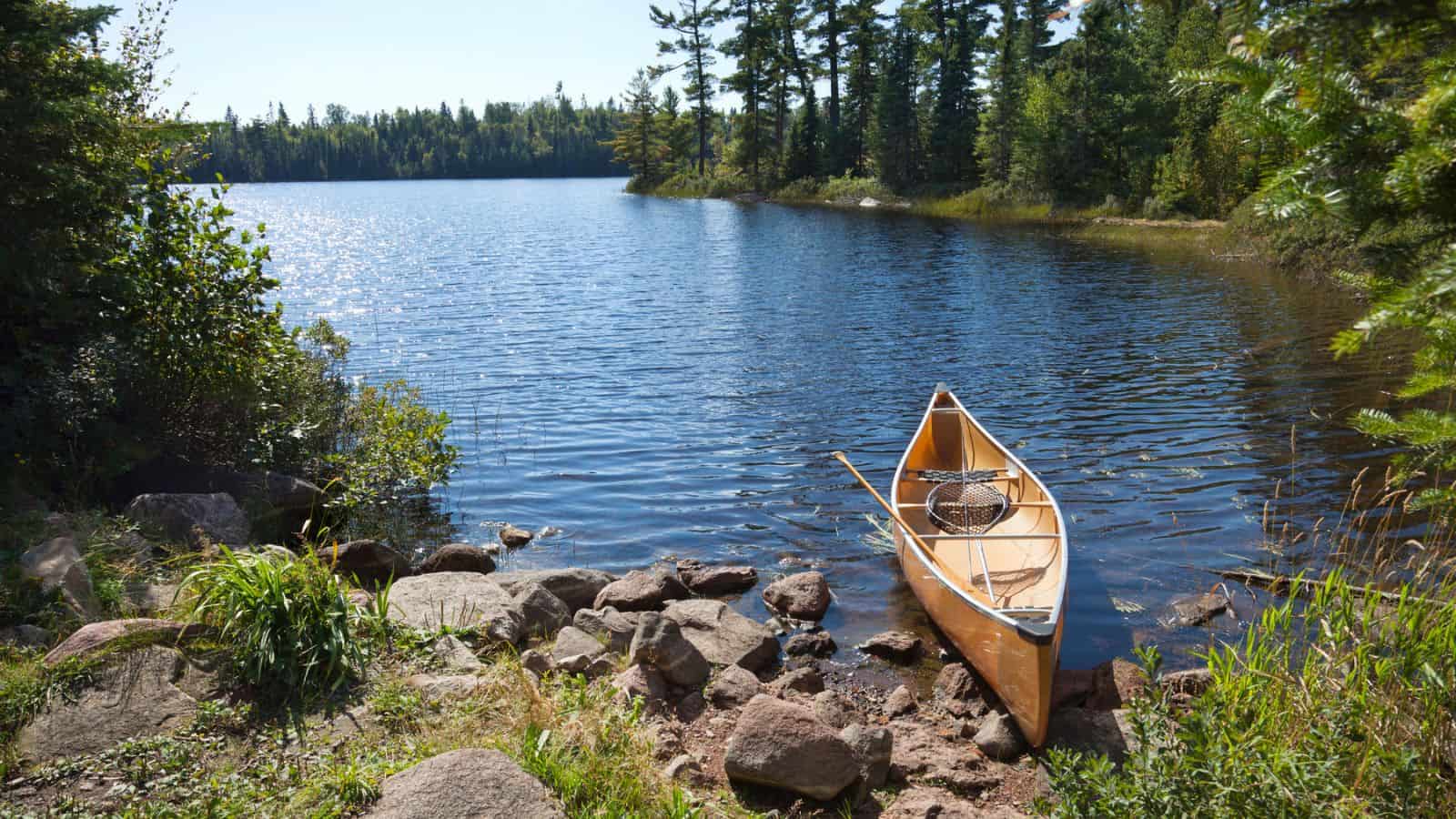
Boundary Waters Canoe Area Wilderness, Minnesota
If you’re looking for a unique kayaking experience, you can’t go wrong with the Boundary Waters Canoe Area Wilderness in Minnesota. With over 1,100 lakes and 1,500 miles of canoe routes, this vast wilderness area is perfect for multi-day kayaking trips.
As you paddle through the crystal clear waters, keep your eyes peeled for the area’s abundant wildlife, including moose and bears. And don’t forget to obtain the necessary permit before embarking on your journey.
If you don’t have your own kayak, don’t worry – there are plenty of rental options available in the area. Just be sure to factor in the cost of a rental when planning your trip.
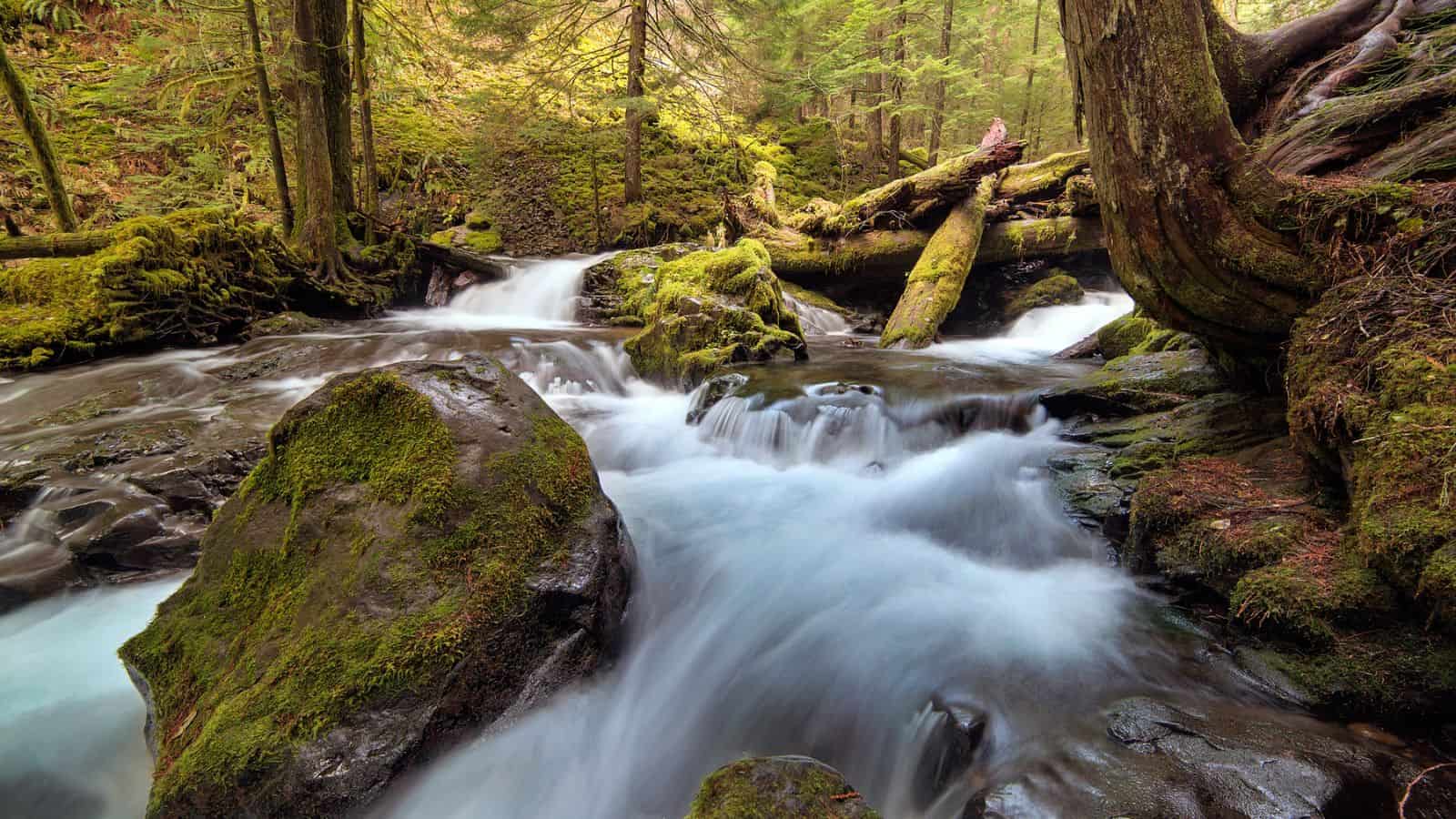
Columbia River Gorge, Oregon/Washington
We highly recommend kayaking in the Columbia River Gorge, which spans both Oregon and Washington. This protected scenic area is home to stunning waterfalls, scenic mountain vistas, and an abundance of nature.
For those who enjoy hiking, there are plenty of trails to explore, including the switchback-laced trail up Beacon Rock, which offers spectacular views of the Gorge from the top.
Kayakers can also explore the rock art found along the riverbanks, which offers a glimpse into the history of the area. And for those who appreciate engineering marvels, the Bonneville Dam is a must-see, with its impressive size and creation of a long lake on the Columbia River.
More for You
Stephen Hawking once gave a simple answer as to whether there was a God
Stephen King's Book Is Already Getting Rave Reviews
21 Survival Myths That Will Absolutely Get You Killed
This Is What a TSA Agent First Notices About You
10 Fast-Food Sandwiches From the ’80s That Have Vanished
Experts Say These Are The 5 Worst Foods For Your Cholesterol
17 Unusual Mormon Rules You Won’t Believe Are Real
A Smart Hack To Open A Can If You're Ever Without An Opener
Travis Kelce responds to being booed at NBA game with Patrick Mahomes
‘As confused as a goat on AstroTurf’: This retiree is mad his new spouse won't help pay for property taxes, maintenance and insurance — on a home she doesn't own. Who's right?
Stephen King Election Remark Takes Internet By Storm
Sleep experts say brushing your teeth right before bed is a common nighttime routine mistake — here's why
What Those Colored Circles on Food Packages Actually Mean
Indiana Fever Head Coach Sends Message To WNBA Refs About Caitlin Clark
Cowboys legend warns about drastic changes to Dallas' locker room atmosphere with Zimmer's arrival
Brad Pitt and George Clooney reunite for first time in 16 years in teaser for new thriller
Video Of Donald Trump Getting Booed Loudly During Speech Goes Viral
The Common Household Ingredient That Can Unclog Slow-Draining Sinks And Tubs
25 Things You Should Never Do With Your Money
Americans are finally catching on to Costco's tricks — here are 15 to watch out for so you don't get fleeced on your next trip
CampingBuffs.com
Pro Camping Tips, Gear and Reviews.

Essential Canoe Trip Pack List: Your Go-To Gear Guide for Paddling Preparedness
Ready for the ripple of water beneath your canoe but unsure of what to pack? This straightforward guide details the ultimate canoe trip pack list—everything you need and nothing you don’t for your on-water expedition. Gear up with confidence knowing you’ll have the essentials for both the paddle and the campfire.
Key Takeaways
- A well-chosen array of essential gear, including safety equipment and paddling necessities, is vital for a successful and safe canoe trip.
- Smart packing strategies, such as using dry bags for waterproofing and balancing the canoe’s load, are essential for efficiency and preventing gear from getting wet.
- Proper personal clothing, shelter and sleep systems, camp kitchen setup, and navigation and communication tools are key to comfort, safety, and enjoyment throughout the canoeing adventure.
Essential Gear for Your Canoe Trip

Embarking on a canoe trip is much like setting out on a great expedition. The canoe is your vessel, your paddles your oars, and a collection of carefully chosen gear your lifeline in the vast wilderness. Canoe tripping offers a unique way to explore and connect with nature, and canoe trips provide unforgettable experiences.
From the canoe itself to the paddles, safety equipment, and even the humble fanny pack, each item on your canoe trip packing list plays a crucial role in ensuring a smooth and safe journey.
The Canoe: Choosing Your Vessel
The canoe is the foundation of your adventure. Much like a sailor wouldn’t venture out in an unstable old ship, you must choose your canoe with care. The material, size, and weight can significantly affect your paddling experience, hence the importance of picking a model that aligns with your trip and skill level.
Whether you’re a seasoned paddler or embarking on your first canoe trip, a well-chosen canoe is a trusted ally on the water.
Paddling Essentials

Paddling a canoe resembles conducting an orchestra, where each stroke is a note and the paddle is your baton. However, orchestrating a successful canoe trip requires more than a decent paddle. Essential paddling equipment includes life jackets , spare paddles, and even a trusty fanny pack for those little extras.
These items ensure not only your safety but also your comfort and efficiency on the water.
Safety Gear Must-Haves
There’s an old saying among canoeists: “Safety first, because accidents last.” This couldn’t be more true. Essential safety gear like a first aid kit, whistle, and a throw rope is as important as your paddle or your canoe, and in many regions, a requirement to be on the water. These items are your safety net, ready to catch you when unexpected situations arise.
Packing Smart: Organizing Your Canoe Trip Gear

Similar to how a well-orchestrated symphony requires a skilled conductor, a successful canoe trip depends on smart packing. The goal? To fit your entire world – from your canoe to your camp kitchen – into a few dry bags and containers, without compromising on safety or comfort. And it’s not just about what you pack, but also how you pack it.
Dry Bags & Containers
Dry bags and containers are the unsung heroes of any canoe trip. These waterproof storage solutions are your first line of defense against the unpredictable elements, keeping your gear dry and organized despite the splashing water and sudden downpours.
From your cozy sleeping bag to your trusty first aid kit, every item in your canoe pack deserves the protection of a good dry bag.
Balancing the Load
Loading your canoe requires a balance akin to ballet – focusing on poise and precision. However, instead of executing pirouettes and pliés, you’ll grapple with dry bags, gear, and occasionally, the additional weight of a day pack. Distributing the load evenly across your canoe not only improves stability but also makes for easier and more efficient paddling.
Quick Access Items
In the world of canoeing, quick access items are the superstars. These are the items you’ll reach for without a second thought, whether it’s your water bottle during a strenuous paddle, your sunscreen on a sunny day, or a snack to refuel. Keeping these essentials within easy reach can make your canoe trip smoother and more enjoyable.
Clothing & Personal Items Checklist
In your preparations for the canoe trip, bear in mind that your clothing and personal items serve more than just being on a packing list – they essentially constitute your portable home. From your paddling gear and campsite wear to personal care essentials, each item plays a key role in ensuring comfort, safety, and enjoyment during your adventure.
Apparel for Paddling and Portaging

Whether you’re gliding through calm waters or tackling a challenging portage, the right apparel can make all the difference. Your paddling clothes should be:
- Quick-drying
- Comfortable
- Allowing you to move freely
- Protecting you from the elements
And don’t forget your portaging gear.
Just as a knight wouldn’t go into battle without armor, a canoeist shouldn’t embark on a portage without proper clothing.
Campsite Wear
After a long day of paddling and portaging, slipping into your campsite wear is like a warm hug. These are the clothes you’ll relax in, cook in, and sleep in. They should be warm, comfortable, and quick-drying, preparing you for chilly nights and dewy mornings. And with the right campsite wear, you won’t just feel great – you’ll look the part too. Be sure to check out our comprehensive camping checklist article here.
Personal Care Essentials
Personal care essentials may seem like a small part of your canoe trip packing list, but they’re vital for your comfort and hygiene. From toiletries and insect repellent to medications, these items ensure that you can take care of your personal needs even in the heart of the wilderness.
After all, a happy camper is a clean and comfortable camper.
Shelter and Sleep Systems
Much the same as a tortoise toting its home on its back, you’ll be transporting yours in your canoe. Choosing the right shelter and sleep system is crucial for a good night’s rest, preparing you for another exciting day of paddling. Whether you prefer the coziness of a tent or the freedom of a hammock, a good shelter can make your canoe camping trip all the more enjoyable.
Tents and Hammocks

Tents and hammocks are the two main contenders for your shelter of choice on a canoe camping trip. Each has its strengths and weaknesses, and the best choice depends on your personal preferences, the nature of your trip, and the camping conditions you’ll face.
Whether you choose the enclosed comfort of a tent or the open-air freedom of a hammock , make sure it suits your needs and provides a comfortable and safe place to rest at the end of the day.
Sleeping Bag and Pad
After a long day of paddling and exploring, your sleeping bag and sleeping pad are your ticket to a good night’s sleep. Choosing the right ones depends on the weather conditions, the weight you’re willing to carry, and your personal comfort preferences.
Whether you opt for the fluffy warmth of a down sleeping bag or the quick-drying convenience of a synthetic one, the right sleeping system can make all the difference in your canoe camping trip.
Extra Comforts
Sometimes, it’s the little things that make all the difference. Extra comforts like a packable pillow or earplugs might not seem essential, but they can significantly enhance your sleeping experience. After all, a well-rested paddler is a happy paddler, so why not add a touch of luxury to your wilderness adventure?
Camp Kitchen and Food Storage
Eating well is about more than just filling your stomach – it’s about fueling your adventure. Setting up a functional camp kitchen and packing the right food can turn meal times into a highlight of your day. But it’s not just about what you cook – it’s also about how you store it.
Cooking Gear and Utensils
An effective camp kitchen operates similar to a well-oiled machine, where every piece of gear has a role. From your stove to your cookware, each item should be easy to use, durable, and efficient. After all, the wilderness might be your dining room, but that doesn’t mean you can’t enjoy a good meal with the help of cooking oil.
Food Packing Strategies
Packing food for a canoe trip is a balancing act. On one hand, you want meals that are delicious and nutritious. On the other hand, you need food that’s lightweight, compact, and doesn’t require refrigeration.
The secret lies in careful planning and smart packing strategies.
Water Treatment
Water is the elixir of life – but in the wilderness, it can also be a source of danger. Ensuring you have safe, clean drinking water is vital, and there are various water filtration and purification systems that can help you achieve this, regardless of where your canoe trip takes you.
Navigation and Communication Tools
The thrill of a canoe trip lies in charting your own course and exploring the unknown. But to do so safely, you’ll need reliable navigation and communication tools. From traditional maps and compasses to modern GPS and satellite phones, these tools are your lifeline in the wilderness.
Maps and Compass
In this era of GPS and smartphones, the traditional map and compass may appear obsolete. But when you’re navigating remote waterways, they can be your best friends. Knowing how to use these tools effectively is a vital skill for any canoeist, and can make the difference between a successful trip and a disastrous one.
Emergency Communication
Being isolated on the water, far from civilization, necessitates the ability to call for assistance during emergencies. That’s where emergency communication devices come in. Whether it’s a satellite phone for remote areas or a personal locator beacon for serious emergencies, these devices can be a lifesaver on a canoe trip.
Additional Accessories and Repair Kits
As with any adventure, unexpected events often constitute the most memorable experiences on a canoe trip. But sometimes, the unexpected can also bring challenges. That’s why it’s a good idea to pack some additional accessories and repair kits.
From handy multi-tools to comprehensive repair kits, these items can help you tackle any surprises that come your way.
Useful Add-Ons
While the basics are essential, sometimes it’s the extras that can make your canoe trip truly special. These add-ons may not be necessary, but they can enhance your experience, making your trip more comfortable, efficient, or just plain fun without adding extra weight.
Repair Kits and Tools
Even with the best preparation, things can go wrong on a canoe trip. A sudden leak in your canoe, a broken paddle, or a tear in your tent can turn your adventure into a nightmare. But with a good repair kit and some basic tools, you can fix most issues on the spot and get back to enjoying your trip.
From the thrill of gliding through tranquil waters to the challenge of navigating uncharted territories, a canoe trip is an adventure like no other. But the journey is not just about the destination – it’s also about the preparation. So pack carefully, prepare thoroughly, and then paddle forth into the wilderness. The adventure awaits.

Frequently Asked Questions
How do you pack for a canoe trip.
When packing for a canoe trip, remember to pack essential personal items such as quick-drying clothing, a small towel, a lightweight long-sleeved shirt, sunscreen, and sunglasses to protect yourself from the elements and stay comfortable during your adventure.
What food is good for canoe trips?
Good options for canoe trips include snack foods like trail mix, beef jerky, carrots, peanut butter, bars, cookies, and fruit. Additionally, plan meals like taco soup, lentil chili, or spaghetti with meat sauce using dehydrated ingredients.
Where should you pack the heaviest items in a canoe?
Pack the heaviest items in the center and at the bottom of the canoe to maintain balance and maneuverability. Place medium-heavy items over the heavier gear and lighter items at the ends of the canoe.
What is the best month to go on a canoe trip?
The best month to go on a canoe trip is September due to less boat traffic and crowded campsites, despite the slightly increased risk of precipitation compared to July and August.
What kind of clothes should I wear on a canoe trip?
Wear quick-drying and comfortable clothes for paddling and portaging, and pack warm and comfortable clothes for the campsite. It’s also important to remember to bring personal care essentials.

Canoe Trip Pack List: 62 Essentials for Backcountry Camping
Are you planning a backcountry camping trip in North America this summer?
I have been on several canoe trips in Algonquin Park and know how overwhelming it can be to pack for a multi-day camping adventure.
Forgetting a single essential item can make your trip less enjoyable or even put your safety at risk. That is why I have compiled a comprehensive list of 65 essential items for your canoe trip pack list .

I have learnt these tips from my numerous camping trips to Algonquin Park in Ontario , plus with the help of experienced campers who have been canoe camping for over 15 years. You can trust that this list covers everything you need on your canoe camping checklist.
Whether you are a seasoned camper or a first-timer, this article is perfect for anyone planning an overnight canoe camping adventure in North America this summer.

Want to receive this canoe camping packing list as a printable or fillable checklist ?
Canoeing Trip Packing List
- Sleeping and Shelter
- Food and Water
- Safety and Navigation
- Personal Items
This portaging packing list is organised into categories.

Use the information in the categories above to learn about packing for a canoe trip in the backcountry.
Backcountry camping is a type of camping in which you have no access to running water, a toilet, mobile service, or electricity .
The main difference between backcountry camping and car camping is that you must carry all your belongings to the backcountry, either by foot or canoe.
Therefore, for backcountry canoeing, you need to pack as light as possible so it is possible to carry it.
You do not have to consider the weight and number of objects as much with car camping .
Sleeping & Shelter: Most Important Packing List Items
Some of the most important things on your packing list for canoe trips are items you will use for shelter and sleeping.
These overnight camping essentials may seem like luxury items, such as a sleeping mat or a pillow – but they will improve your sleep quality immensely.

Selecting the right tent is crucial to ensure a comfortable and safe canoe camping experience.
For extra comfort, bring a tent that can accommodate one more person than your group , as this allows for extra space for moving around and using the tent for changing or resting.
When looking for a tent, consider its durability and waterproof features to protect against weather conditions like rain and wind.
Additionally, the weight of the tent should be considered since it can be challenging to pack and carry a heavy tent on a canoe trip.
If you need more tips on choosing a tent, check out this tent guide on the REI website .
The tent we use is the MSR Hubba Bubba 3-Person Tent .
- Best Budget : NEMO Aurora Tent
- Best Luxury : MSR Hubba Bubba Tent
2. Trekking Backpack

Your canoe trip may involve hikes and portages to get to your campsite . Therefore, you need to bring a large bag that you can fill with essential canoe trip items , such as sleeping bags, a tent, equipment, and emergency items.
Ideally, you want a large rucksack that has padded shoulder straps for comfort.
Many portages, such as those around Lake Magnetawan , involve hiking for over 1km – which will take much longer than a regular 1 km hike, given you will be carrying heavy equipment.
You also need a waist strap on the bag to support your back and balance the weight of the bag.
If you purchase a high-quality trekking rucksack it will last many years. For example, we use these Gregory backpacks and they are around 10 years old.
- Best Backpack : Gregory Stout 60L Backpack ( men’s product available here )
3. Sleeping Mat

Depending on your budget, you can use a regular sleeping pad, which is like a yoga mat, or bring a self-inflating sleeping mat .
The latter will likely be more expensive but will protect your back more from feeling the rocky terrain.
Consider that if you are a side sleeper, you may need to find more specialist products because even with an inflatable sleeping mat, you will feel discomfort on your side.
The sleeping mat we use is Therm-a-Rest Prolite . It is self-inflating and easy to roll-up.
- Best Budget : Stoic Groundwork Sleeping Pad
- Best Luxury : Therm-a-Rest Prolite Sleeping Pad
4. Sleeping Bag
Another of the most crucial items on your overnight camping packing list is the sleeping bag.
There are several types of sleeping bag. You can choose a sleeping bag based on its features, such as its lowest suitable outdoor temperature and whether it is fit for males or females.
Take some time and research to discover which sleeping bag will work best for you.
For those based in Canada , MEC has an excellent selection of sleeping bags (our sleeping bags are from MEC).
- Best 3-Season Sleeping Bag : NEMO Disco 30 Sleeping Bag ( men’s product available too )
5. Camping Pillow

If you do not bring a pillow, you will soon see why a camping pillow is a necessity . Sleeping on a rolled-up piece of clothing will not be as comfortable as a blow-up pillow.
Camping pillows are packable, and many of them are inflatable, so you can adjust the firmness of the pillow.
The pillow we use while camping is NEMO Fillo Backpacking Pillow . You can adjust the firmness of the pillow using the inflation valve.
- Option 1 : NEMO Fillo Backpacking Pillow
- Option 2 : Sea to Summit Aeros Ultralight Inflatable Camping Pillow
Bring a long, strong rope to hang your food barrel from a tree branch.
Pack another rope to hang tarps or make clothing lines .

A tarp is an excellent item to add to your canoe trip gear list because it packs up small and can be valuable in case of rainfall .
You can set up additional space for daytime use or use the tarp to keep other items dry at night if there is no space inside your tent.
Therefore, make sure you purchase a heavy duty tarp that is fully waterproof.
You can various options for tarpaulin on Amazon or other camping equipment stores.
- Best Budget : Amazon Basics Waterproof Camping Tarp
- Best Luxury : Sea to Summit Escapist Tarp (Medium)
Food and Water: How to Prepare for a Canoe Trip

In this section of the canoe trip equipment list, you will find all the gear you need to help with eating and drinking while on a canoe camping trip .
You should pack enough food for the entire duration of your trip.
If your backcountry camping trip exceeds three days , you should bring dehydrated or freeze-dried food ; otherwise, the fresh food you took may not stay fresh.
Large water containers are heavy to carry in addition to your other canoe expedition gear.
So, aside from the water you already have in your water bottle, you will need to use other water sources for drinking and brushing your teeth.
Nonetheless, you cannot drink directly from most lakes due to the risk of giardia (beaver fever). The bacteria from the water can cause some severe side effects. You need to make sure you purify any lake water before drinking it.
Some destinations, such as deserts, do not recommend attempting to purify and drink their water because it can clog filters. Therefore, you will need to bring large containers of water. Remember to bring enough water for drinking, cooking, and brushing your teeth.
8. Water Filtration System

A gravity bag is an excellent way of filtering lake water and making it potable. Water is abundant while canoeing; therefore, gravity bags are a great option to use to make drinking water.
A gravity bag is more expensive than other water purification methods, but consider it an investment because you can use it for many camping trips to come.
This is the water gravity bag we use on our backcountry camping trips.
- Best Budget : Katadyn BeFree 3.0L Water Filter
- Best Luxury : Platypus GravityWorks 4.0L Filter System
9. Water Purification Tablets
These tablets are a compact and low-cost way (in the short-term) of purifying your water so it is safe to drink. However, purifying tablets can make the water taste a little different to normal, so you may prefer to use another water filter method.
It is advised to bring some water purification treatment tablets as a backup in case your gravity bag water supply fails. In this case, you will still have a method of drinking clean water.
- Aquatabs 49mg Water Purification Tablets
10. Camp Stove

Another significant item to add to your canoe trip pack list is the camping stove. This piece of gear is essential to your survival while camping, particularly if you have no access to a fire pit for cooking.
Once you have bought a stove, you should also guarantee you know how to use it.
If you have not used your camp stove since your last camping adventure, check it is working before you embark on your next canoe trip.
- Best Budget : MSR Pocket Rocket 2 Stove
- Best Luxury : Jetboil MiniMo Camping and Backpacking Stove
11. Kitchen Cookware

A good set of cookware, including knives, forks, spoons, plates, a saucepan, and a frying pan, will make meal preparation and serving a smoother experience in the backcountry.
Instead of bringing so much cutlery, you could also purchase a spork – a cross between a fork and spoon.
It is beneficial to have a cookware set that packs up inside itself.
If you are purchasing an MSR stove, there are often bundles that include some cookware.
- Stove and Cookware Bundle : including Sauce Pan, Deep Dish Bowls, two Insulated Mugs, Strainer Lid, and two Folding Sporks.
- Jetboil Frying Pan
- MSR Kitchen Utensil Set – includes Folding Spoon, Spatula, Ultralight Cutting Board, Salt & Pepper Shaker, Squeeze Bottle and Dish Towel.
In addition to knives used for eating, you need a sharper knife to cut food such as fruit or vegetables.
13. Bear-Proof Food Containers

A food barrel will keep your food safe from bears and the elements while you are on the water or in the backcountry.
It is also a great way to organise your food and keep everything in one place. You can also use it to store other scented toiletries.
When packing your food barrel at home, review the order you pack your food, with the items you will need first at the top.
A food barrel is heavy and difficult to carry when full. It is recommended to attach straps to carry the barrel like a backpack to make portages easier and allow your hands to be free to carry other objects, such as paddles.
- Food Barrel (MEC Canada)
- Straps for Food Barrel
It is also possible to purchase bear-proof bags and bear resistant food containers . These can fit inside your other backpacks and will keep your toiletries and food safe.
14. Water Bottle
Staying hydrated is essential when canoeing and camping. Bring a reusable water bottle to refill as needed along the way.
Even though insulated water bottles are good for keeping your beverage cold, I suggest bringing a lightweight plastic bottle. Plus, you will want a wide-mouth water bottle in which you can easily place an electrolyte tablet .
15. Empty Plastic Bag
Be sure to pack out everything you bring in. An empty plastic bag for waste will help you keep your campsite and the surrounding wilderness clean.
Remove packaging from new items before you leave for camping so you do not have unnecessary trash on you.
16. Espresso Maker
If you cannot go a day without coffee, you can bring a small espresso maker. It may be challenging to bring milk, so you need to drink it black.
17. Lighter
Starting a fire is essential for cooking and staying warm. Be sure to bring a lighter, as well as a backup option, such as additional lighters or waterproof matches .
18. Collapsible Sink

When backcountry camping, a collapsible sink is a useful to wash your dishes.
Washing dishes near your campsite or water source can contaminate the environment and attract wildlife. Therefore, a packable kitchen sink is handy to contain your dishwater and move it somewhere safe for disposal.
Collapsible sinks are lightweight, easy to pack, and a great item to add to your wild camping kit list.
- Best Budget : Flat Pack Sink
- Best Camping Dish Wash Station : Sea to Summit Collapsable Wash Bag
Safety Items: Canoe Camping Gear List

Some items on this canoeing equipment list are for an emergency; therefore, you hope that you will not have to use them.
Whereas, other canoe camping gear is essential; such as flashlights, a hatchet to cut wood, and a map to keep on the right path.
As well as possessing these items, you need to be up to date on your bear safety.
Many destinations across North America, such as Banff and Algonquin Park are home to bears.
You can read about being “ bear wise ” here.
Rent canoes if you do not have one. It is a major piece on a canoe gear list.
Once you have determined where you will be backcountry camping, you should investigate canoe rentals.
If you will be camping in Algonquin Park, I have given recommendations for canoe rentals for Rock Lake Access Point and Magnetawan Lake Access Point .
20. Paddles
Just as with canoes, you must bring or rent paddles to steer and propel your canoe.
Each person needs a paddle.
21. Personal Flotation Device
Many parks require you to wear personal flotation devices, also known as PFDs, or at least have them in your possession. A lifejacket can save your life in case of an emergency.
Canoe and paddle rental companies will give you lifejackets to wear for your canoe camping trip.
22. First Aid Kit

Accidents can happen, and having a first aid kit can help you take care of minor injuries, such as blisters and cuts.
Consider the number of people on your camping trip and how many days you will be camping for. As you can see in the adjacent image – the medical kit we took was enough for two people on a two day trip.
Check you also have painkillers and anti-inflammatory drugs in your first aid kit.
If you use anything from your medical kit while backcountry camping, make sure you replace it for the next trip.
- Adventure Medical Kit
Even if you visit your place of backcountry camping often, you should bring a map so that any group member can use it if needed.
Have it in a waterproof case so it will not be ruined by rain or dropped in a river.
When the sun goes down, it gets incredibly dark in the backcountry when all you have is the moonlight. You will need a reliable light to navigate in the dark and find your way around camp.
A flashlight or headlamp is useful for walking around the campsite in the evening.
A lantern is good for putting around the camp or inside your tent when winding down for the evening.
25. Hatchet and/or Sledgehammer
These tools will come in handy for preparing firewood. Plus, a sledgehammer can be used to hammer tent pegs if the ground is hard.
26. Compass
A compass can help you navigate and stay on course when you have no service.
27. Firewood
Verify whether there is a fire ban in the park before you enter.
You may not even need firewood if you have brought your camping stove. Although, if the weather is good, you can rely on wood that you gather on your camping site for cooking.
If there is no fire ban, buy wood from the park office. You cannot bring wood from outside the park.
Clothing for a Overnight Canoe Trip Packing List

When deciding what to wear on a canoe trip, bring the fewest number of clothes possible .
For shorter trips, less than three nights, you can typically get away with the daytime clothes on your back, plus an extra set in your pack.
After a few days of no access to showers on overnight canoe trips, you will embrace wearing the same clothes.
Although, you may wish to leave an extra outfit in the car for the end of the trip to travel home without smelling like a bonfire or sweat.
Keep an eye on the weather forecast in the days approaching your canoe trip. The weather can change quickly, but the forecast should indicate if you will face cold or hot temperatures or rainy conditions.
The best kinds of fabrics for backcountry camping in summer are lightweight and quick drying ; for example, exercise shirts from Lululemon or swimming trunks for men.
However, do not bring any of your best clothing that you would not like to get damaged or stained in case of any accidents or that is not easily replaceable if needed.
Read on to find all the items of clothing that should be on your backcountry camping overnight checklist.
28. Dry Bags

Before you pack any clothes on your canoe camping list, you need a waterproof bag to put them in.
Dry bags are the best for storing items that need to stay clean and dry. They are waterproof and the top folds over to stop any water from entering if the bag falls out of your canoe or kayak.
SealLine is a reputable brand of dry bags.
You need dry bags in varying sizes, for example smaller ones for your clothing , and a larger one (with straps) for sleeping bags .
- Best Large Dry Bag: 65L SealLine Dry Pack with Straps
- Best Small Dry Bag: 10L SealLine Dry Bag
29. T-Shirts
Ideally, you will bring short-sleeve t-shirts in a sweat-resistant fabric .
Full-sized t-shirts are best for canoeing because they will cover your shoulders , which can burn on a sunny day. Plus, the material will make you feel fresher for longer.
Some suggested brands for this kind of t-shirt include: Lululemon and Adidas.
- Ladies ‘ Crew T-Shirt from Lululemon
- Ladies ‘ Running T-Shirt from Adidas
- Men’s Drysense Short Sleeve Shirt from Lululemon
Shorts are typically the best clothing to wear as bottoms for canoeing. It can get warm and sweaty on summer canoe trips.
Plus, it is common to splash water on your legs when paddling, so it will dry quicker on your bare legs and shorts than on trousers.
Quick-drying shorts are better than cotton shorts.
- Ladies ‘ Mid-Rise Lined Shorts from Lululemon
- Men’s Baggies Shorts from Patagonia
31. Warm Sweater
Even though you are going on an overnight canoeing trip in summer, it can still get cold at times. You will likely need to wear a sweater, or another long-sleeved layer, such as a fleece, to keep warm once the sun has set .
Additionally, covering your arms in the evenings will help prevent mosquito bites .
It is best not to wear the same clothes to sleep in that you have cooked or eaten in (in case of any smells or remnants of food left on the materials) at night due to bears.
Therefore, ensure you have a warm enough sleeping bag or another long sleeve layer to wear for sleeping if you get cold easily.
- Gender-Free Crew Sweatshirt from Roots Canada ( available on US website here )
32. Long Pants

Another item of clothing that is good for canoeing trips is a pair of trousers, that are not jeans. This type of long pants is handy for evenings, when the temperature is cooler, and the mosquitos are out.
Leggings are typically too thin to stop mosquitos from biting through the material, so they are not the best trousers to wear in the evening on camping trips.
Sweatpants or other exercise trousers, such as these Lululemon trousers are better options for camping .
- Ladies ‘ Stretch High-Rise Pants from Lululemon
- Men’s Training Joggers from Lululemon
33. Leggings or Long Johns
It is recommended to bring leggings or other thermal pants because they are good for sleeping . If you think you may get cold legs at night, it is best to pack a pair of leggings.
I usually start by wearing leggings as it is cold at the start and middle of the night. By morning, you may want to wear shorts.
The best quality leggings for ladies, in my opinion, are from Lululemon .
- Ladies ‘ Align Leggings from Lululemon
- Men’s Thermal Leggings from Icebreaker
34. Bathing Suit
You will need some swimwear on your backcountry camping trip for several reasons. Firstly, after a long, hot portage, a refreshing dip in the lake may be just what you need. Secondly, swimming may be the only way to wash yourself during your camping expedition.
Ladies, bring a two-piece if possible because it will dry quicker and it will make going to the bathroom easier if you are exploring while wearing your bikini.
35. Daytime Socks

It is important to bring enough socks for each day to wear during the daytime because you might find your socks will get damp and sweaty.
You may prefer to wear active-wear socks as these will cope better with the dampness of the foot from hiking and paddling.
Also, check that your socks cover your whole heel to avoid getting blisters .
It is best to wear socks that come just above the ankle because it will help protect them against potential scrapes while hiking .
- Ladies ‘ Hiking Socks from Lululemon ( socks available for men here )
36. Warm Socks
I recommend bringing some thicker socks that you can wear in the evenings to cover your ankles from mosquitoes. Plus they are good to keep your feet warm at night .
Roots is my favourite shop to buy these types of socks from.
- Cabin Socks – 2 Pack
- Cabin Ankle Socks – 2 Pack
37. Underwear
This is self-explanatory, but bring enough underwear for the entire duration of your trip.
Men – you may be fine with wearing swimming trunks while canoe camping. But think about nighttime and other times you will not be wearing swimwear.
Ladies – sports bras are better than regular bras because they will hold up well to sweat. You can wear bikini tops the whole time, but you may want better support while carrying the canoe/equipment on portages or paddling.
38. Rain Jacket
You should bring some rain gear, even if it does not look like rain is in the forecast during your canoe trip.
Rain jackets are usually easy to roll up small into a bag. Plus, you can use your raincoat as an extra layer if it gets cooler.
- Best Luxury : Arcteryx Beta Rain Jacket ( Beta LT for Women ) ( Beta Lightweight for Men )
- Best Budget : North Face Rain Jacket ( Antora Jacket for Women ) ( Antora Jacket for Men )
Wide-brimmed hats are great for canoe camping because they cover more of the face and neck than baseball caps. However, a baseball cap will also work if that is what you already own.
If you already own a wide-brim hat from a safari or other similar trip, bring it.
Check the night-time temperature because it is chillier at night. If so, you may want to bring items such as a knitted hat or gloves – but this is more for spring and fall trips .
- Women’s Wide Brim Bucket Hat from Lululemon
- Sinsola Sun Hat from Arcteryx
- Abisko Sun Hat from Fjallraven
- Roots Baseball Cap from Roots
40. Sunglasses
Sunglasses will be another one of your canoe trip essentials. Do not bring your favourite pair of sunglasses in case they get lost or broken. However, make sure that the sunglasses you bring have sufficient UV protection .
You may benefit from having a string/rope to secure them around your neck when you are not wearing them.
- Sunglasses Strap
41. Old Running Shoes or Hiking Shoes
The best canoe trip shoes are durable and comfortable, but also you should be fine with them getting a little wet.
There are occasions while camping that you may accidentally step in water when getting in and out of the canoe. Therefore, you should be fine with wearing the shoes in water , or they should be able to withstand the wetness.
I suggest bringing an old pair of running shoes or sturdy hiking shoes.
I wore my Blundstone Boots when camping but I got bad blisters from the rigorous portages, so I would not recommend wearing these if you are prone to blisters.
- Women’s Hiking Shoes from Merrell ( Men’s version available here )
42. Campsite Shoes
You will need shoes to wear around your campsite, such as sandals. Campsite shoes give your feet a rest and a breath from the trainers you wear during the day.
I would avoid bringing flip-flops because it is tough to wear these with socks on, which you may want to do in the evenings.
A solid pair of sandals, such as Tevas are beneficial because they also can be used for walking and canoeing.
- Teva Sandals for Women ( Men’s version available here )
- Keen Sandals for Women ( Men’s version available here )
Toiletries: What to Pack for Backcountry Canoeing
43. biodegradable soap.

It is essential to bring biodegradable soap because it will decompose more quickly in the wild than conventional soaps.
Read about other best practices for camping and how to respect the environment, follow the Leave No Trace principles .
You will use soap to wash your dishes and to wash your body. It is one of the biggest must haves for tent camping.
- Best Budget : Campsuds Biodegradable Soap
- Best Luxury : Dr Bronner’s Pure-Castile Liquid Soap
44. Toothbrush and Toothpaste
Keeping your teeth clean while camping will help you feel fresher while away from many basic amenities. It is recommended to bring a manual toothbrush rather than an electric toothbrush.
Plus, those small travel tubes of toothpaste are handy to keep your toiletries as light as possible.
45. Sunscreen
Protecting your skin from harmful UV rays is especially when canoe camping because you may spend much of the day in direct sunlight. Facial sun cream should contain SPF 50 .
Spray sunscreens are good for the rest of the body because they can be applied while on the go. You may get sweaty while portaging or canoeing, so choose the thicker sports suntan lotions so it stays on for longer.
Here are my favourite brands of facial sunscreen:
- La Roche Posay Face Sunscreen
- Cetaphil Face Sun Protection
46. Deodorant
Do not forget basic hygiene while camping. Unscented deodorant is best to avoid attracting insects.
47. Antihistamine
If you are prone to mosquito bites, antihistamines will help relieve symptoms caused by bites, stings, or other allergens.
48. Bug Spray
Mosquitoes and other insects can be a nuisance in the backcountry, particularly while in wooded portages. You will need to apply insect repellent liberally to keep them at bay.
- OFF! Deep Woods Insect Repellent
49. Medication
Be sure to bring any necessary medication for your personal needs, such as prescription medication.
50. Antiseptic Cream
For minor cuts and scrapes, antibiotic ointment can help prevent infection. Polysporin and Neosporin are commonly found in North America.
51. Toilet Paper
Bring several rolls of toilet paper. You can buy toilet roll for camping that is designed to be biodegradable and environmentally friendly.
52. Tissues
Tissues are always handy for various uses. You can bring a small travel pack.
You will need to take your used tissues home with you.
53. Hairband
If you have long hair, it is a good idea to bring a couple of hair ties to keep your hair out of your face during physical exercise.
54. Hairbrush
You will likely wear a hat for the entire camping trip, but you should bring a compact brush or comb to keep your hair tangle-free.
Bring a microfibre towel to dry off after swimming or bathing. Microfibre towels are quick-drying, lightweight, and easy to pack up small.
Personal Items for Camping
The following items are non-essential when packing for a canoe camping trip, but you may find them useful.
56. Portable Power Bank
If you plan on taking photos on your phone while backcountry camping, you will need to bring a portable phone charger . The iPhone will only last a day or two, even when set to Airplane Mode.
57. GoPro Camera
Another option for taking photos or videos while on a canoe trip is using a GoPro . This type of camera will last longer than using a phone.
You can bring any camera that has three days’ worth of battery.
58. Mosquito Net Hat

If you are susceptible to mosquito bites, you may find it useful to bring a mosquito net hat . This will be useful during the evenings when the mosquitos come out in full force.
Some portages can be extremely buggy, so a mosquito net hat can bring some relief.
Mosquito net hats are also extremely useful for visiting places like Scotland in summer .
59. Belt Bag
Ladies and gentlemen, you may want to bring a fanny pack for any small canoe camping essentials to always keep on you, for example, lip balm, tissue, camera/phone, and allergy tablets.
Everyone is a big fan of the Lululemon belt bag , me included, but you can also find other versions of belt bags on Amazon .
60. Backpack
If you plan to embark on day trips without your main camping gear, you should bring one backpack for the group. You can fill it with food for the day, a medical kit, sunscreen, and other essential items.
If you will be portaging each day to a new campsite, you will not need a daypack.
- Osprey Tempest Hiking Backpack 20L
61. Fishing Rod
If you are into fishing, you could bring some fishing equipment. However, ensure you have the proper authority to fish locally. Many parks require permits for fishing.
62. Camp Chair
If you still have space and can carry it, you could bring a camping chair. These are better for backcountry canoe trips where you stay at one campsite , so you do not have to carry it for as long.
- Best Luxury : Ultralight Compact Camping Chair
- Best Budget : Lightweight Folding Camping Chair
63. Secure Case
If you have brought expensive camera equipment or phones, you may prefer to keep them in a safe container while on the water.
Pelican cases are shock-proof and waterproof and will prevent anything from happening to your luxury items. Check you have the right size for your camera and other precious goods.
64. Playing Cards
Another idea for passing the time is to bring cards so you can play games with other campers.
You may have some downtown during the day or evening while camping, so you can bring a book to read. I suggest packing a paperback book rather than a hardback so that it is lighter to carry.
FAQ – Canoe Trip Pack List
What to wear canoeing.
If you are canoeing in a warm climate, you should wear shorts and a T-shirt covering your shoulders. Wear quick-drying materials such as nylon or polyester, and avoid cotton as it tends to get heavy and uncomfortable when wet. A hat and sunscreen are essential when canoeing.
If it is a little cooler, you could swap out your t-shirt for a long sleeve t-shirt or add a flannel shirt on top. You should have access to a raincoat in case of a turn in the weather conditions.
Canoeing: What should I take on a canoe trip?
Some of the most important items to bring on a canoe trip include, a life jacket, paddles, map and compass, first aid kit, insect repellent, sunscreen, and a water filtration system or enough drinking water. Other useful items include dry bags, camping gear, cooking supplies, and appropriate clothing and footwear.
What shoes do you wear for canoeing?
The best canoe portage shoes are hiking boots or walking shoes due to their support, traction, and waterproof features. It is also a good idea to pack sandals to wear around the campsite and they can be worn while canoeing too.
What should I pack for a 3 day canoe trip?
No matter the length of your canoe trip, you will need roughly the same amount of essential camping gear, such as a tent, sleeping bag, and toiletries. However, you may need to adjust your packing accounting for food and clothing.
Make a meal plan for your camping trip to consider all meals, including snacks, to ensure you do not forget any food. As for clothing on a 3-day canoeing trip, you should wear one set of camping clothes and pack another set. Make sure you bring enough socks and underwear for each day.
Samantha is the founder of Continuous Roamer, a travel website focusing on adventure and the outdoors.
With a love for adventure and the great outdoors, Samantha shares tips on skiing, luxury safaris, camping, and finding hidden food gems in different destinations.
With over 20 years of skiing experience across Europe, North America, and beyond, she's also an expert in luxury accommodations and experiences.
Whether camping in Canada or dining in a Michelin-starred restaurant, Samantha always seeks out the best experiences and accommodations, and her blog highlights the best of them for her readers.
Samantha is currently living in London.
Similar Posts

Canoe Trip Meals 101: Discover the Best Canoe Camping Meals
Canoe camping, also known as backcountry camping, is an adventure where you travel by canoe to a remote destination to…

Complete Guide to Algonquin Portages & Backcountry Camping
As someone who has spent the past four summers embarking on numerous backcountry camping trips in Algonquin Park, I have…

Rock Lake Algonquin: First-Time Backcountry Camping Guide
Rock Lake Algonquin Park in Ontario, Canada is a beautiful destination for backcountry camping in Ontario. It was the first…

Magnetawan Lake Access: How to Plan Your Backcountry Adventure
Ontario Canada has some of the best camping locations in North America because Ontario is home to the magnificent Algonquin…

Yurt Camping Tobermory: Everything You Need to Know For a Memorable Trip
Before I went yurt camping in Tobermory I tried to do some research online. Other than what Parks Canada, the…
Compare flights from 100s of sites.
Big names, great deals, filter for what you want, track prices, more than flights, search cheap flights by destination, find cheap flights.
Save money on airfare by searching for cheap flight tickets on KAYAK. KAYAK searches for flight deals on hundreds of airline tickets sites to help you find the cheapest flights. Whether you are looking for a last minute flight or a cheap plane ticket for a later date, you can find the best deals faster at KAYAK.
New York Flights
- Flight Chicago - New York (ORD - LGA) $39+
- Flight Atlanta - New York (ATL - LGA) $40+
- Flight Atlanta - Newark (ATL - EWR) $40+
- Flight Fort Lauderdale - Newark (FLL - EWR) $40+
- Flight Miami - Newark (MIA - EWR) $43+
- Flight Dallas - New York (DFW - LGA) $56+
- Flight Dallas - Newark (DFW - EWR) $61+
- Flight Fort Lauderdale - New York (FLL - LGA) $61+
- Flight Miami - New York (MIA - LGA) $61+
- Flight Orlando - Newark (MCO - EWR) $62+
- Flight Chicago - Newark (ORD - EWR) $67+
- Flight Orlando - New York (MCO - LGA) $69+
- Flight Miami - New York (MIA - JFK) $111+
- Flight Los Angeles - New York (LAX - LGA) $117+
- Flight Chicago - New York (ORD - JFK) $127+
- Flight Los Angeles - Newark (LAX - EWR) $132+
- Flight Dallas - New York (DFW - JFK) $189+
- Flight Los Angeles - New York (LAX - JFK) $196+
- Flight San Francisco - New York (SFO - LGA) $216+
- Flight Seattle - Newark (SEA - EWR) $219+
- Flight Ontario - New York (ONT - JFK) $237+
- Flight San Francisco - Newark (SFO - EWR) $246+
- Flight San Francisco - New York (SFO - JFK) $266+
- Flight Seattle - New York (SEA - JFK) $297+
Orlando Flights
- Flight Philadelphia - Orlando (PHL - MCO) $39+
- Flight Atlanta - Orlando (ATL - MCO) $46+
- Flight Cleveland - Orlando (CLE - MCO) $46+
- Flight Baltimore - Orlando (BWI - MCO) $48+
- Flight Newark - Orlando (EWR - MCO) $54+
- Flight Detroit - Orlando (DTW - MCO) $65+
- Flight Dallas - Orlando (DFW - MCO) $66+
London Flights
- Flight Newark - London (EWR - LHR) $312+
- Flight Boston - London (BOS - LHR) $326+
- Flight New York - London (JFK - LHR) $326+
- Flight New Windsor - London (SWF - STN) $344+
- Flight New York - London (JFK - LGW) $344+
- Flight Atlanta - London (ATL - LHR) $345+
- Flight Chicago - London (ORD - LHR) $345+
- Flight Washington, D.C. - London (IAD - LHR) $389+
- Flight Los Angeles - London (LAX - LHR) $395+
Fort Lauderdale Flights
- Flight Atlanta - Fort Lauderdale (ATL - FLL) $37+
- Flight Philadelphia - Fort Lauderdale (PHL - FLL) $37+
- Flight Baltimore - Fort Lauderdale (BWI - FLL) $39+
- Flight Newark - Fort Lauderdale (EWR - FLL) $39+
- Flight Chicago - Fort Lauderdale (ORD - FLL) $40+
- Flight Raleigh - Fort Lauderdale (RDU - FLL) $41+
- Flight Atlantic City - Fort Lauderdale (ACY - FLL) $45+
Boston Flights
- Flight Baltimore - Boston (BWI - BOS) $40+
- Flight Chicago - Boston (ORD - BOS) $40+
- Flight Charlotte - Boston (CLT - BOS) $44+
- Flight Newark - Boston (EWR - BOS) $44+
- Flight Fort Lauderdale - Boston (FLL - BOS) $59+
- Flight Detroit - Boston (DTW - BOS) $70+
- Flight Philadelphia - Boston (PHL - BOS) $77+
India Flights
- Flight New York - Mumbai (JFK - BOM) $583+
- Flight Washington, D.C. - New Delhi (IAD - DEL) $621+
- Flight New York - New Delhi (JFK - DEL) $683+
- Flight New York - Hyderabad (JFK - HYD) $706+
- Flight New York - Ahmedabad (JFK - AMD) $715+
- Flight Newark - New Delhi (EWR - DEL) $723+
- Flight Dallas - New Delhi (DFW - DEL) $726+
Japan Flights
- Flight Los Angeles - Tokyo (LAX - NRT) $547+
- Flight San Francisco - Tokyo (SFO - NRT) $640+
- Flight Dallas - Tokyo (DFW - NRT) $648+
- Flight Seattle - Tokyo (SEA - NRT) $727+
- Flight Newark - Tokyo (EWR - NRT) $768+
- Flight Houston - Tokyo (HOU - NRT) $777+
- Flight Los Angeles - Tokyo (LAX - HND) $793+
Phoenix Flights
- Flight Dallas - Phoenix (DFW - PHX) $49+
- Flight Ontario - Phoenix (ONT - PHX) $57+
- Flight Los Angeles - Phoenix (LAX - PHX) $68+
- Flight San Diego - Phoenix (SAN - PHX) $69+
- Flight Seattle - Phoenix (SEA - PHX) $76+
- Flight Portland - Phoenix (PDX - PHX) $77+
- Flight San Francisco - Phoenix (SFO - PHX) $78+
Honolulu Flights
- Flight Los Angeles - Honolulu (LAX - HNL) $175+
- Flight San Jose - Honolulu (SJC - HNL) $209+
- Flight Oakland - Honolulu (OAK - HNL) $219+
- Flight Ontario - Honolulu (ONT - HNL) $228+
- Flight San Diego - Honolulu (SAN - HNL) $246+
- Flight San Francisco - Honolulu (SFO - HNL) $257+
- Flight Las Vegas - Honolulu (LAS - HNL) $303+
Los Angeles Flights
- Flight Oakland - Los Angeles (OAK - LAX) $33+
- Flight Salt Lake City - Los Angeles (SLC - LAX) $39+
- Flight Seattle - Los Angeles (SEA - LAX) $61+
- Flight San Jose - Los Angeles (SJC - LAX) $62+
- Flight Atlanta - Los Angeles (ATL - LAX) $69+
- Flight Portland - Los Angeles (PDX - LAX) $69+
- Flight San Francisco - Los Angeles (SFO - LAX) $71+
- Flight Dallas - Los Angeles (DFW - LAX) $81+
- Flight Houston - Los Angeles (HOU - LAX) $85+
Chicago Flights
- Flight Boston - Chicago (BOS - ORD) $40+
- Flight New York - Chicago (LGA - ORD) $50+
- Flight Atlanta - Chicago (ATL - ORD) $51+
- Flight Houston - Chicago (HOU - ORD) $63+
- Flight Baltimore - Chicago (BWI - ORD) $67+
- Flight Dallas - Chicago (DFW - ORD) $67+
- Flight Newark - Chicago (EWR - ORD) $70+
Denver Flights
- Flight Minneapolis - Denver (MSP - DEN) $58+
- Flight Ontario - Denver (ONT - DEN) $68+
- Flight Los Angeles - Denver (LAX - DEN) $77+
- Flight Dallas - Denver (DFW - DEN) $78+
- Flight Austin - Denver (AUS - DEN) $94+
- Flight Chicago - Denver (ORD - DEN) $96+
- Flight Houston - Denver (HOU - DEN) $96+
Washington, D.C. Flights
- Flight Boston - Baltimore (BOS - BWI) $39+
- Flight Fort Lauderdale - Baltimore (FLL - BWI) $40+
- Flight Atlanta - Baltimore (ATL - BWI) $56+
- Flight Chicago - Baltimore (ORD - BWI) $70+
- Flight Dallas - Baltimore (DFW - BWI) $92+
- Flight Los Angeles - Baltimore (LAX - BWI) $105+
- Flight Boston - Washington, D.C. (BOS - DCA) $133+
- Flight Boston - Washington, D.C. (BOS - IAD) $139+
- Flight Miami - Washington, D.C. (MIA - DCA) $148+
- Flight Seattle - Baltimore (SEA - BWI) $167+
- Flight Atlanta - Washington, D.C. (ATL - IAD) $171+
- Flight Chicago - Washington, D.C. (ORD - IAD) $182+
- Flight Chicago - Washington, D.C. (ORD - DCA) $186+
- Flight Los Angeles - Washington, D.C. (LAX - IAD) $207+
- Flight Los Angeles - Washington, D.C. (LAX - DCA) $216+
- Flight Dallas - Washington, D.C. (DFW - DCA) $218+
- Flight Houston - Washington, D.C. (HOU - DCA) $218+
- Flight Dallas - Washington, D.C. (DFW - IAD) $219+
- Flight San Francisco - Washington, D.C. (SFO - DCA) $222+
- Flight San Francisco - Baltimore (SFO - BWI) $227+
- Flight Houston - Washington, D.C. (HOU - IAD) $268+
- Flight Seattle - Washington, D.C. (SEA - IAD) $277+
- Flight Seattle - Washington, D.C. (SEA - DCA) $277+
- Flight San Francisco - Washington, D.C. (SFO - IAD) $303+
Atlanta Flights
- Flight Fort Lauderdale - Atlanta (FLL - ATL) $30+
- Flight Philadelphia - Atlanta (PHL - ATL) $35+
- Flight Miami - Atlanta (MIA - ATL) $38+
- Flight Orlando - Atlanta (MCO - ATL) $45+
- Flight Detroit - Atlanta (DTW - ATL) $46+
- Flight Chicago - Atlanta (ORD - ATL) $48+
- Flight Houston - Atlanta (HOU - ATL) $48+
United States Flights
- Flight Newark - Miami (EWR - MIA) $39+
Hawaii Flights
- Flight Los Angeles - Hawaii (LAX - USHI) $175+
- Flight San Francisco - Hawaii (SFO - USHI) $209+
- Flight San Jose - Hawaii (SJC - USHI) $209+
- Flight Ontario - Hawaii (ONT - USHI) $228+
- Flight San Diego - Hawaii (SAN - USHI) $246+
- Flight Las Vegas - Hawaii (LAS - USHI) $303+
- Flight Seattle - Hawaii (SEA - USHI) $307+
Tampa Flights
- Flight Atlanta - Tampa (ATL - TPA) $36+
- Flight Baltimore - Tampa (BWI - TPA) $45+
- Flight Raleigh - Tampa (RDU - TPA) $57+
- Flight Atlantic City - Tampa (ACY - TPA) $62+
- Flight Houston - Tampa (HOU - TPA) $64+
- Flight Richmond - Tampa (RIC - TPA) $65+
- Flight Chicago - Tampa (ORD - TPA) $66+
Houston Flights
- Flight Fort Lauderdale - Houston (FLL - IAH) $49+
- Flight Atlanta - Houston (ATL - IAH) $50+
- Flight Baltimore - Houston (BWI - IAH) $56+
- Flight New York - Houston (LGA - IAH) $57+
- Flight Charlotte - Houston (CLT - IAH) $58+
- Flight Orlando - Houston (MCO - IAH) $58+
- Flight Boston - Houston (BOS - IAH) $59+
Las Vegas Flights
- Flight Los Angeles - Las Vegas (LAX - LAS) $36+
- Flight Burbank - Las Vegas (BUR - LAS) $38+
- Flight Oakland - Las Vegas (OAK - LAS) $46+
- Flight Seattle - Las Vegas (SEA - LAS) $52+
- Flight San Francisco - Las Vegas (SFO - LAS) $53+
- Flight Houston - Las Vegas (HOU - LAS) $76+
- Flight Houston - Las Vegas (IAH - LAS) $76+
- Flight Dallas - Las Vegas (DFW - LAS) $79+
- Flight Atlanta - Las Vegas (ATL - LAS) $83+
- Flight Orlando - Las Vegas (MCO - LAS) $90+
- Flight Newark - Las Vegas (EWR - LAS) $94+
- Flight Philadelphia - Las Vegas (PHL - LAS) $110+
- Flight Fort Lauderdale - Las Vegas (FLL - LAS) $113+
- Flight Denver - Las Vegas (DEN - LAS) $114+
Miami Flights
- Flight Baltimore - Miami (BWI - MIA) $36+
- Flight Philadelphia - Miami (PHL - MIA) $37+
- Flight Dallas - Miami (DFW - MIA) $38+
- Flight Chicago - Miami (ORD - MIA) $39+
- Flight Atlanta - Miami (ATL - MIA) $40+
- Flight Newark - Miami (EWR - MIA) $40+
- Flight Charlotte - Miami (CLT - MIA) $48+
- Flight New York - Miami (LGA - MIA) $62+
- Flight Boston - Miami (BOS - MIA) $68+
- Flight Raleigh - Miami (RDU - MIA) $68+
- Flight Houston - Miami (HOU - MIA) $70+
- Flight Houston - Miami (IAH - MIA) $70+
- Flight Detroit - Miami (DTW - MIA) $82+
- Flight Las Vegas - Miami (LAS - MIA) $104+
- Flight Cleveland - Miami (CLE - MIA) $117+
- Flight New York - Miami (JFK - MIA) $117+
- Flight Los Angeles - Miami (LAX - MIA) $124+
- Flight Washington, D.C. - Miami (DCA - MIA) $137+
- Flight Minneapolis - Miami (MSP - MIA) $138+
- Flight Washington, D.C. - Miami (IAD - MIA) $143+
- Flight Denver - Miami (DEN - MIA) $177+
- Flight Ontario - Miami (ONT - MIA) $179+
San Francisco Flights
- Flight Ontario - San Francisco (ONT - SFO) $55+
- Flight San Diego - San Francisco (SAN - SFO) $58+
- Flight Los Angeles - San Francisco (LAX - SFO) $60+
- Flight Portland - San Francisco (PDX - SFO) $107+
- Flight Denver - San Francisco (DEN - SFO) $110+
- Flight Dallas - San Francisco (DFW - SFO) $135+
- Flight Seattle - San Francisco (SEA - SFO) $143+
- Flight Chicago - San Francisco (ORD - SFO) $161+
- Flight Minneapolis - San Francisco (MSP - SFO) $185+
- Flight Atlanta - San Francisco (ATL - SFO) $193+
- Flight Austin - San Francisco (AUS - SFO) $193+
- Flight Philadelphia - San Francisco (PHL - SFO) $198+
- Flight Detroit - San Francisco (DTW - SFO) $201+
- Flight Boston - San Francisco (BOS - SFO) $207+
Seattle Flights
- Flight Los Angeles - Seattle (LAX - SEA) $61+
- Flight Phoenix - Seattle (PHX - SEA) $76+
- Flight San Jose - Seattle (SJC - SEA) $95+
- Flight San Diego - Seattle (SAN - SEA) $97+
- Flight Ontario - Seattle (ONT - SEA) $98+
- Flight Burbank - Seattle (BUR - SEA) $112+
- Flight Denver - Seattle (DEN - SEA) $119+
Paris Flights
- Flight Los Angeles - Paris (LAX - CDG) $111+
- Flight Baltimore - Paris (BWI - CDG) $294+
- Flight Boston - Paris (BOS - CDG) $295+
- Flight Washington, D.C. - Paris (IAD - CDG) $299+
- Flight New Windsor - Paris (SWF - CDG) $300+
- Flight Newark - Paris (EWR - CDG) $355+
- Flight New York - Paris (JFK - CDG) $376+
Europe Flights
- Flight New York - Barcelona (JFK - BCN) $323+
- Flight Newark - Barcelona (EWR - BCN) $323+
- Flight New York - Lisbon (JFK - LIS) $344+
- Flight Newark - London (EWR - LHR) $349+
- Flight New York - London (LGA - LHR) $355+
Florida Flights
- Flight Baltimore - Florida (BWI - USFL) $37+
- Flight Newark - Florida (EWR - USFL) $39+
- Flight Philadelphia - Florida (PHL - USFL) $39+
- Flight Chicago - Florida (ORD - USFL) $40+
- Flight Atlanta - Florida (ATL - USFL) $51+
- Flight Boston - Florida (BOS - USFL) $58+
- Flight New York - Florida (LGA - USFL) $61+
Dallas Flights
- Flight Miami - Dallas (MIA - DFW) $39+
- Flight Fort Lauderdale - Dallas (FLL - DFW) $40+
- Flight Atlanta - Dallas (ATL - DFW) $56+
- Flight New York - Dallas (LGA - DFW) $56+
- Flight Newark - Dallas (EWR - DFW) $61+
- Flight Orlando - Dallas (MCO - DFW) $63+
- Flight Chicago - Dallas (ORD - DFW) $67+
San Diego Flights
- Flight San Jose - San Diego (SJC - SAN) $40+
- Flight Oakland - San Diego (OAK - SAN) $59+
- Flight Phoenix - San Diego (PHX - SAN) $63+
- Flight Denver - San Diego (DEN - SAN) $78+
- Flight Houston - San Diego (HOU - SAN) $80+
- Flight Houston - San Diego (IAH - SAN) $80+
- Flight Portland - San Diego (PDX - SAN) $85+
Frequently asked questions
What do i need to know before booking a flight.
There are various factors to consider when booking a flight including cost, fare classes, baggage policies, the complications of flying long haul, and complying with airport regulations. To make your booking journey smoother KAYAK has developed a comprehensive flight guide including insights on finding affordable flights, packing efficiently, and utilizing the best travel tools.
What is the cheapest day of the week to book a flight?
The best day to book your flight depends on a number of factors, but there are general trends that you can follow to increase your chances of cheaper plane tickets. Based on an analysis of KAYAK data for all flights departing from inside United States over the last 12 months, the cheapest day to fly for domestic flights is Wednesday. For international flights, Tuesday had the cheapest tickets on average.
Which month of the year are flight prices lowest?
It’s well established that flights in the low season are generally cheaper than ticket prices during the high season. That means that knowing which month to find the lowest priced plane tickets will depend heavily on seasonality and your destination. While avoiding peak travel times can help you keep costs down, our data shows that the month with the lowest priced plane tickets for domestic flights based on all searches made on KAYAK in the last 12 months was January, while the most expensive was June. If you’re booking an international flight, then January is the cheapest month to fly and June the most expensive.
When is the best time to buy plane tickets - Last minute or in advance?
Last minute flight deals are definitely up for grabs but when exactly to purchase your plane tickets will depend on where you’re traveling to and from. Based on all data for flight searches made on KAYAK over the last 12 months, prices for domestic flights remained below the average price up to 1 weeks before departure. For international flights, deals could still be had up to 1 weeks prior to the departure date, with prices remaining below average. If you’re flexible, KAYAK brings you both advance and last minute one-way and round-trip flight deals.
Can flying international flights with a layover save money on airfare?
For many long-haul international flights, flying non-stop is not possible and you will have to fly with a layover. Some routes will offer both and you could consider flying with a layover for a number of reasons. Firstly, breaking up what would otherwise be a long-haul flight, taking a rest and then completing the journey might make the flight more manageable. Secondly, prices can also be lower than non-stop flights, so while it might take longer for you to reach your destination, you could save money. We’ve looked at prices over the last 12 months for the 100 most popular international destinations for KAYAK users and on average, prices for non-stop flights were cheaper than flights with a layover.
How does KAYAK find such low flight prices?
KAYAK processes over 2 billion flight queries annually and displays results from hundreds of airlines and third party sites, allowing it to find a variety of flight prices and options. It also displays results from 2M+ properties along with rental cars, vacation packages, activities and millions of verified reviews so users can see as many available travel options as possible.
How do I find the best flight deals on KAYAK?
A simple flight search at https://www.kayak.com/flights scans for prices on hundreds of travel sites in seconds. We gather flight deals from across the web and put them in one place. Then on the search results page you can use various filters to compare options for the same flight and easily choose the best flight deal from all of the deals coming straight from the travel sites to your screen, with no extra fee from KAYAK.
How can Hacker Fares save me money?
Hacker Fares allow you to combine one-way tickets on different airlines when it can save you money over a traditional round-trip ticket.
Does KAYAK query more flight providers than competitors?
Yes, KAYAK has access to more data and information than online travel agencies and consistently outperforms the competition in accuracy, globally.
How does KAYAK's flight Price Forecast tool help me choose the right time to buy?
KAYAK's flight Price Forecast tool uses historical data to determine whether the price for a given destination and date is likely to change within 7 days, so travelers know whether to wait or book now.
What is KAYAK's "flexible dates" feature and why should I care?
Sometimes travel dates aren't set in stone. If your preferred travel dates have some wiggle room, flexible dates will show you flights up to 3 days before/after your preferred dates. That way, you can see if leaving a day or two earlier will find you a better deal. You can also select the flexible "weekend" or "month" search options to widen your search range and find the cheapest price that works for you.
Search cheap flights with KAYAK. Search for the cheapest airline tickets for all the top airlines around the world, airports around the world and the top international flight routes . KAYAK searches hundreds of travel sites to help you find cheap airfare and book a flight that suits you best. Since KAYAK searches many plane tickets sites at once, you can find cheap tickets from cheap airlines and for trains and buses quickly.
KAYAK also helps you find the right hotels for your needs.

Top 9 places to go canoeing, kayaking in the Tri-State
CINCINNATI — Warm weather and sunshine means it's the perfect time to get out on the water and enjoy life.
Whether you prefer kayaking or canoeing, there are plenty of places to head to in the Tri-State. Based on Google reviews, here are the Top 9 places to go canoeing and kayaking in the Tri-State:
Morgan's Outdoor Adventures
Family-owned and -operated, Morgan's Canoe & Outdoor Adventures has paddling locations in Brookville, Indiana and Oregonia, Ohio. At the Ohio location, guests can enjoy either a 3-mile river trip or 6-mile trip along the Little Miami River. In Indiana, guests can enjoy a 7-mile trip on the Whitewater River for canoes, kayaks or rafts, or there is a 5-mile upper river trip for tubes only. Prices depend on the trip you choose and range from $25 to $65. Those that want to enjoy Morgan's multiple times throughout the summer can also purchase season passes.
Green Acres Kayak Rental
Located in Harrison, Ohio, Green Acres Kayak Rental offers a 7-mile trip along the Whitewater River. Green Acres only allows kayaks on the river, and the trip is expected to take 2-4 hours, but guests are encouraged to stop and relax at the numerous beaches and islands along the trip. All trips costs $32.95 plus tax per person, and that costs is increased by $7 on Saturdays, Sundays and holidays.
Scenic River Canoe
Just a few miles from Historic Old Milford, Scenic River Canoe takes guests down the Little Miami River. Guests can choose between kayaks, canoes and tubes. Trips are either $35 or $40 (or $40 and $45 on weekends and holidays) depending on if you choose "Fletcher's Mid Trip," which is 6 miles, or "Remington's Run," an 8.5-mile trip. You can click here to make a reservation.
Little Miami Canoe Rental
Located in Morrow, Little Miami Canoe Rental offers canoes, kayaks, tubs and rafts for guests. There is a 6-mile trip and 10-mile trip that guests can enjoy, with the 10-mile bridge taking paddlers under the tallest bridge in Ohio, the Jeremiah Morrow Bridge in Oregonia. Pricing depends on the type of boat and amount of people in your group. Little Miami Canoe Rental recommends all guests call ahed to check river conditions and reserve their time on the river.
Loveland Paddlesports
Guests can paddle past the historic Loveland Castle with Loveland Paddlesports' 5-mile trip that floats down the Little Miami River. Loveland Paddlesports is open 7 days from 9 a.m. to 6 p.m., with the last trip of the day departing at 3 p.m. Guests can expect to pay $38 per person on weekdays and $43 per person on the weekend. Holiday prices are set at $45 per person. You can click here to book a trip.
Tippecanoe and Kayaks Too
Located next to Blue Bell Beach in Cleves, Tippecanoe and Kayaks Too is a family-owned and -operated, offering kayaking, canoeing, rafts and tubing for guests. Tippecanoe has a 5-mile and 10-mile trip along the Great Miami River, and kids need to be at least 7 to canoe, kayak or raft. Pricing range between $35 to $40 depending on the type of boat and day of the week. Tubing costs $25 per person, and those with their own boat only have to pay $25, as well. For those wanting to head out on the water, click here to book a trip.
Winton Woods Boathouse
Located inside Winton Woods park, the Winton Woods Harbor gives access to the 175-acre Winton Lake. The harbor has a canoe, kayak and paddleboard launch on the east side of Winton Lake near the wet playground for those who own their own boats. Winton Wood's boathouse also offers rowboats, pedal boats, motorboats, pontoons, canoes, kayaks and paddleboards available for rental. Prices of rentals range depending on type of boat and timing, with each rental having a "peak rate" in effect during weekends and holidays. For more information about rentals and pricing, click here.
Schack's Yaks
Schack's Yaks is the first kayak company operating on the Ohio River, according to its website. The company moved to its New Richmond location in 2021, and it offers a 7-mile float down the Ohio River. Throughout the trip, paddlers will see underground railroad locations, the home of former president Ulysses S. Grant and more. Schack's Yaks also has a "Bring The Yak Back" offer where you can rent a kayak for camping, vacation or weekend getaway.
Miami Whitewater Forest Boathouse
The Miami Whitewater Forest Harber and Boathouse opens up to an 85-acre lake. The Harrison park's boathouse offers row, pedal, motorboats, pontoons, kayaks and paddleboards for rent. There's also a canoe and kayak launch near the boathouse for those with their own boats. Rental prices range based on the type of boat and time of week. For the exact pricing, click here.
Sign up for the Breaking News Newsletter and receive up to date information.
Now signed up to receive the breaking news newsletter..

Find WCPO 9 everywhere you stream!

Canoeing Solo: A Guide
Maybe you’ve been thinking about canoeing solo for a long time, but you just haven’t pursued it. To many, canoeing is an activity done in tandem and kayaking is its solo alternative. However, canoeing can be a fun and rewarding solo activity if you have the knowledge, technique, and equipment you need.
In today’s article I’ll share why I love to take solo canoe trips, some tips for canoeing solo in a tandem canoe, choosing the best paddle, and equipment and safety gear you should take with you when boating alone.
Why Canoe Solo?
So, why would someone want to set out on a solo voyage in a canoe?
The following is a list of reasons that experienced solo canoers have created to inspire more adventurists to go it alone on the water.
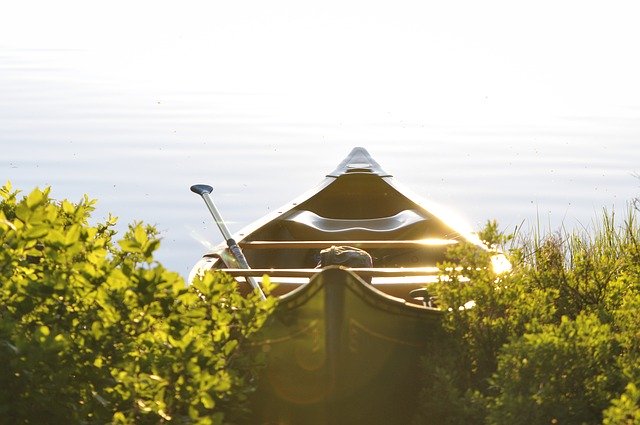
- Solo trips put you in total control of every aspect of the journey. Only you have a say in where you go and when you’ll leave, so coordinating is a non-issue.
- Loading and unloading is much easier with just your gear. Anyone who has ever packed for a trip with the whole family can tell you this.
- While on the trip, you alone create the schedule. If you change your mind about what you originally planned, no one else has to agree.
- Solo canoers often see more wildlife because there is less chatting and it is quieter. Nothing against my wonderful family, but I notice more, and enjoy the trip more when I travel alone by canoe or kayak.
- A solo canoe trip is a good time for relaxing, thinking, and reflecting. You can write, take photographs, and enjoy leaving work, social media, and the stresses of day-to-day life behind.
- Sometimes even the best canoeing buddies have different ways of doing things. When you are by yourself, you always get your own way. There is no pressure to be cordial or risk butting heads.
- If something goes wrong, you only have yourself to blame. These are often the best times to learn better techniques and planning strategies to make future trips better.
Now that we have established why you should take a solo canoe trip, let’s take a look at the right equipment for different adventures. I’ll also talk technique and share some tips I’ve learned from canoeing by myself.
Canoes for Solo Trips
Solo canoeing, more so than tandem excursions, really benefits from a lightweight and easy-to-carry canoe. In my experience you don’t need to buy a canoe that’s designed for solo travel, but it can make navigating and paddling easier if you have the means to do so.
If you’re going to use a tandem, two-seated canoe, then I recommend picking one made of lightweight materials . Kevlar is a good choice.
I also recommend sitting in the front seat of the canoe, facing in the opposite direction.
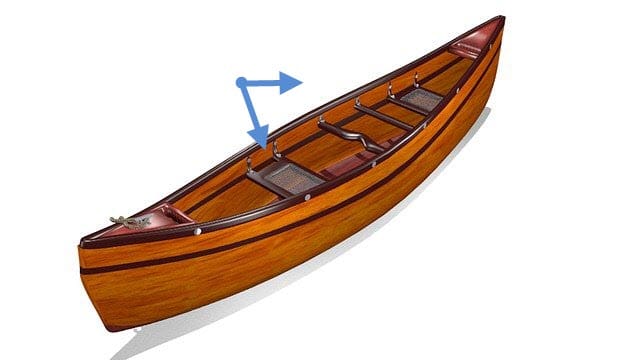
This places your weight closer to the center of the boat and will make it easier to paddle and control your boat. Place your gear and equipment in front of you, just your side of the rear seat to help balance the weight of your canoe. This also keeps your gear accessible.
Details below give an overview of two canoes for solo adventures that I like and recommend. Both happen to be made by Old Town.
Discovery 119 Solo Sportsman
Outdoor adventurists favor this canoe for many reasons, but its lightweight hybrid design is at the top of the list.
This canoe caters to the solo adventurist by weighing only 56 pounds and having convenient built-in carrying handles.
Made by Old Town, the Discovery 119 Solo Sportsman is considered a hybrid since it has the utility of a canoe and the agility of a kayak. This canoe even lends itself to be used with either a single-bladed or double-bladed paddle.
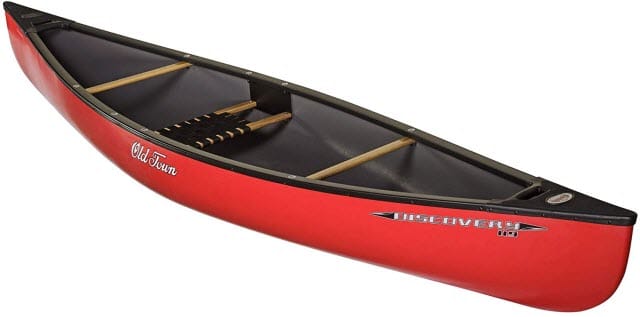
The Discovery 119 Solo Sportsman has a 3-layer hull construction with a lifetime warranty. The 3-layer design is stable, easy to control, and has a smooth ride. This canoe is also a favorite for its many conveniences. The Discovery 119 Solo Sportsman has a cup holder, shotgun ammo holder, tackle rod storage, and an accessory rack.
The Discovery 119 Solo Sportsman gets a thumbs-up on comfort too. It’s contoured and adjustable kayak-style seat and adjustable foot braces make changing positions quick and comfortable. Padded armrests are a nice feature as well, especially on longer trips.
Finally, the Discovery 119 Solo Sportsman has a spacious hull to hold all of your gear, leaving ample room for stretching your legs, and the seat is positioned perfectly for solo paddling canoe trips.
This canoe is 11″9″ long, 32.5″ wide, and 12.5″ deep. It has a weight capacity of 354 pounds. This is probably my favorite option for solo canoeing, and if you can’t find it locally you can order it on Amazon for around $1,000.
The Next 13 is also a hybrid canoe manufactured by Old Town. Resembling the Discovery 119 Solo Sportsman, the Next 13 has a 3-layer polyethylene hull which is durable and provides a stable, smooth, and easy-to-control ride. This model, however, has more pronounced tumblehome sides and a lower profile for easy paddling.
This canoe has a removable seat and a support-track foot brace system.
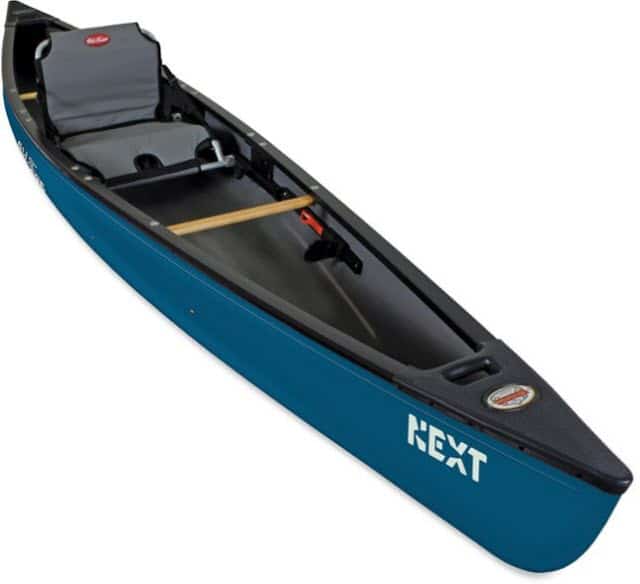
Its specs differ from the Discovery 119 Solo Sportsman at 13′ in length, 29″ wide, and 11.5″ deep, making the Next 13 longer and thinner. The Next 13 also has a flat bottom, whereas the Discovery 119 has a shallow arch bottom.
Both solo canoes are top-rated by experienced paddlers. The Next 13 can hold up to 450 pounds and costs just over $1000.
Full disclosure: I haven’t personally used the Next 13, and when I wrote this article, I haven’t been able to find it for sale online, so it may be discontinued. Your best bet may be to try to buy one locally … used if you can find one.
Paddles for Canoeing Solo
Choosing the right paddle for a solo canoe trip may be more important than choosing the right canoe. The paddle needs to be specific for the person and the activity, otherwise you’ll waste effort and tire faster.
For instance, you should choose your canoe paddle based on your height and seat position.
When canoeing with another person … if you sit in the bow, you want a paddle that measures from the floor to mid-chest when you are standing. However, if you sit in the stern, you will need more length. In this position, your paddle should reach from the floor to your collarbone.
For solo canoeing I recommend a longer paddle than you might traditionally use – one that comes to your collarbone.
Single or Double Paddle?
Now, you must consider whether you need a double or single paddle. Traditionalists will assume that a single bladed canoe paddle will be best, but that isn’t always true.
A double-bladed paddle like paddles traditionally used for kayaking will generally make your solo canoe trip less physically demanding because there is no pressure on your body when performing steering stokes.
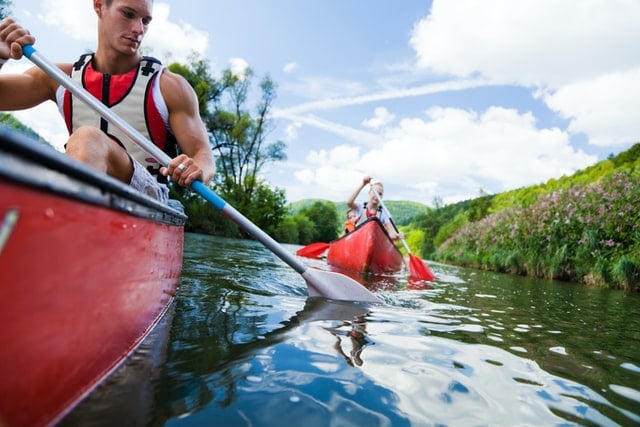
That said, most solo canoeists who prefer a double-bladed paddle also keep a single-bladed paddle in the canoe for tricky steering situations. This is what I recommend as well.
Reasons a Double Paddle Might Not Work
Although a double-bladed paddle will paddling your canoe easier on your muscles, you will have to endure much more water dripping because of the constant back and forth motion of the paddle. Water drips can be quite uncomfortable in the colder months.
In these times, waterproof pants and gloves are a must for comfort, or you could invest in some drip rings like these ones on Amazon to stop the water before it gets to you.
Can I Use a Kayak Paddle for Canoeing?
If you have a kayak paddle already, you might be thinking you can just use your double-bladed kayak paddle when canoeing solo.
I don’t recommend this.
Double-bladed canoe paddles look a lot like kayak paddles; however, a kayak paddle will often not be long enough for comfortable solo canoeing. Canoes sit higher in the water than kayaks; therefore, longer paddles are necessary to reach the water comfortably … which is the whole point of using a double bladed paddle in your canoe.
Paddle Shapes
Paddle shapes and materials must also be matched for your purpose or adventure when canoeing by yourself.
The three main types of paddles you could use are:
- Beavertail paddles are shorter and wider. These are more appropriate for flatwater trips sitting in the bow of the canoe.
- Ottertail paddles have a longer, more narrow blade used for river and lake canoeing while seated in the stern.
- Square-tipped paddles are big and wide, capable of moving a lot of water. This type of paddle is necessary for white water canoeing.
I prefer an ottertail paddle when canoeing by myself.
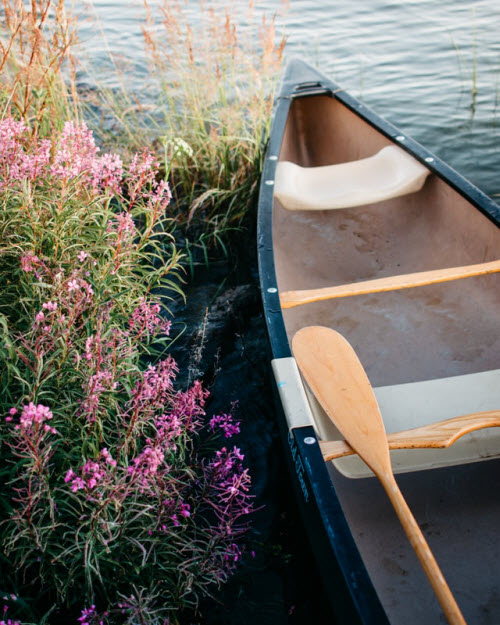
Paddle Materials
Most people think of a canoe paddle as being made of wood (and many are). However, synthetic paddles are popular with some people because they are incredibly durable, and may be lighter weight.
Most people like the look and feel of more traditional wooden paddles (I’m one of them), but some avid white water paddlers opt for the strength that synthetic paddles provide.
Recommended Equipment for Canoeing Solo
Whether your solo voyage is for a few hours or several days, the right equipment can make your solo canoe trip more comfortable (and more safe).
The following is a list of items I recommend that you consider for your safety, organization, and comfort on a short day trip.
Overnight trips will require additional items and camping gear.
- Life jacket (mandatory)
- Map and compass
- Insect repellent
- Sunglasses with a float-strap
- Kneeling pad
- Waterproof bag to hold essentials
- Hat for sun protection
- Signal device
- Floating throw rope
- Additional rope for towing
- Drinking water
- Food / snacks
The Life Jacket I Use and Recommend
In most states, wearing a life jacket or PFD is the law when you’re out on the water.
If you’re like me, you want a safe, effective PFD that doesn’t limit your range of movement when paddling. That’s why I highly recommend this one from Onyx .
It offers great range of motion, can keep me afloat in the water (I’m 6’2″), and it is very comfortable.
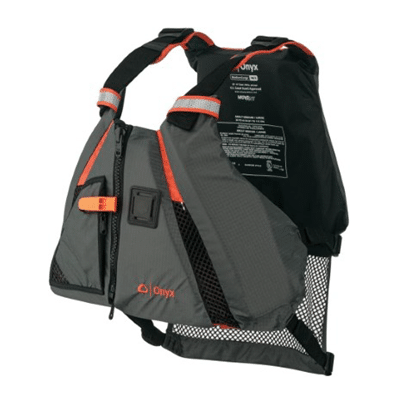
PeacefulPaddle.com is reader supported. If you make a purchase after clicking a link, I may earn a commission at no additional cost to you.
Where to Sit When Canoeing By Yourself
Solo canoe trips require slightly different positioning than tandem trips, and your paddling technique will be different as well.
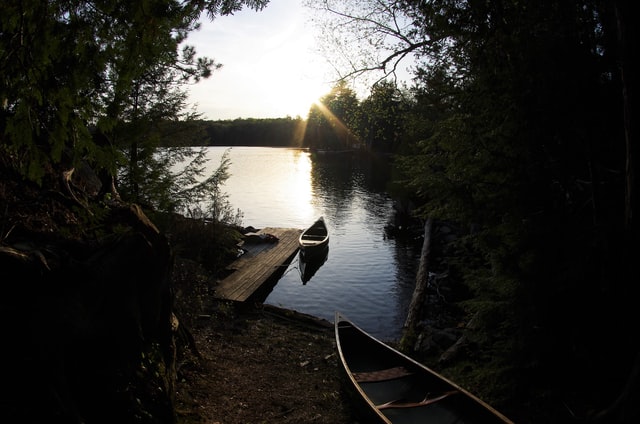
On a tandem canoe trip, one person sits in the stern (back) and controls the canoe’s direction, paddling occasionally. The person in the bow (front) controls the canoe’s speed and supplies the power.
However, on a solo trip, you need to decide if you will sit, kneel, heel, or use a combination of positions.
I’ll discuss each of them here:
On a solo trip, one of your choices is to sit backward on the front seat of the canoe as I discussed earlier. You’ll paddle the canoe in reverse, which doesn’t make much of a difference for most canoes.
This position might seem awkward, but it prevents the nose of the canoe from sticking up, keeping your weight as close to the center of the canoe as possible.
Sitting is the most comfortable position for long trips on calm water, where steering your canoe is not a big issue.
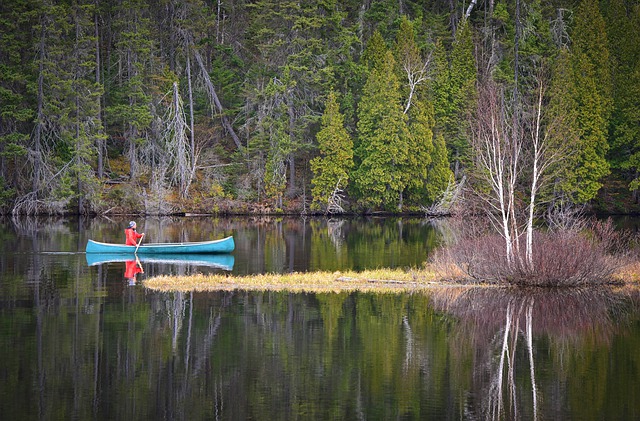
When paddling solo in rough water, you may want to try something else.
Many solo canoeists prefer to kneel. The kneeling position lowers your center of gravity in the craft, and keeps your body in a more upright position. This extra height creates more powerful strokes with added control.
Kneeling is also the preferred position when canoeing alone in strong wind. It will put extra power behind your strokes.
When kneeling, you will undoubtedly need padding on the canoe floor. You should also consider rolling up a towel and placing it between your calves and your backside to take the pressure off your knee joints.
While the kneeling position has its place in solo canoeing, it is a difficult position to maintain long-term, even for those who are very fit. Many canoeists switch their positions regularly for purpose and comfort.
Heeling is one last position or technique more experienced solo canoeists use.
In this position, you are kneeling near the center of the canoe with your body off-set to your paddling side. This position makes the canoe tilt more, but your center of gravity is low and stable.
Once you get used to the balance being different, heeling gives your strokes more strength and reach. This position also gives you excellent maneuverability. It’s the most challenging solo position to learn, but once you do, it may become your favorite.
This is a great video which showcases the heeling position in some excerpts from Becky Mason’s Advanced Classic Solo Canoeing film:
Other Things to Consider before Canoeing Solo
Solo canoe trips can be extremely rewarding adventures.
However, solo trips are not recommended for novice paddlers and those inexperienced in camping and traveling in the wilderness.
This doesn’t mean you have to be an expert to go solo in a canoe, but you will need to gather all the information you can in advance, and you may want to pack a little extra safety equipment.
Understanding the style of canoe and paddle you will need and how to position yourself in the boat is a great start, but for your first canoe trips, go with a friend or family member until you get more comfortable. It’s always safer to travel with someone else.
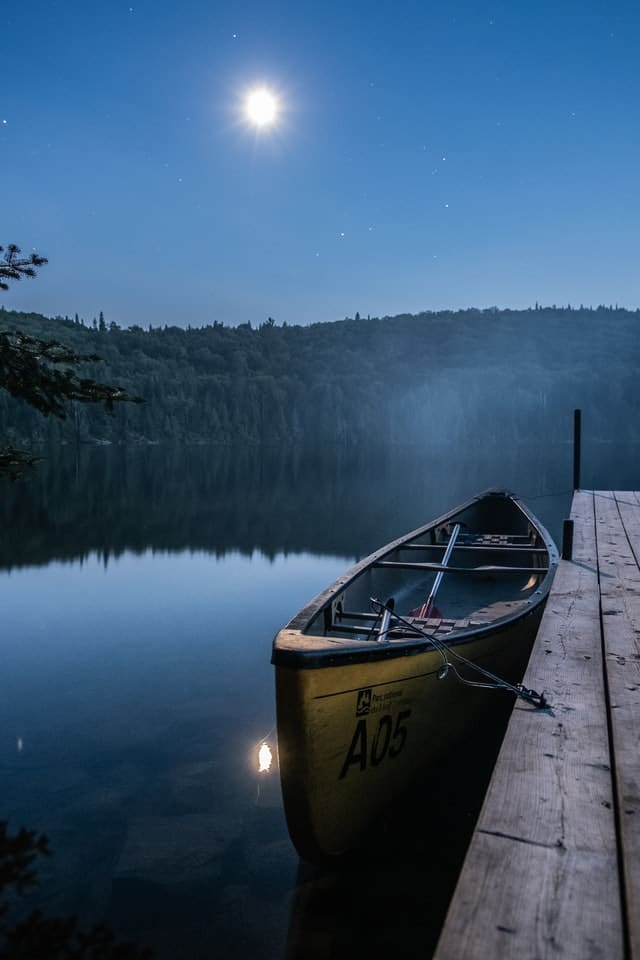
If you are just getting started with canoeing, educate yourself by reading articles like this one, and watching videos for tips from experienced canoers.
Also, you might consider hiring an outfitter who can show you the best equipment for your needs and sell it to you.
When you feel comfortable and equipped, get out on the water and enjoy a solo canoe day trip , and eventually you can graduate to longer adventures in your canoe.
You May Also Enjoy:
Privacy overview.


Win a Free Northern Ontario Gift Cooler
Share your thoughts on travel and enter to win a Northern Ontario gift cooler valued at over $2000!
- About Northern Ontario
- Canadian Canoe Culture
- Explore Indigenous Culture
- Group of Seven
- How to Fish
- Plan A Road Trip
- Plan Your Fall Trip
- Plan Your Summer Trip
- Plan Your Winter Trip
- Where to Eat
Algoma Country
Northeastern ontario.
- Sault Ste. Marie
- Sunset Country
- Superior Country
- Thunder Bay
- Motorcycle Touring
- Outdoor Adventures
- Snowmobiling
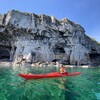
10 Easy Canoe Trips in Ontario
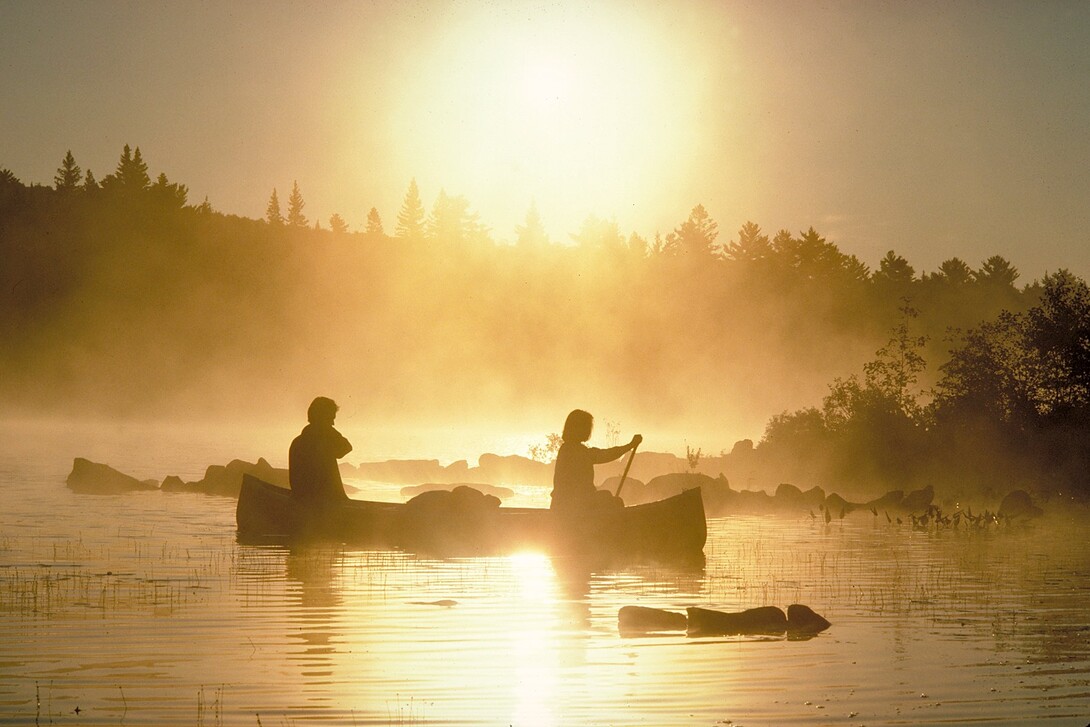
A canoe camping trip is the ultimate escape for a weekend or short getaway. Find solitude and discover the wonders of nature. It’s important to realize backcountry paddling (travelling by canoe and paddling to your campsite) is different from car camping. It requires specialized skills, preparation, respect and knowledge.
If you are a first-timer, we recommend you take a guided trip to gain valuable experience. Safety is the utmost priority in the wilderness.
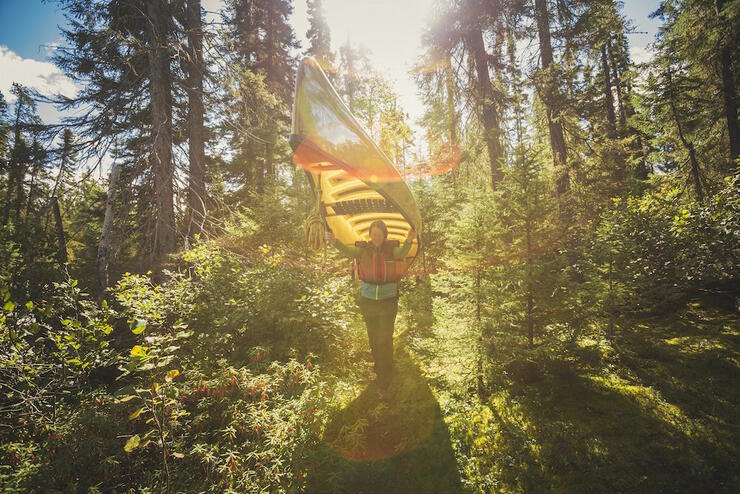
With the help of your knowledgeable guide, you’ll develop paddling, map-reading, weather-watching, portaging and backcountry camping skills. Plus you’ll enjoy hassle-free planning. Ultralight canoeing and camping equipment is supplied, plus delicious backcountry meals. Just book and go.
If you have acquired basic canoing and camping skills and want to explore on your own, check out the list of Ontario Parks below that offer beginner backcountry canoe camping routes. Local outfitters can get you geared up and help you plan your trip.
Easy 2-, 3- or 4-Day Beginner Guided Canoe Camping Trips—No Experience Required
Try one of these trips. It’ll be a great way to get your feet wet and learn how to safely enjoy a canoe trip.
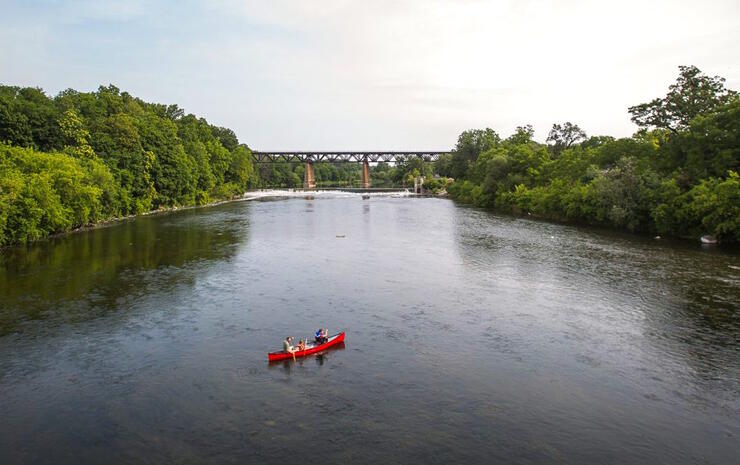
Grand River
Located in southern Ontario, within a one-hour drive from GTA, the 290-km Grand River and its major tributaries are the perfect waters for a beginner-friendly weekend canoe trip. Designated as a Canadian Heritage River in 1994, the Grand meanders past towns and winds its way through wetlands and rare Carolinian forests. See lots of birds and wildlife.
Paris to Brant Park Route (Very Easy)
Grand River Rafting offers the perfect introductory canoe trip . Start with a one-hour lesson, then set out on a scenic, leisurely 13-km paddle from the quaint town of Paris into a pristine wilderness. Highlights of this two- to four-hour trip include perfect swimming areas, natural spring water and picnic stops.
All canoeing equipment is provided. Add a river guide to learn more about the valley. Campsites are available at the end point. A variety of routes are available for more paddling adventures.
The Grand Canoe Camping Experience (Easy)
This fully outfitted two-day, two-night guided canoe camping trip with Grand Experiences makes it easy for you and your family to experience a safe and unforgettable adventure. Develop your canoeing and camping skills in the heart of southern Ontario’s largest nature region.
Trip includes a Paddle Canada-certified interpretive guide, all canoe and camping equipment, and shuttle rides. Check out their two-day Big Creek Eco-Adventure for more fun.
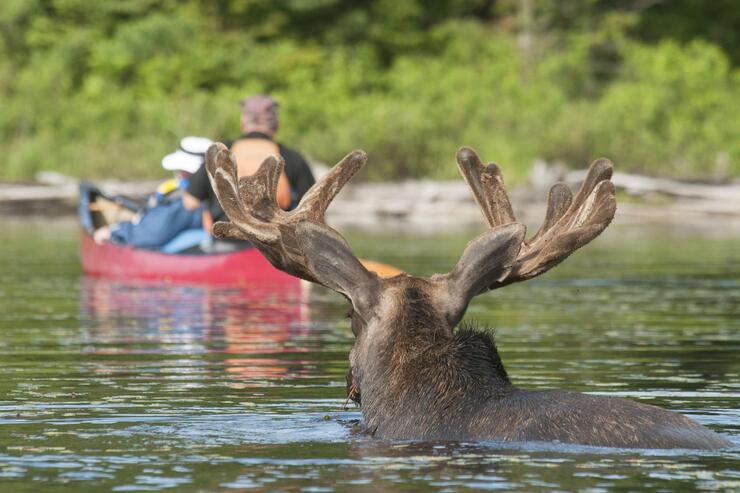
Algonquin Provincial Park
Known as one of the most beautiful and historic parks in Canada, Algonquin is a popular destination for canoeing, wildlife-viewing, hiking and outdoor adventures. Located an easy drive from Toronto and Ottawa, the park is a perfect choice for a beginner overnight canoe trip.
Classic 3-Day Algonquin Park Guided Canoe Trip (Easy Wilderness)
Voyageur Quest has created a perfect three-day beginner canoe trip for those who want a safe, easy and authentic wilderness experience in Algonquin Park. Your guide will help you develop your backcountry skills as you paddle and portage through beautiful lakes and rivers in Northwest Algonquin Park.
Sleep comfortably in top-quality tents. Feast on delicious meals cooked over a campfire. Trip includes all the canoe and camping equipment, park permits and meals. Available Monday to Wednesday or Friday to Sunday from June to September.
Guided Canoe Camping Trips Designed Just For You (Easy Wilderness)
Ideal for families or groups, a customized Algonquin Outfitters guided trip will teach you the basics of wilderness canoe tripping plus an extra level of comfort and safety to make your wilderness trip more enjoyable. Choose the Algonquin Outfitters guiding service that best suits your needs and budget.
- Greenhorn Service : If you need just a little help, this is a cost-effective option that will start your trip off right. A guide will go over the gear and lead you on a “mini-trip” to cover skills like camp setup, food storage, portaging and paddling.
- Guide for a Day : An experienced guide will travel with you on the first day of your canoe trip. Learn basic paddling strokes, portaging techniques, navigation, campsite selection and setup. Once you are safely on your first campsite with dinner cooking, the guide will depart, allowing you to finish the trip on your own.
- Custom-Designed Guided Trip: This guided trip allows the first-timer to comfortably experience a true backcountry wilderness trip that meets your expectations, experience, abilities and interests.
Customized Learning Canoe Trips For Adults, Youth and Families (Easy Wilderness)
Paddlefoot excels in organizing and guiding safe customized learning canoe trips for beginners to experts. They provide all the canoeing and camping gear and delicious meals. They will plan a route that suits your skill level and will teach you about the wonders of nature that you experience along the way.
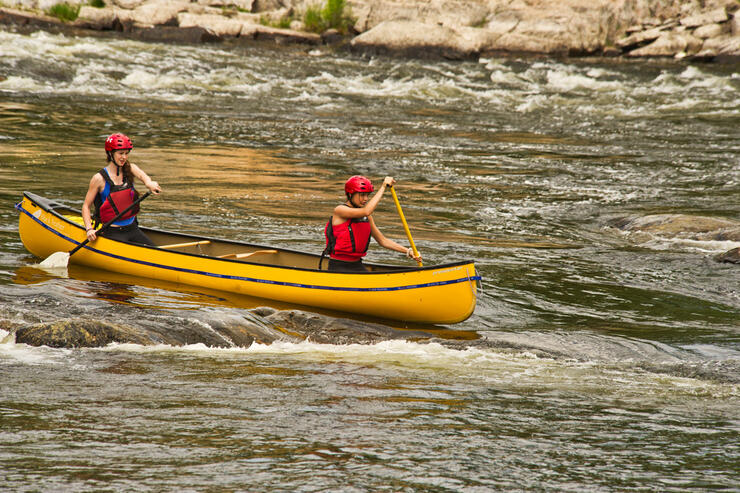
French River
The French River , part of Ontario Parks, was designated a Canadian Heritage River in recognition of its natural and historical value. Paddle the route of Indigenous people, French Explorers, fur traders and voyageurs. Learn more at the award-winning French River Visitor Centre with its “Voices of the River” exhibit.
Beginner Canoe Trip for Families (Easy Wilderness Whitewater)
Black Feather offers exceptional wilderness holidays for families with lots of opportunity to learn and practice new whitewater canoeing skills on this fun, four-day canoe camping trip. Camp each evening at a new site, dine on exceptional meals and share stories about the day’s adventures. Enjoy swimming and exploring this beautiful natural setting.
Introductory Whitewater Canoe Trip (Easy Wilderness Whitewater)
With some fun and fairly easy rapids, there are lots of opportunities to learn and practice whitewater canoeing skills on this fun four-day canoe camping trip with Black Feather.
Starting at Wolseley Bay, you’ll paddle the most scenic section of the French River. There’s lots of time for photography, swimming, sharing laughs and enjoying gourmet campfire meals. A Women-Only Adventure is also available.
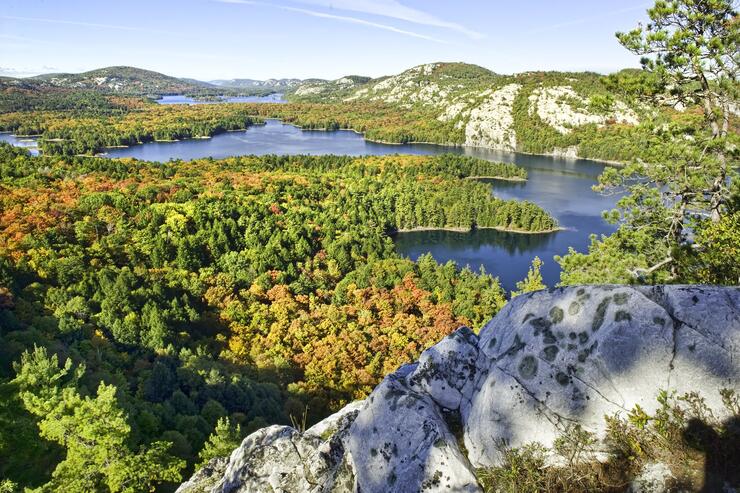
Killarney Provincial Park
Killarney ’s iconic landscape captivated artists including The Group of Seven. The La Cloche Mountains’ white quartzite ridges and over 50 clear, sapphire lakes surrounded by Jack pine hills is like no other place in the world.
3-Day Canoe/Hiking Trip (Easy/Moderate Wilderness)
Leave the city behind and join Overhang Adventures for a memorable three-day canoe/hiking trip . After a quick canoe lesson, you’ll start paddling on spectacular Bell Lake. Your expert guide will teach you backcountry camping skills before being wowed by millions of stars.
After a short paddle, you’ll hike to the top of Silver Peak to enjoy stunning views before returning to your campsite.
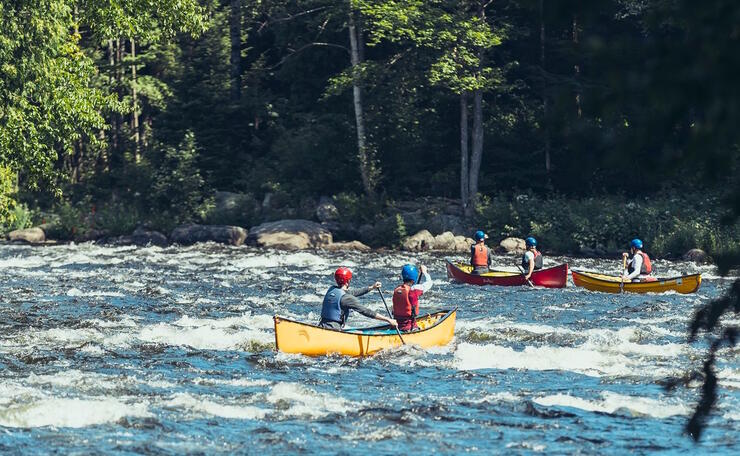
Madawaska River
The Madawaska River is celebrated as one of the best places in North America to learn whitewater paddling. Rapids range from a gentle class I to a splashy class III.
Weekend Whitewater Learning Vacation (Easy Whitewater)
Madawaska Kanu Centre offers an excellent introduction to the exciting world of whitewater paddling for adults and whole families. Learn the basic strokes and boat control on flatwater, then use your knowledge on easy current in the afternoon. By day two, you’ll be paddling up to class II rapids. A variety of camping and accommodations is available.
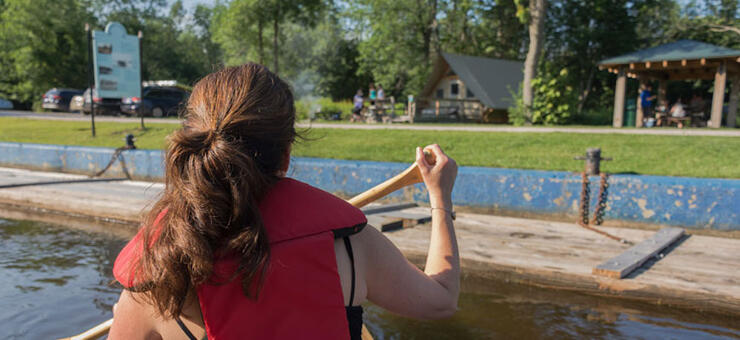
Rideau Canal
The Rideau Canal is a 202-km-long scenic waterway running from Kingston to Ottawa. It is a National Historic Site of Canada, a Canadian Heritage River and a UNESCO World Heritage Site. Maintained by Parks Canada, it is one of the most scenic and historic waterways in North America.
Beveridges Locks Overnight Canoe Trip (Easy Heritage)
Get fully geared up with Perth Outfitters and launch from their docks on the Tay River. Paddle through the renowned Tay Marsh to the Beveridges locks. Go through the locks and explore the lower Rideau Lake. Camp overnight in a Parks Canada unique accommodation called oTENTik , a cross between a tent and a cabin. Paddle back the next day.

Ontario Parks Backcountry for Beginners—Some Experience Required
If you have learned the basic skills for wilderness canoe tripping and now want to explore on your own for a weekend getaway or longer trip, these Ontario Parks offer incredible beginner-level backcountry paddling experiences. Learn about safety and etiquette .
Northwest Ontario
Neys – Located on the shore of Lake Superior, enjoy an incredible sand beach.
Fushimi Lake – Offers exceptional fishing and wildlife viewing.
Wakami Lake – Paddle through boreal forest with old-growth white pine.
Esker Lakes – Explore dozens of kettle lakes, formed when glaciers retreated 10,000 years ago. Enjoy great bird-watching.
Halfway Lake – See bald eagles and great blue herons on the Two Narrows Canoe Route.
Killarney – Paddle this iconic park, known for its beautiful quartzite mountains and sapphire lakes.
Mississagi – Paddle and portage through a rugged landscape of ancient hills and sparkling waters.
Restoule – Explore the pristine waters at the base of a 100-metre-high bluff.
Explorers’ Edge
Algonquin Park – Paddle the painted landscape, made famous by Tom Thomson.
Grundy Lake – A short five- to 20-minute paddle will get you to your backcountry campsite.
The Massasauga – offers 135 backcountry campsites accessible by water only.
Southeastern Ontario
Charleston Lake Provincial Park - With 10 interior campsites, it’s a perfect place to develop your backcountry canoe camping skills.
Ontario’s Highlands
Bon Echo – See one of Canada’s largest visible collections of Aboriginal Pictographs.
Murphys Point – Paddle five to 45 minutes to access a backcountry campsite on Big Rideau Lake.
Kawarthas Northumberland
Kawartha Highlands – Explore the largest park south of Algonquin. Enjoy solitude, tranquility, wilderness and dark night skies.
If you are new to canoe tripping or just looking for a quick, hassle-free weekend adventure, it’s easy to explore Ontario’s beautiful landscapes with a two- or three-day guided canoe trip. Just pick your trip, book and go paddling.
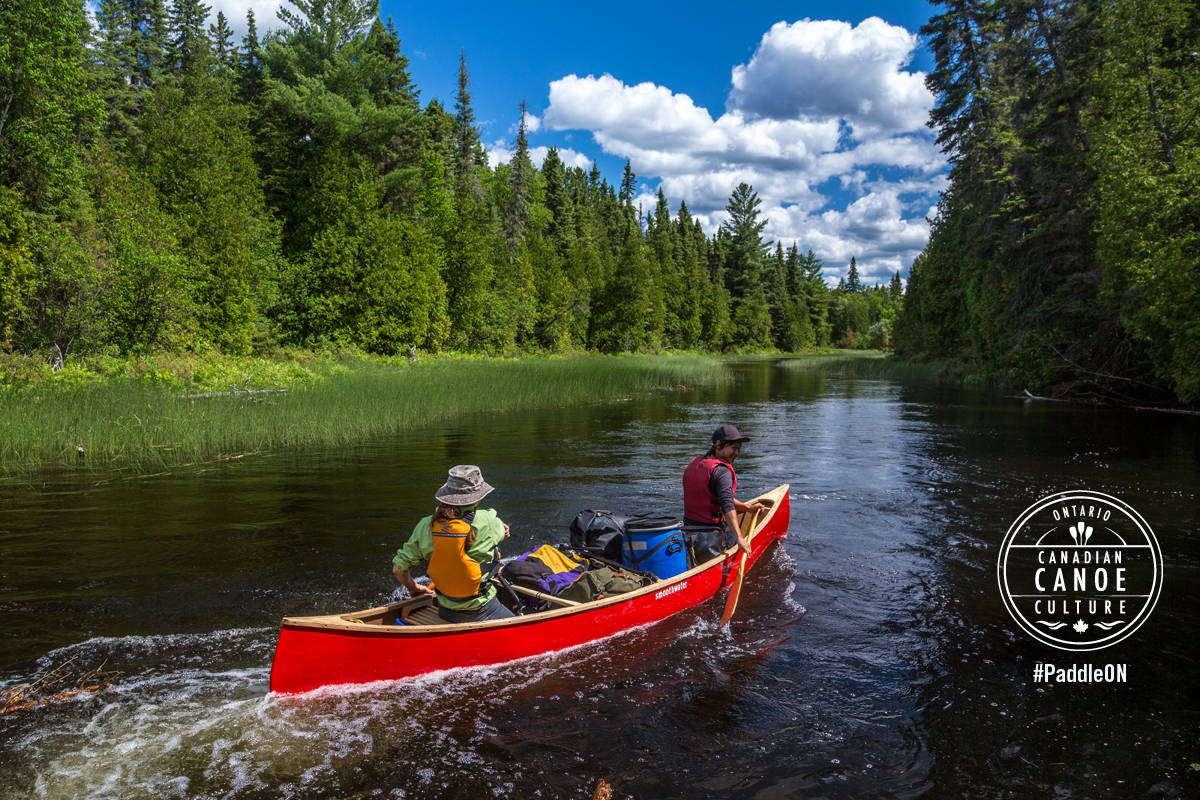
Find Great Paddling Adventures
Showing 'edited body' is no longer supported..
Trish Manning is an adventure travel writer and the content coordinator for Ontario Outdoor Adventures. She is an avid outdoor person who loves to hike, paddle, SUP, snowshoe, cross-country ski and explore Ontario's great outdoors with her golden retriever, Daisy.
Recommended Articles
Ontario’s blue-water lakes, best canoe maps in ontario, it's time for a paddle, paddling laws, easy river tripping, best river canoe trips, kayak & canoe sudbury, ontario’s moose hotspots, 9 best day trips by canoe and kayak, paddle the lakehead, paddling in lady evelyn smoothwater, best lakes for paddling, more savage than the nahanni, missinaibi river canoe trip, breathtaking views, best family canoe trips, temagami canoe trip routes, killarney canoe trips, best sites on the french river, explore ontario by paddleboard.
Canoe, kayak and SUP rentals return to St. Pat's park after pandemic hiatus

At long last — well, since COVID-19 swept across the land four years ago — canoe, kayak and stand-up paddleboard rentals will return to St. Patrick’s County Park and a stretch of the St. Joseph River from South Bend to Niles.
Starting this Memorial Day weekend, familiar trips and schedules come back to this watery Eden. The hiatus had begun in 2020 when there were real concerns about shuttling paddlers together in a park van between their finish and launch sites. It evolved into regular rentals on the river’s Baugo Bay in Osceola, a convenient and efficient option that never needed a shuttle — you just paddle out and back within the bay area.
The paddling public, though, missed the classic, linear trips out of St. Pat’s, the chance to cover miles of the St. Joe, to feel its current push their boat forward, to see the day’s surprising sights (there’s always something). So, as pandemic precautions waned, paddlers pleaded for rentals to return to St. Pat’s every season.
St. Joseph County Parks leadership apparently heard them. But the parks needed enough seasonal staff to make it possible.
Michael Slattery, who started last August as the parks’ leisure services manager, said his directors “felt strongly” about the move back to St. Pat’s. So, voila.
Need a break? Play the USA TODAY Daily Crossword Puzzle.
As something new, the park will offer “early bird” paddles on the second Saturday of each month this summer — so, June 8, July 13 and Aug. 10. You’ll need to hop in the shuttle van by 7:30 a.m. for a trip from Keller Park to St. Pat’s. These must be reserved in advance. The deadline is May 29 for the June 8 paddle. Cost is $20-$25.
Think of the soft early-morning light, more bird life and escape from the hottest parts of the day.
This coincides with early-bird hours that park management is trying on those second Saturdays, when St. Pat’s opens at 7 a.m. Slattery says 25 people came in the first three hours of May’s trial run — lots of hikers and dog walkers. Gate fees don’t begin until 10 a.m.
Also, kayak rentals will resurface on periodic evenings at Ferrettie-Baugo Creek County Park in Osceola. They’re scheduled from 6 to 8 p.m. on June 5, July 17 and Aug. 7.
The staff will have to transport kayaks to the park for those events. And on a regular basis, Slattery adds, “We don’t have the staff to do (rentals at) both (park) sites.”
Still, he says staff will track the numbers and listen for your feedback on whether or how often to continue with the Ferrettie-Baugo paddles. Staff have considered a self-serve kayak kiosk there like the one at South Bend’s Pinhook Park, but, so far, Slattery says, they don’t feel encouraged to try it just yet.
You could argue that St. Joe River begs for more canoe and kayak rentals on other stretches. It is wilderness that just so happens to pass through urban populations. The river and its tributaries have boasted more than 85 species of fish in recent years, a healthy count, indeed. Crows, warblers and other fowl use the river to navigate as great blue heron, osprey and eagles now live near it.
Margaret Easton, who runs the popular Facebook group Paddle Michiana, aptly describes the portion where rentals return.
“Once you get started, you’d have no notion that you’re just minutes from one of the biggest cities in Indiana,” she says. “It’s a great escape.”
∎ Paddling rentals at St. Pat’s: Rentals at St. Patrick’s County Park , 50651 Laurel Road, South Bend, will run from May 24 to Oct. 6. Also, there will be Saturday-only paddles on Oct. 12, 19 and 26 from Keller Park to St. Pat’s. The standard short trips are four to six miles, either from Keller Park to St. Pat’s or from St. Pat’s to the Niles dam. The long trip of 10 miles is from Keller Park to the Niles dam. The park may cancel trips because of inclement weather or if the river is too high — specifically, if the flow is more than 6,000 cubic feet per second as measured at the Niles dam. You can check out boats from 11 a.m. to 4 p.m. Fridays through Sundays and on holidays. Long trip rentals must be checked out by 2 p.m. Group rentals are available Wednesdays through Sundays.
Not ready for the river? You can use the boats to practice paddling skills on a St. Pat’s pond for $7 per hour.
Costs for the short trips are $25 for single kayaks and $30 for double kayaks or canoes. For the long trips, costs are $35 for single kayaks and $40 for double kayaks or canoes. Stand-up paddleboards cost $25 and are only available Saturdays and Sundays on the short trips. All rentals include life vests and shuttles.
If you have your own boat, you can book the shuttle for $12.
For questions and reservations, call 574-654-3155. For more details on rentals, visit a parks link here in this column online.
More paddling please
∎ Other paddling outfitters on the St. Joe River: Coyne Kayaks in the Bristol area; call 574-536-8889. RAW Outdoors Canoe & Kayak Rentals in Goshen, which does rentals anywhere on the St. Joe, along with Elkhart River and other rivers; call 574-322-0573.
∎ Rafting on the East Race Waterway in South Bend runs on Saturdays and Sundays from noon to 5 p.m. June 1 to Sept. 1 through the city’s Venues, Parks & Arts department.
∎ The East Race Whitewater Festival comes back for racing and a pool floatie run from June 7-9.
∎ Checklist: Got everything you need to take your kayak or canoe on the water? How about a whistle, a mugshot of your boat and a safety plan? Review a pretty thorough checklist I wrote in 2021, thanks to help from Coast Guard volunteers and other experts, which I’ve linked to here in this column online.
Paddling for wildlife
What wild critter did you see on a paddling trip that made your head spin with delight? If it’s an eagle, an otter or one of 10 other animals on a list, the Indiana’s Department of Natural Resources is asking us paddlers to file a quick report.
The DNR seeks volunteers for this bit of citizen science from June 1 to July 31 on Indiana waterways. The information you report to the Indiana Paddlecraft Wildlife Index will help the DNR’s wildlife managers to monitor changes in key species over time and perhaps to learn about new places where they’re living.
You simply fill out a postcard to record the number of the following species seen on a given trip: bald eagle, Blanding’s turtle, beaver, great blue heron, great egret, kingfisher, mink, muskrat, osprey, painted turtle, red eared slider and river otter.
Sign up at on.IN.gov/Paddlecraftindex .
Sweet wanders
∎ Potawatomi hike: Hoosier Hikers will host 5K and 10K Volksmarch hikes that you can start anytime between 9 a.m. and 1 p.m. May 25 near the nature center at Potawatomi Wildlife Park near Bourbon. The park is at 16998 Indiana 331, a half mile south of Indiana 10. It costs $4 to register. Donations for the park will be collected in memory of long-time hiker Susan Cameron and park managers Sharon and Michael Stephan. For questions, contact Bob Buzolich at 574-339-9140 or [email protected] .
∎ Holiday pancakes in a sanctuary: The South Bend-Elkhart Audubon Society will serve pancakes from 7:30 to 10 a.m. May 27 (Memorial Day) at its wildlife sanctuary, 59395 Clover Road, Mishawaka, south of George Wilson Park. Bring your own eating utensils if you can. Donations accepted.
Find columnist Joseph Dits on Facebook at SBTOutdoorAdventures or 574-235-6158 or [email protected] .
- Majorca Tourism
- Majorca Hotels
- Majorca Bed and Breakfast
- Majorca Vacation Rentals
- Flights to Majorca
- Majorca Restaurants
- Things to Do in Majorca
- Majorca Travel Forum
- Majorca Photos
- Majorca Map
- All Majorca Hotels
- Majorca Hotel Deals
- Last Minute Hotels in Majorca
- Things to Do
- Restaurants
- Vacation Rentals
- Travel Stories
- Rental Cars
- Add a Place
- Travel Forum
- Travelers' Choice
- Help Center
Best options for snorkel, sail and kayak - Majorca Forum
- Europe
- Spain
- Balearic Islands
- Majorca
Best options for snorkel, sail and kayak
- United States Forums
- Europe Forums
- Canada Forums
- Asia Forums
- Central America Forums
- Africa Forums
- Caribbean Forums
- Mexico Forums
- South Pacific Forums
- South America Forums
- Middle East Forums
- Honeymoons and Romance
- Business Travel
- Train Travel
- Traveling With Disabilities
- Tripadvisor Support
- Solo Travel
- Bargain Travel
- Timeshares / Vacation Rentals
- Balearic Islands forums
- Majorca forum

- Protests 7:43 pm
- Hotels with ballrooms 7:14 pm
- Day Trip 6:43 pm
- Music Bars 6:31 pm
- Boat excursions 6:15 pm
- Things to do for adult with sea sickness 5:25 pm
- Beautiful restaurant in Palma 5:21 pm
- Playa de Palma Holiday? 5:05 pm
- late night bus 4:29 pm
- bus portocolom to cala d'or 2:04 pm
- All inclusive or not 1:49 pm
- Things to do with a 4yr old in Cala Dor, Majorca 1:03 pm
- Chiringuito Magaluf Beach 11:03 am
- travel pass 10:30 am
- Best Resorts in Majorca 7 replies
- Ferry from Mallorca to Ibiza 3 replies
- weather in Early May 8 replies
- Which part of majorca would suit us best? 4 replies
- Honeymoon in Mallorca 11 replies
- Where to go in Majorca 7 replies
- Quiet Resort? 29 replies
- Snorkelling? 3 replies
- Where's the best place to stay in Majoca? 2 replies
- Best Quiet beaches in Majorca 4 replies
Majorca Hotels and Places to Stay
- Face mask / Covid-19
- Car Hire at Mallorca Airport
- Avoiding villa rental scams
- Let me in on a secret - Mallorcan Hidden Gems!
- Mallorcan Hidden Gems - part II
- Where can I find info on Mallorca's beaches?
- Traveling with a baby.
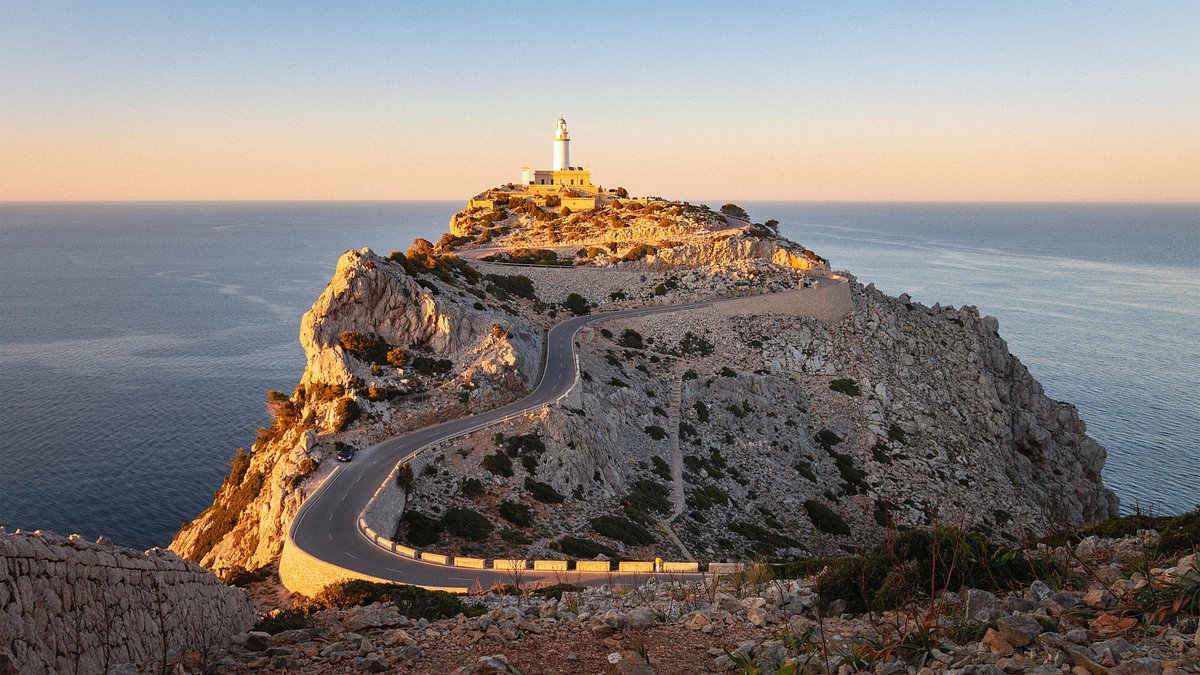
Watch CBS News
TSA sets new record for number of travelers screened in a single day
By Lucia Suarez Sang
Updated on: May 25, 2024 / 8:10 PM EDT / CBS News
The Transportation Security Administration announced it screened more than 2.95 million airline passengers on Friday, setting a new record for a single day.
In a post on X, formerly known as Twitter, the agency said Saturday that it screened 2,951,163 individuals at airport checkpoints nationwide on Friday, surpassing the previous record of 2,907,378 set on the Sunday after Thanksgiving last year.
"If you flew yesterday, congratulations, you were part of a record-setting day!" said Lisa Farbstein, a spokesperson for the TSA, in a separate post.

Ahead of the start of Memorial Day weekend, the TSA predicted that Friday would be the busiest day for air travel, with nearly 3 million people expected to pass through airport checkpoints.
TSA screened just under 2.9 million people Thursday, coming within about 11,000 from the previous record. Five of the 10 busiest-ever travel days have been since May 16, the agency said.
Memorial Day weekend travel is also expected to break records on the roads.
The American Automobile Association, or AAA, warned of potentially unprecedented congestion on roads this weekend, along with airports that could be even more crowded than in years past. The organization, which looks at various economic factors and partners with other groups to project travel conditions, announced earlier this month that an estimated 43.8 million people across the United States would likely travel at least 50 miles from Thursday to Monday. That would mark a 4% increase in overall travel compared with 2023, according to AAA.
"We haven't seen Memorial Day weekend travel numbers like these in almost 20 years," said Paula Twidale, the senior vice president of the travel division at AAA, in a statement. "We're projecting an additional one million travelers this holiday weekend compared to 2019, which not only means we're exceeding pre-pandemic levels but also signals a very busy summer travel season ahead."
Emily Mae Czachor also contributed to this report.
Lucia Suarez Sang is an associate managing editor at CBSNews.com. Previously, Lucia was the director of digital content at FOX61 News in Connecticut and has previously written for outlets including FoxNews.com, Fox News Latino and the Rutland Herald.
More from CBS News

How new technology is transforming airport security, efficiency

Mayorkas says some migrants "try to game" the U.S. asylum system

Spirit Airlines passengers told to put on life vests: "Nerve racking"

Person dies after falling into engine of departing passenger jet

IMAGES
VIDEO
COMMENTS
3. Northern Forest Canoe Trail, New York to Maine. This 740-mile trail starts in New York and ends in Maine, passing through Vermont, Quebec, and New Hampshire along the way. While there's ...
10. The Bowron Lakes Circuit, British Columbia. Paddle along the western slopes of the Cariboo Mountain Range in Bowron Lake Provincial Park. The Bowron Lake Canoe Circuit is world-renowned among ...
Other awards we've won include Best Feature from both the Caribbean Tourism Organization and the Magazine Association of the Southeast. Check out our expert picks for the 10 Best Canoe Trips For Your World Travel Bucket List, including the Florida Everglades, the Belize Barrier Reef, Botswana's Okavango Delta, South America's Amazon River, the ...
The Northern Forest Canoe Trail (NFCT) is the longest inland water trail in the country, running 700 miles from the Adirondacks in Old Forge, New York, to northern Maine — and encompassing 23 rivers and streams. Established in 2006, it follows waterways used for travel centuries ago by Native Americans and settlers.
Chattooga River, Georgia. Loxahatchee River, Florida. Noatak River, Alaska. Tuolumne River, California. Buffalo River, Arkansas. Master Paddling a Canoe. How to Pack a Canoe. How to Read a River. Congress established National Wild and Scenic Rivers in 1968.
O nce a thoroughfare for French fur traders who traveled thousands of miles by canoe each summer, the interior of Voyageurs National Park in northernmost Minnesota remains accessible only by watercraft. Nearly 40 percent of this unique national park's 218,000 acres is comprised of lakes and rivers, dotted with around 500 granite islands. Four vast interconnected lakes sprawl 56 miles along ...
Best 7-day Boundary Waters canoe trip Sawbill Southern Boundary. Starting from the Sawbill Trail at entry point 50, this epic 62-mile Boundary Waters canoe route has 52 portages. Don't let that dissuade you. Choose a lightweight canoe and pack carefully to reap the rewards of secret lakes and great wildlife viewing opportunities in the remote ...
Every Wilderness Inquiry trip ensures your adventure is the best it can be. Decades of experience in combination with top notch food and gear make Wilderness Inquiry BWCA trips an exceptional value. Our classic 5-day Boundary Waters Canoe Area Paddle Adventure is the quintessential guided canoe trip. Paddle lightweight Wenonah kevlar canoes and ...
Known as the crown jewel of the North Atlantic coast, Acadia National Park has 4 million visitors annually and is a stunning, natural beauty. With 60 miles of shoreline, Acadia National Park is a great location to get out onto the water for a canoe trip. Getting out on the water In Acadia will allow you to take in more views, faster.
How to Plan a (Successful) Canoe Trip. "The way of a canoe is the way of the wilderness, and of a freedom almost forgotten. It is an antidote to insecurity, the open door to waterways of ages past, and a way of life with profound and abiding satisfactions. When a man is part of his canoe, he is part of all that canoes have ever known.".
W hile canoe trips are about enjoying the great outdoors, exploring the wilderness and challenging yourself, packing the necessary gear makes it all possible.. Before you head to the put-in, run carefully through our canoe trip packing list to make sure you have the essentials covered. We have broken things down into kitchen, gear, and safety items and added some of our expert advice along the ...
By Corey Kilgannon. Dec. 17, 2021. A man in a red canoe paddled down the Hudson River, over ferry wakes and past the skyscrapers of downtown Manhattan and into Upper New York Bay. The canoeist ...
The average cost is half of the listed trip price. . . We are located on Route 62, 40 yards south of the Tionesta Bridge For information or to talk to someone directly, call 814-755-3658 . Our mailing address is: 247 Outback Adventures Road, Tionesta, PA 16353. Our E-mail address is: [email protected].
What Is Canoe Camping Called? Canoe camping can be called "canoe tripping" or "canoe" touring. All three phrases convey the combination of traveling and camping by canoe. These trips usually involve multiple days and nights in the wilderness.
Mountain River. The reason Mountain River is on this bucket list is because it's the favourite of the guides at Canoe North Adventures, praised for its seclusion and amazing whitewater. These guides get to paddle a lot of different arctic rivers, so if it's their favourite, it's definitely on my list. Mountain River takes you through six ...
August 05, 2025 - August 14, 2025. Noatak Canoe. $8,900. August 20, 2025- August 27, 2025. Alatna River Canoe. $7,300/ person. Arctic Wild provides professionally guided wilderness trips in Alaska's Arctic and beyond. Book your next adventure with us today for an unforgettable, life-changing experience. Reservation Request.
Kayaking is an exciting way to explore the natural beauty of the United States. With its diverse landscapes, the country offers many unique kayaking destinations for adventure seekers.
This outfitter is located on the doorstep of Woodland Caribou Provincial Park in Red Lake, Ontario. Goldseekers Canoe Outfitting offers full- and partial outfitting, including canoe and equipment rentals, route planning advice, shuttles, and guided trips. Goldseekers also maintains the Paddle Inn B&B.
Paddling Essentials. Paddling a canoe resembles conducting an orchestra, where each stroke is a note and the paddle is your baton. However, orchestrating a successful canoe trip requires more than a decent paddle. Essential paddling equipment includes life jackets, spare paddles, and even a trusty fanny pack for those little extras.
Your canoe trip may involve hikes and portages to get to your campsite.Therefore, you need to bring a large bag that you can fill with essential canoe trip items, such as sleeping bags, a tent, equipment, and emergency items.. Ideally, you want a large rucksack that has padded shoulder straps for comfort.. Many portages, such as those around Lake Magnetawan, involve hiking for over 1km ...
Save money on airfare by searching for cheap flight tickets on KAYAK. KAYAK searches for flight deals on hundreds of airline tickets sites to help you find the cheapest flights. Whether you are looking for a last minute flight or a cheap plane ticket for a later date, you can find the best deals faster at KAYAK. New York Flights.
Tippecanoe has a 5-mile and 10-mile trip along the Great Miami River, and kids need to be at least 7 to canoe, kayak or raft. Pricing range between $35 to $40 depending on the type of boat and day ...
One look at a map reveals the great potential of northeastern Ontario's Lake Temagami for an extended no-portage canoe trip. Temagami's namesake lake is sprawling, with hundreds of kilometres of shoreline to explore. The Central Lake Temagami Access Road is your best starting point, providing good long-term parking and direct access to the ...
Finally, the Discovery 119 Solo Sportsman has a spacious hull to hold all of your gear, leaving ample room for stretching your legs, and the seat is positioned perfectly for solo paddling canoe trips. This canoe is 11″9″ long, 32.5″ wide, and 12.5″ deep. It has a weight capacity of 354 pounds.
A canoe camping trip is the ultimate escape for a weekend or short getaway. Find solitude and discover the wonders of nature. It's important to realize backcountry paddling (travelling by canoe and paddling to your campsite) is different from car camping. It requires specialized skills, preparation, respect and knowledge.
My first solo canoe trip of 2024, took place at the start of May on Cat Lake in the Haliburton Highlands Water Trails. May Long weekend was coming up fast, ...
Long trip rentals must be checked out by 2 p.m. Group rentals are available Wednesdays through Sundays. ... call 574-536-8889. RAW Outdoors Canoe & Kayak Rentals in Goshen, which does rentals ...
On our list of things to do is a snorkel trip, a sail boat trip and possibly a kayak trip. I am thinking of planning two separate half-day excursions to cover these (e.g. one sail and one kayak tour) and am thinking we'd like to plan to depart from two different areas (e.g. port de soller and Allucida) in order to get to also spend time in ...
TSA screened just under 2.9 million people Thursday, coming within about 11,000 from the previous record. Five of the 10 busiest-ever travel days have been since May 16, the agency said.
Zillow has 40 photos of this $309,990 3 beds, 3 baths, 1,840 Square Feet townhouse home located at 2711 Silver Canoe Dr, Edgewater, FL 32141 built in 2024. MLS #O6202992.